The best times to visit Cambodia for temple trips, beach days and more
Mar 24, 2022 • 7 min read
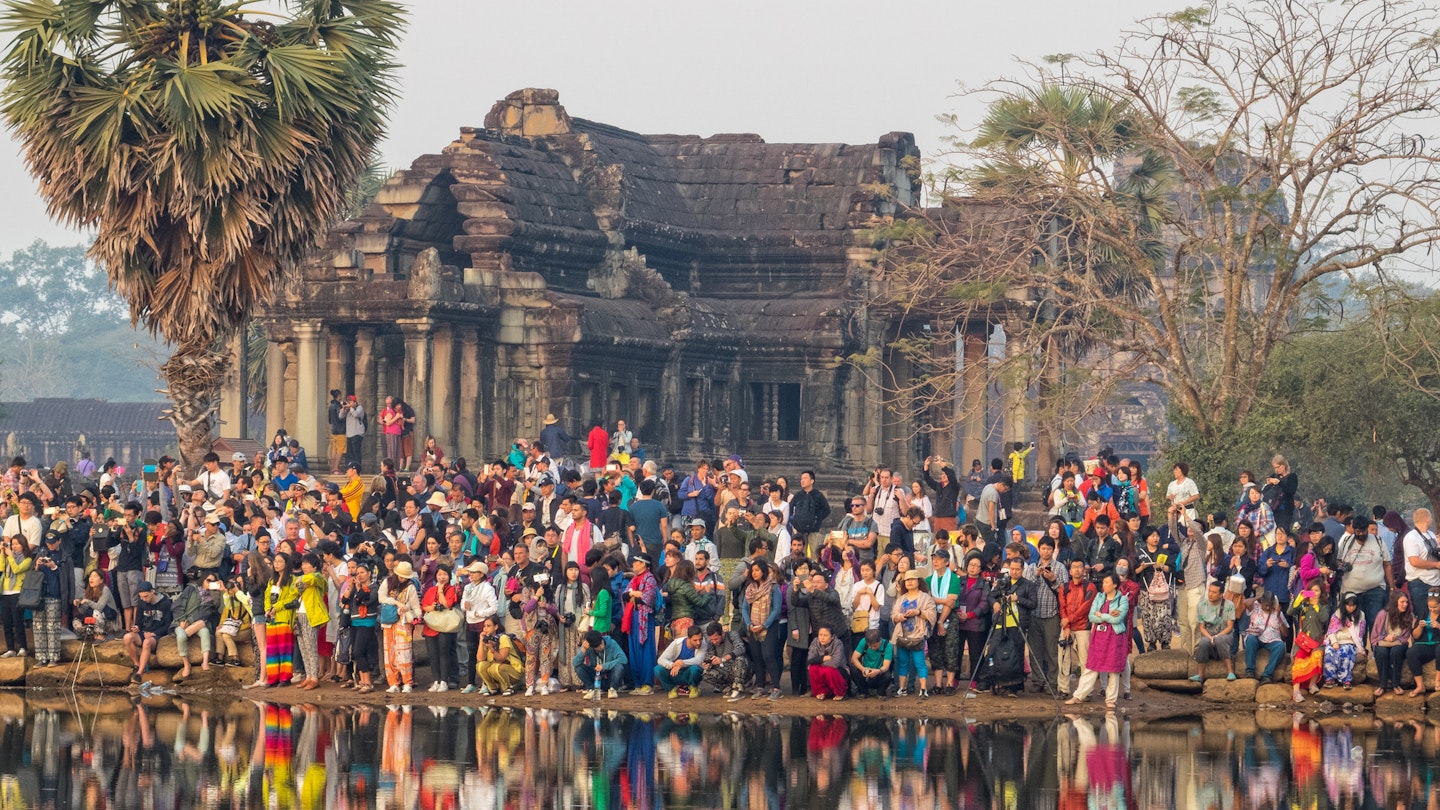
High season draws huge crowds for iconic photo opportunities like sunrise at Angkor Wat © Ikonya / Getty Images
Some Cambodians wryly observe that Cambodia has three seasons – hot, hotter and hottest – but in reality, there are distinct dry and wet seasons that define the harvest cycle and dramatically alter the character of the landscape in this fascinating Southeast Asian nation.
The dry season runs from November to May, and the "cool season" months of November to February are the most popular time to visit Cambodia due to milder temperatures. The countryside appears somewhat parched from February to May when daytime temperatures can soar above 40°C (104°F ).
The wet season usually runs from June to October, coinciding with the southwest monsoon, but it's not necessarily a bad time to travel to Cambodia. It usually only rains heavily once a day towards sunset, the countryside is a blaze of green, and many hotels and resorts offer substantial discounts.
Here's a guide to the best times to visit Cambodia.

The high season (November–March) is the best time for good weather and exploring temples
Temperatures in Cambodia are much more Mediterranean during the "winter" months in Southeast Asia. The mercury occasionally drops below 20°C (68°F), forcing Cambodians to scramble for their coats and woollies. This makes exploring the temples much more pleasant, but it's also the most crowded time at Angkor . Lots of accommodation is booked out in advance, particularly over the Christmas and New Year period and during Chinese New Year, which follows the lunar calendar, falling in January or February.
The shoulder season (July–August) is the best time for families
Although this is the middle of Cambodia's wet season, it doesn’t usually rain that much, though there's enough water to swell the Tonle Sap lake. It's an ideal time for families living in Europe and North America, thanks to the long school holidays and discounted prices at hotels and resorts.
There are also far fewer tourists exploring Angkor during the "green season" when the moats are full of water and many of the temples are coated in moss and lichen. The main drawback of shoulder season travel is that it can rain quite heavily on the coast, meaning Ko Rong and other idyllic islands near Sihanoukville can be quite wet and windy.
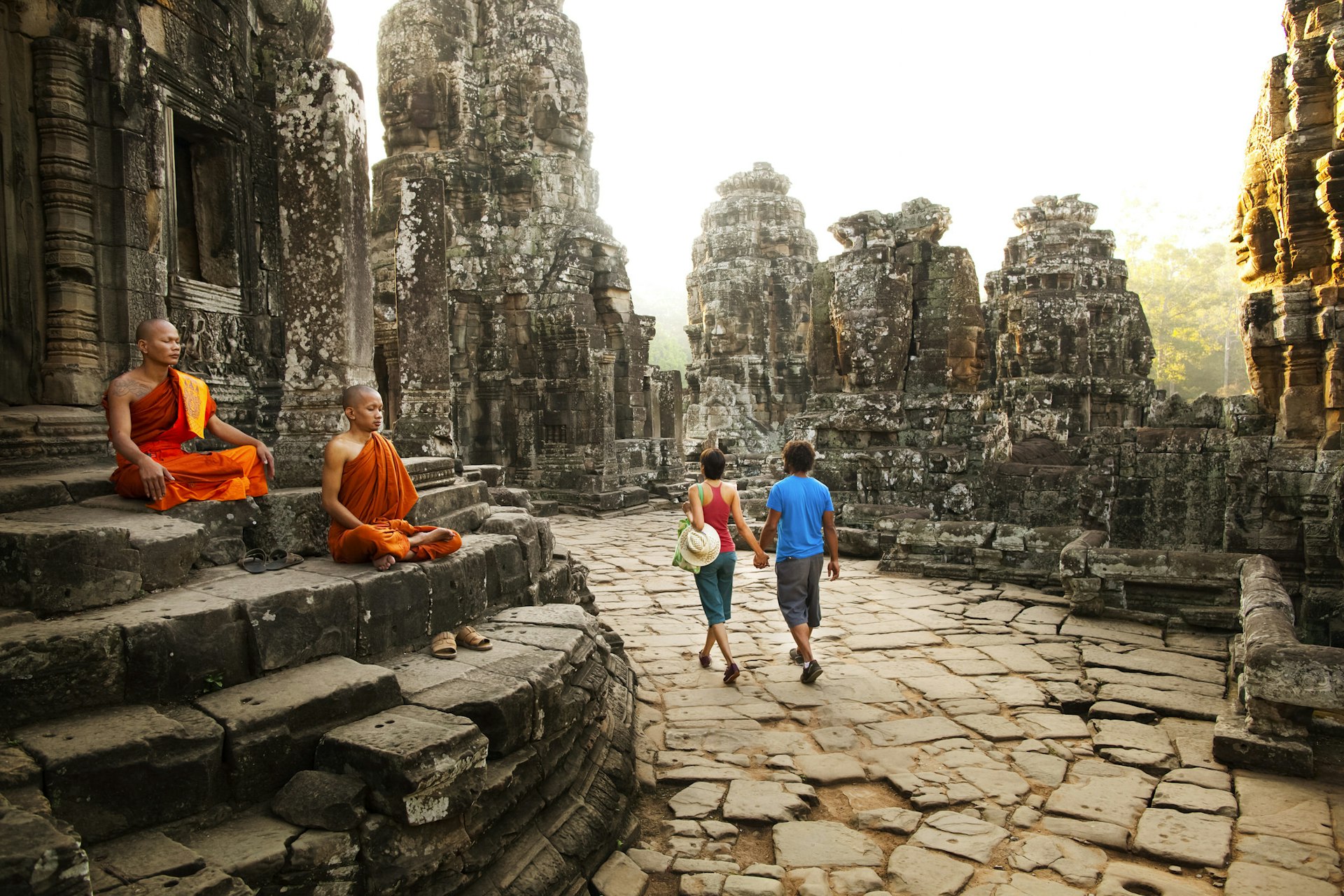
The low season (April–June & September–October) is the best time for discounts
When it comes to weather, these months are definitely not the best. Temperatures in April and May reach scorchio levels, and September and October are wet, wet, wet. However, this is the time when accommodation providers release their best special offers. You can save a huge amount of money if you plan on staying at five-star hotels and luxury resorts. September and October are the height of the rainy season, but this also brings emerald landscapes and epic cloud formations.
A month-by-month planner
Many of Cambodia's big festivals follow the lunar calendar and spill across more than one month on the Gregorian calendar. Here's a guide to what is happening throughout the year.
January–March is the busiest time of year
This is peak tourist season in Cambodia, and Phnom Penh, Siem Reap and the South Coast are usually heaving. The internationally recognized New Year celebrations are followed by Chinese and Vietnamese New Years' festivities, so be ready for some serious festive cheer.
Chaul Chnam Chen & Tet: The Chinese New Year – known locally as Chaul Chnam Chen – coincides with Tet, the Vietnamese New Year, falling in either January or February depending on the year. As many of Phnom Penh ’s businesses are run by Chinese-Khmers, commerce grinds to a halt around this time and there are dragon dances all over the capital.
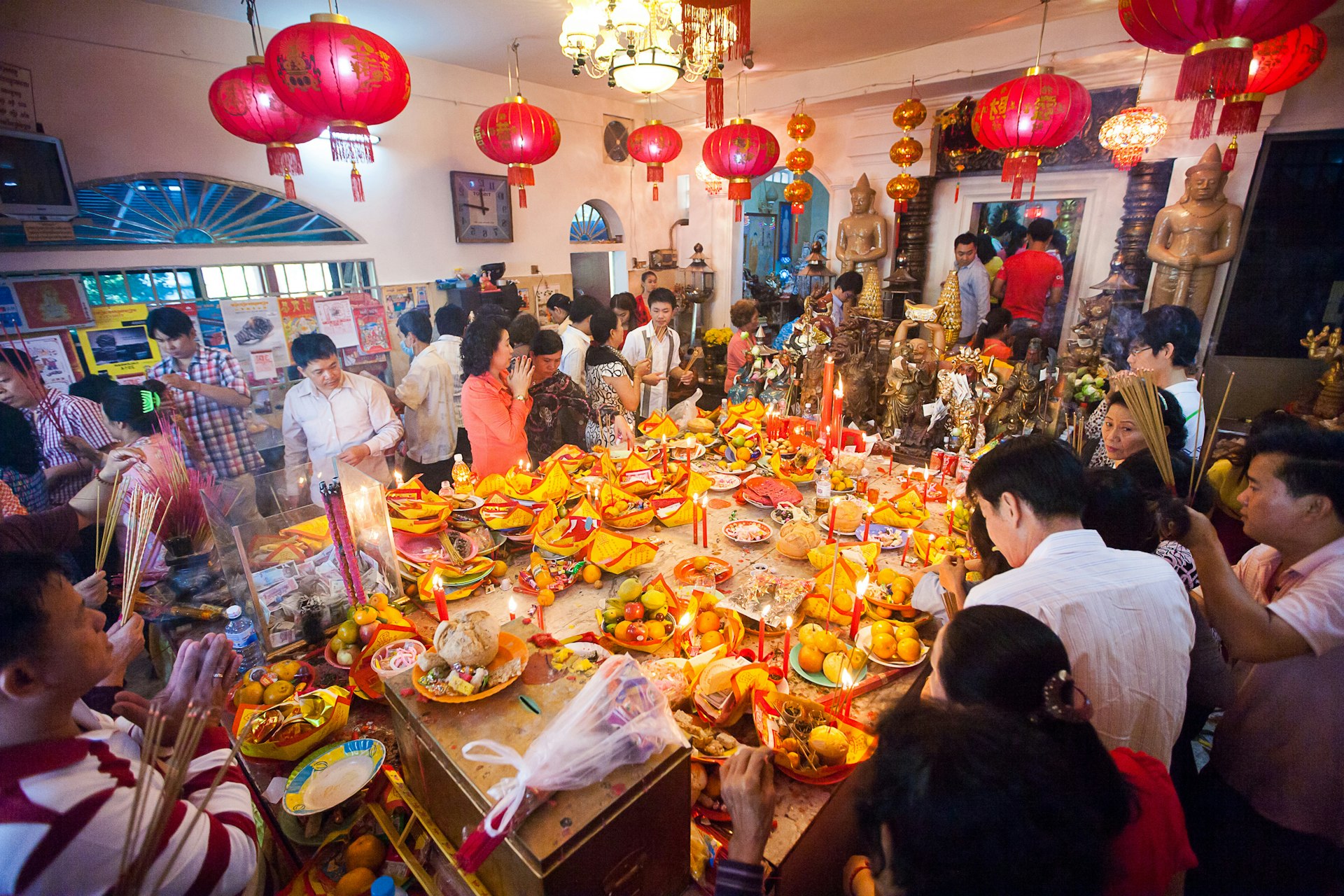
April–June brings festivals and the start of the rains
This is the beginning of the low season for visitors, as the monsoon swoops in, bringing regular rain until October. Young rice is planted and the landscape begins to come to life once more in a blaze of green after the parched months of the dry season. April is the most important month in the calendar for Khmers, marking the Cambodian New Year. However, temperatures rocket and the mercury regularly hits 40°C (104°F).
Chaul Chnam Khmer: During the three-day celebration of Chaul Chnam Khmer (Khmer New Year) in mid-April, Cambodians make offerings at wats, clean out their homes and exchange gifts. It is a memorable time to visit the Kingdom as Khmers go wild with water in the countryside, and a good-natured water fight spills across the country (throwing talcum powder is also popular).
Chat Preah Nengkal (Royal Ploughing Ceremony): Presided over by the royal family, the Royal Ploughing Ceremony is an ancient agricultural festival held to mark the traditional beginning of the rice-growing season. The royal oxen predict whether or not it will be a good harvest by tucking into the sacred crop. The ritual takes place in early May and rotates around different provincial capitals.
Visakha Puja (Buddha Day): A celebration of Buddha’s birth, enlightenment and parinibbana (passing), Visakha Puja sees locals flock to wats (pagodas) to pay their respects. The festival falls on the eighth day of the fourth moon (in May or June) and sees processions of monks carrying candles through Angkor Wat at night.
July–September sees more celebrations and crowds of backpackers
Tourism numbers see a bounce in July and August thanks to the annual school holidays in Europe and the US. Backpackers also descend on Cambodia and the Mekong region to take advantage of university and college holidays. September is traditionally the wettest month in Cambodia, with sporadic flooding along the Mekong and around Battambang . The Khmer calendar’s second-most-important festival, P’chum Ben, falls in September or October.
P’chum Ben (Festival of the Dead): This festival resembles the Christian celebration of All Souls’ Day when respects are paid to the dead through offerings made at wats. P’chum Ben lasts for several days and devout Buddhists are expected to visit seven wats during the festival. Local temples are a blaze of color, ceremonies and chanting.

October-December sees rain give way to warm, dry winds
The rains extend deep into October and this has led to some serious flooding in recent years. However, the countryside is extraordinarily green, and it's a rewarding time for boat travel between Siem Reap and Battambang. November sees the start of the dry, windy season, the best time to be in the country. The peak tourist season starts and continues through until February.
Bon Om Tuk, the much-celebrated Water Festival, takes place in October or November. Christmas and New Year are peak times for visitors at Angkor and leading beach resorts, so book a long way ahead. The international New Year on 31 December is widely (and wildly) celebrated in key cities such as Phnom Penh and Siem Reap.
Bon Om Tuk (Water Festival): Celebrating the victory of King Jayavarman VII over the Chams, this important festival in October or November also marks the extraordinary natural phenomenon of the reversal of the flow of the Tonlé Sap River. It’s a wonderful, chaotic time to be in Cambodia, with boat races at Sisowath Quay in Phnom Penh, and riverside parties in Siem Reap.
Angkor Photo Festival: In Siem Reap, resident and regional photographers descend on the temples and team up with local youths to teach them the tricks of the trade at this civic-minded festival in November or December. Photography exhibitions are staged all over town and some famous Vietnam War-era photographers are sometimes in attendance.
Angkor Wat International Half Marathon: This half marathon in December has been a fixture on the sporting calendar for two decades. Choose from a 21km (13-mile) half marathon, a 10km (6.2-mile) fun run or various bicycle races. It’s hard to imagine a better backdrop for a run than the incredible temples of Angkor.
You may also like: Angkor Wat: everything you need to know about Cambodia's most iconic temple Siem Reap: 11 best things to do after you explore Angkor Wat Cambodia's less-traveled islands visitors need to know about
Explore related stories
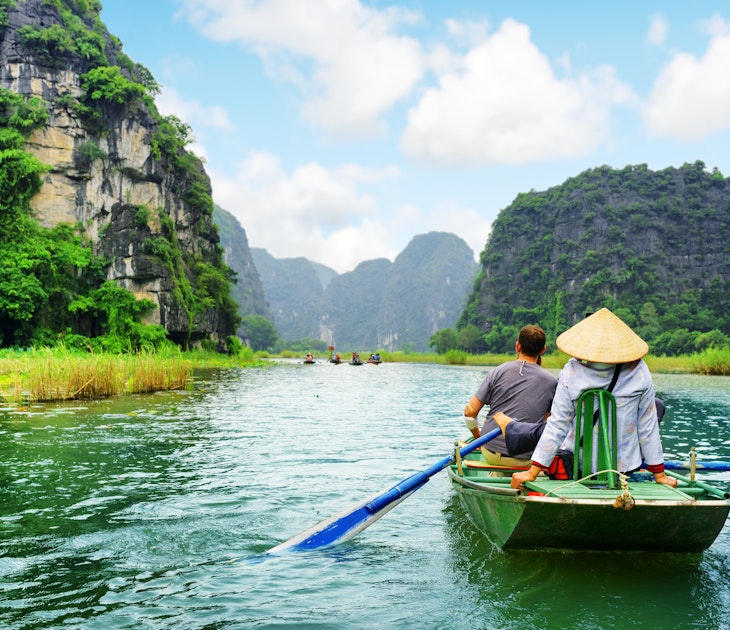
Mar 14, 2024 • 10 min read
Whether it's bus, train, private car, motorcycle, bike, plane or boat, you can plan your trip around Vietnam with this guide to getting around.

Mar 1, 2024 • 6 min read
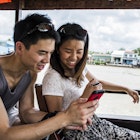
Feb 29, 2024 • 12 min read

Feb 24, 2024 • 8 min read

Feb 3, 2024 • 7 min read
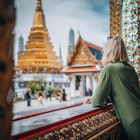
Jan 11, 2024 • 5 min read

Dec 27, 2023 • 8 min read

Dec 15, 2023 • 7 min read
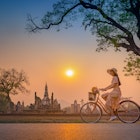
Dec 5, 2023 • 8 min read
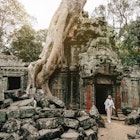
Nov 16, 2023 • 7 min read

- 2 Weeks for Couple
- 2 Weeks for Family
- Thailand Lantern Festival
- Indonesia(Bali)
- South Korea
- China (HK, Taiwan)
- Itinerary Ideas
- Asia Highlights Travel Reviews
- Thailand Travel Reviews
- Vietnam Travel Reviews
- Cambodia Travel Reviews
- Japan Travel Reviews
- Myanmar Travel Reviews
- China Travel Reviews

Best Time to Visit Cambodia
Quick facts, the best time to visit: cool season, the hot season, the wet season, festival tips.
Cambodia now reopens to travelers . From March 17, 2022, you don't need to do the nucleic acid test or post-arrival test to enter Cambodia as long as you're fully vaccinated.
Most travelers who visit Cambodia will do so between November and March. Seasons in Cambodia are split into wet and dry but the country is warm all year-round. The off-season is May through October and prices will be lower, but for a reason.
The cool-season is November through February. During this time the country is relatively cool and dry, making this the ideal time to travel. If you plan to travel during the cool-season make sure to book ahead of time, as this will be the busiest time of year.
The hot-season is March through May and travelers should expect increased humidity and heat, but decreased crowds and prices. Rainy-season is June through October and during this time monsoon rains engulf the country almost every afternoon, turning it into a lush green rainforest.
- Most tourists visit Cambodia between November and March.
- Usually the hottest month is April and the coolest is November.
- October has the highest average precipitation, while January is driest.
- The average temperature fluctuates between 20 and 30 ℃ (68 and 80 ℉).
- Record lows and highs rarely exceed 20 or 30 ℃ (68 or 80 ℉), respectively.
- Humidity is generally high, with an average of 80% during the wet season.
- The best time to visit for weather is also the most expensive.
- Traveling during the off season can be less comfortable, but more affordable.
Do not let the word "cool" mislead you. November to February is considered the cool season but "cool" is all relative in Cambodia and temperatures almost never drop below 20 ℃ (70 ℉). During these months the country experiences weather most conducive for traveling, with sunny skies and manageable temperatures.
It can still get hot during the day and average humidity is higher than you would expect, so leave your winter jacket at home. Some local businesses only open during this season, because it is when most tourism occurs.
Discover real reviews of Highlights Travel Family 's best-rated service across trusted platforms.
Festivals and Events
Water Festival
On November 2nd, 3rd, and 4th Cambodia celebrates one of its most important festivals, the Water Festival. Across the country there are huge, carnival-like celebrations. The largest are near Angkor Wat and Phnom Penh.
To celebrate the festival there are traditional boat races that are both thrilling and fun to watch. The festival celebrates the strange natural phenomenon of the river's current changing direction, with over 400 boats competing in races and fireworks. The whole country buzzes with energy during this time.
Moon Festival
The Water Festival occurs at the same time as the Buddhist Moon Festival during which Cambodian Buddhists pray for and celebrate the harvest season. Due to the timing these festivals are occasionally referred to as one, the Water and Moon Festival, but they are celebrated differently.
If you are in town during the Moon Festival you will have opportunity to watch Buddhists celebrate by burning incense, chanting, and praying.
In addition, you can try an interesting amok dish made from fruit, vegetables, and fish. This dish is unique to both Cambodia and the Moon Festival, and will delight your taste buds.
During the hot season (March through May) temperatures can exceed 29 ℃ (85 ℉) with 75% humidity during the day. During this time many locals will travel abroad or spend most of their time trying to beat the heat.
Although the heat and humidity can feel oppressive do not let this stop you from seeing some of the interesting events that happen during this time.
Khmer New Year
On April 14th, 15th, and 16th the country erupts in celebration of the Khmer New Year. This holiday is based on the solar calendar and each of its three days is celebrated differently.
First Day - Maha Songkran
On the first day of the New Year families will clean out their houses and light numerous candles around statues of Buddha. In the traditional worldview, this was the day the world was created, and it is celebrated with feasting and fireworks.
Second Day - Vanabot
If you are in Cambodia on Vanabot you will see lines of families going to monasteries to pray. This is also the day when locals exchange gifts. As a foreign tourist, this can be an exciting day to travel and watch locals participate in their traditional holiday celebrations.
Third Day - Leang Saka
On the third day of the celebrations people clean statues with scented water, burn incense, and of course enjoy lots of food. See if a local will show you their traditional statue-washing practices.
Head to a beach to cool off
If you are traveling to Cambodia to soak up some sun and get sand between your toes then the dry season is the time for you to travel. Kep, Sihanoukville and Ko Kong feature some of the cleanest and most relaxing beaches.
During the dry season getting to the beach areas from the larger cities such as Phnom Penh can become a challenge, as the roads alternate between dry and pitted, and wet and muddy. You are recommended to take a private car for an air-conditioned and expedient way to reach these beautiful beaches.
The Wet Season (June-October) can sound like a daunting time to travel, especially upon learning that it has been known to rain up to 51cm (20 inches) at a time. Cambodian rainstorms, however, are short and predictable, and often help to lower the humidity and temperature.
Storms are most common in the early afternoon and you might even find them enjoyable, if you have an umbrella and a rain jacket.
Upon arriving in the country, you are recommended to buy a cheap pair of shoes (you can find a pair for next to nothing) and plan to throw them away just before your flight home. The rain and mud typically combine to create a sole-destroying (but hopefully happy) experience.
- Most major festivals in Cambodia follow the lunar calendar and move forward or backward a few days year by year.
- The major festivals are Khmer New Year, Water Festival, Moon Festival, Visakhaboja, and Pchum Ben, and most span several days.
- You will experience larger crowds during the festivals and some restaurants and hotels will increase their prices.
- Traveling during the high season can be more exciting and allow you to experience Cambodia at its most thrilling.
- While some hotels may fill up, to say it is impossible to find lodging during the high season is a myth.
Visit Cambodia with Asia Highlights
Get to know our tour packages and let us do the work for you. Our experienced Asia Highlights staff will help you design your vacation in Cambodia. We take care of all the details so you can just relax and have fun during your holiday.
Visit the links below today, to learn more about our tour packages and start planning your visit to Cambodia.
- 12-Day Cambodia and Vietnam Highlights
- 14-Day Vietnam, Cambodia and Laos Tour
- 5-Day Siem Reap Tour at Depth
You might like to read
- Plan a Trip to Vietnam and Cambodia
- The Most Beautiful Places in Cambodia
- Best of Cambodia
- Top Experiences in Cambodia
Why Asia Highlights (10,000+ reviews & 98.8% 5-star rating)
- Save Your Time:
- Less research, more enjoyment!
- Real-time 1V1 expert planning
- Maximize Your Flexibility:
- Personal local guide and ride
- Explore at your own pace
- Celebrate Your Journeys:
- Specially-crafted family adventures
- Celebrate milestones with style!
Get Inspired with Some Popular Itineraries
At Asia Highlights, we create your kind of journey — your dates, your destinations, at your pace. You can have any trip tailor made for your travel.
More Travel Ideas and Inspiration
Sign up to our newsletter.
Be the first to receive exciting updates, exclusive promotions, and valuable travel tips from our team of experts.
Why Asia Highlights
Where can we take you today.
- Middle East
- African Safari
- Travel Agents
- Loyalty Program
- Our Differences
- Privacy Policy
Address: Building 6, Chuangyi Business Park, 70 Qilidian Road, Guilin, Guangxi, 541004, China
- Whens The Best Time Of...
When's The Best Time of Year To Visit Cambodia?

Cambodia is a year-round destination, depending on what you’re looking for. Here, we take readers month-by-month through the Cambodian calendar, so you can decide when’s the best time to plan your trip.
The fact that November to January is classed as Cambodia’s high season suggests January is traditionally one of the best months to visit the country. Temperatures are cool and the dry season is in full swing, meaning the weather is at its peak. However, this comes coupled with crowds as January is one of the busiest months, so tourist traps such as Angkor Wat and Phnom Penh’s riverside become way more congested than usual. Accommodation prices are also at their highest. To avoid the crowds, swop Sihanoukville’s beach for Kep’s, skip sunset at Angkor Wat and enjoy it at Ta Prohm instead, or head to the laid-back riverside town of Kampot.
Temperature: 78.8°F (26 °C)
Rainfall: 10mm

Weather-wise, February is still a good month to visit, with temperatures remaining relatively cool in Cambodian terms. Mango rains can make an appearance towards the end of the month, usually a surprise appearance overnight. While the heavy tourist crowds are starting to wane, Cambodia’s tourist hot spots can still remain crammed. If you’re in the country for Valentine’s Day then prepare yourselves because this Western celebration has been increasingly welcomed by Cambodians in the last few years, with heart-shaped balloons, giant stuffed bears and huge bunches of flowers dominating the landscape.
Temperature: 80.6°F (27°C)
Rainfall: 20mm

March is when things start really heating up in preparation for the humidity of April and the tourist crowds start noticeably thinning out. Now is a great time to head into the Cardamom Mountain’s jungle, with months of dry weather – or very little rain – making trekking paths more accessible and the blood-thirsty mosquitos less aggressive. Spending a lazy weekend on the river on the outskirts of Kampot town is another great March activity, with a drive to the top of Bokor Mountain offering refreshing breezes away from the mounting heat. While the rains are still a couple of months away, March marks the tail end of dry season so Cambodia’s vast countryside is arid, dry and dusty.
Temperature: 86°F (30°C)

April’s sweltering heat and oppressive humidity makes walking outside akin to wading through thick muggy air and visitors should expect to sweat by the bucketload. Temperatures are known to hit more than 104°F (40°C) Despite this, April comes with a sense of celebration because it is the month of Khmer New Year . While the exact dates vary, this year’s falls on April 11, 12 and 13 – with April 14 being observed as an additional public holiday. Expect Phnom Penh to shut down in eerie 28 Days Later- style as Cambodians head to the provinces to ring in the New Year with their families. Escape the heat with a trip to Kirirom. About 1.5 hours from Phnom Penh, Kirirom is home to sprawling pine forests where the temperature dips a good few degrees lower than in the city. Bliss.
Temperature: 95°F (35°C)

May’s temperatures may be marginally milder than April but it’s still sweltering hot. May tends to remain relatively dry despite Khmer New Year traditionally welcoming the rains, although they may start to fall towards the end of the month. May is also littered with public holidays, with one day given for International Labour Day, the Royal Ploughing Ceremony and the recently added Day of Remembrance. A three-day holiday is held from May 13 to 15 to mark King Sihamoni’s birthday. For the longer holiday, spots such as Otres in Sihanoukville and Kampot fill up quick with the expat and local exodus. Avoid the crowds and keep cool by heading to the remote province of Mondulkiri. The temperature is also much cooler in this mountainous region, which is famous for its elephants.
Temperature: 84.2°F (29°C)

By June, the rains should have started, bringing ripples of reprieve across Cambodia as humidity hits up to 70% during the day. While the sun still dominates the sky in between the showers, coastal areas, such as Sihanoukville and Kep, as well as the Cardamom Mountains can suffer from heavy downpours, dampening trips to these places. Despite this, June is a good month to explore Cambodia as visitor numbers are low ahead of the Western school summer holiday rush, the sun is still mostly wearing her hat, low season prices are starting and, if you’re lucky, you’ll catch one of those cracking lightning displays that flash throughout the night.
Temperature: 82.4°F (28°C)

By now monsoon season should be in full swing – although climate change has seen Cambodia’s usual clockwork weather play up in recent years, devastating the livelihoods of the country’s swathe of farmers and fishermen. However, fear not because the rain doesn’t usually dog the entire day, comes with plenty of warning, and is a spectacle for those who have never experienced them before. Usually the sky plunges into dark and sharp winds whip up, giving you about 30 minutes to find shelter before the skies open and rain angrily hammers from the sky for about an hour. Quickly after, the skies are once again blue, the sun is shining, and the only evidence is flooding.
Rainfall: 40mm

Rainfall tends to hit its peak in August, although showers are commonly shorter and heavier. While the term “rainy season” can be a turn-off for many, don’t let it put you off. In fact, this time of year can be the best to visit, with temperatures cooling, the countryside is lush and green – nothing beats emerald paddies contrasting against an angry grey sky – while the dust is washed away and the country’s many waterways are brimming and in full flow. Don’t forget to pack a light raincoat as these downpours can occur at any time. However, if you leave it behind, don’t worry because the streets are dotted with stalls selling disposable rain covers for about $1.
Temperature: 78.8°F (26°C)

The monsoons continue throughout September, with the results of months of rain now evident across the country. Paddies are flooded and rivers overflowing, making this a great time to explore the countryside. It is also the perfect time to take a trip on the Tonle Sap Lake, which swells to more than five times its size during monsoon season and is home to many floating villages and flooded forests. If you dare to take your chances of getting wet at Angkor Wat , then September is a good time to go as the crowds are at their lowest – besides, capturing iconic Angkor in the midst of a lightning storm is pretty awesome.
Rainfall: 60mm

With the rains starting to subside as the month progresses and the dry season just around the corner once more, October is another good time to visit the country. The waterfalls of Rattanakiri and Mondulkiri, as well as at Kulen Mountain in Siem Reap province, are gushing, making them great refreshing swimming spots. And the rain has started to wane on the coast, although showers should still be expected. Another major holiday falls in October in the form of Pchum Benh – again dates vary but this year it’s from October 8 to 10. This is a time when Cambodians believe the last seven generations of dead ancestors unable to move onto their next life roam the earth hungry. Many visits to pagodas to give offerings to monks to pass onto the dead take place.
Rainfall: 50mm

As dry season starts, high season also begins. Temperatures are starting to fall, humidity levels are low, the rains are well and truly subsiding and the crowds are once again starting to trickle back in. This is a good time to start hitting the coast and islands, with the sun pretty much guaranteed to shine all day. However, make sure you’re in Phnom Penh for Water Festival – or Bon Om Touk. Dates vary, with 2018’s event falling on November 21 to 23. During this three-day event, which marks the start of the fishing season as well as the reversal of the Tonle Sap River, hundreds of colourful dragon boats from across the country race along the river. Millions flock from across Cambodia to watch the spectacle so the capital gets busy.
Temperature: 77°F (25°C)

In terms of temperature, December is undoubtedly the best time to visit. Rainfall is very rare, humidity is next to nothing and many Cambodians are sporting their winter woollies and jackets, while complaining about the cold. If you’re coming from a cooler climate, then you don’t need to worry about the “cold”, however, it can get a bit nippy at night in the back of a tuk tuk, or if you’re heading to the coast or rural areas, where temperatures can dip so it’s worth bringing a light jumper. On the down side, December is a peak month, so the crowds are heaving, Angkor Wat is choked, and prices are at their highest. While Cambodia is a Buddhist country where Christmas isn’t celebrated, Christmas trees, decorations, festive events and Father Christmas hats dominate December.

When not to visit Cambodia
April is undoubtedly the month to avoid visiting the Kingdom of Wonder. Hot and sticky define each waking moment, with wading through the muggy air a mission. Air conditioning becomes your new best friend and lazy days around the pool the most energetic activity. On the upside, prices are at their lowest and if you avoid the cities and head to the country or hills, then temperatures become almost bearable.
Since you are here, we would like to share our vision for the future of travel - and the direction Culture Trip is moving in.
Culture Trip launched in 2011 with a simple yet passionate mission: to inspire people to go beyond their boundaries and experience what makes a place, its people and its culture special and meaningful — and this is still in our DNA today. We are proud that, for more than a decade, millions like you have trusted our award-winning recommendations by people who deeply understand what makes certain places and communities so special.
Increasingly we believe the world needs more meaningful, real-life connections between curious travellers keen to explore the world in a more responsible way. That is why we have intensively curated a collection of premium small-group trips as an invitation to meet and connect with new, like-minded people for once-in-a-lifetime experiences in three categories: Culture Trips, Rail Trips and Private Trips. Our Trips are suitable for both solo travelers, couples and friends who want to explore the world together.
Culture Trips are deeply immersive 5 to 16 days itineraries, that combine authentic local experiences, exciting activities and 4-5* accommodation to look forward to at the end of each day. Our Rail Trips are our most planet-friendly itineraries that invite you to take the scenic route, relax whilst getting under the skin of a destination. Our Private Trips are fully tailored itineraries, curated by our Travel Experts specifically for you, your friends or your family.
We know that many of you worry about the environmental impact of travel and are looking for ways of expanding horizons in ways that do minimal harm - and may even bring benefits. We are committed to go as far as possible in curating our trips with care for the planet. That is why all of our trips are flightless in destination, fully carbon offset - and we have ambitious plans to be net zero in the very near future.

See & Do
Stay curious: experience cambodia from your living room.

Guides & Tips
The most family-friendly destinations in cambodia.

A Guide to Phnom Penh's Royal Palace and Silver Pagoda

A Guide to Cambodia's Landmines and Unexploded Ordnance

Restaurants
The 10 best restaurants in siem reap and angkor wat.

Food & Drink
7 things you didn't know about cambodian cuisine.

Places to Stay
The most unusual places to stay in cambodia.

Bars & Cafes
Copy of - the best places to eat street food in phnom penh, cambodia.

How Did Cambodia Get its Name?

How Cambodia Came to Produce Arguably the World's Best Rice

The Most Beautiful Temples in the World

The Best Hotels Near Angkor Wat for Every Traveller
Culture trip spring sale, save up to $1,100 on our unique small-group trips limited spots..

- Post ID: 2091917
- Sponsored? No
- View Payload
Cambodia Guide: Planning Your Trip
:max_bytes(150000):strip_icc():format(webp)/mike_borobudur-5b6d3ea446e0fb0025fcb683.jpg)
The remnants of a glorious Khmer empire still enchant visitors to Cambodia—not just the grandeur of the Angkor temples, but also the effervescent joy of a people who shook off a genocide within living memory.
This patchwork of contradictory elements—majesty, hardship, culture, happiness—makes this Southeast Asian country such a compelling place to visit.
Siem Reap and its nearby Angkor temples have put Cambodia on the travel map, but you need to go beyond for the complete experience. Visit the lakeside villages at Tonle Sap, or go on a river cruise to the capital Phnom Penh . Visit Koh Rong’s white sand beaches, Kampot’s farms, and a little-known temple ruin at Banteay Chhmar.
For first-time visitors, Cambodia can be a lot to take in at once: ease your entry by reading the information provided below.
Planning Your Trip
- Best Time to Visit: Schedule your visit to Cambodia during the dry season from late November to early April. The cooler weather and lack of mud make a visit to the Angkor temples perfectly pleasurable, and avoids the monsoon season’s floods .
- Language: Over 90 percent of the local population speak the Khmer language. You’ll find some locals can speak conversational English in the main tourist areas, like Siem Reap, but expect little to none when you go out to the villages.
- Currency: the local currency is the Cambodian riel (KHR), with its value pegged at 4,000 riel to the US dollar. The greenback is accepted in most tourist spots, though they will only accept new-looking bills.
- Getting Around: The best way to go places is by hiring the auto-rickshaw called the tuktuk ; they’re even better value if you hire one over the course of several days.
- Travel Tip: You’ll be pressured to see Angkor Wat’s fabled sunrise. It’s like visiting the Louvre to see the Mona Lisa: any sense of greatness is dissipated by the massive crowds coming to see the same thing. Visit during the early morning or late afternoon, but give sunrise a miss.
Things to Do
Everybody’s heard about Angkor Wat and the Angkor Archaeological Park that surrounds it. But what do you know about Tonle Sap, Southeast Asia’s biggest lake, which increases size sixfold during the monsoon season? Or the lively restaurant and nightlife scene in the capital Phnom Penh? What if we told you that Cambodia’s white-sand beaches rival Thailand’s, or that the Cardamom Mountains are excellent places to hike and meet elephants in?
Here are the experiences we recommend when you’re planning a trip to Cambodia:
- Explore the vast Angkor Archaeological Park. This 400-acre park near Siem Reap contains Angkor Wat and a collection of Buddhist and Hindu temples dating back to the 12th century. “Temple fatigue” is a real danger here, with the vast collection of structures contained within; choose from a 10-mile “Small Circuit” that can be seen in the space of a day, or the 16-mile “Grand Circuit” that requires a multiple-day entry pass to cover.
- Visit the Genocide Museum in Phnom Penh. In the 1970s, torture camps like S-21 in Phnom Penh contributed to the Khmer Rouge-led genocide that killed up to three million people. Now known as the Tuol Sleng Genocide Museum , the former school building now stands as a grim reminder of the absolute depths that humans can sink to under the influence of a malign ideology.
- See Southeast Asia’s largest freshwater lake. Tonle Sap changes with the seasons, expanding from 1,000 sq mi to 6,200 sq mi during the rainy season from June to October. The flooded forests provide a rich breeding ground for over 300 species of fresh water fishes—indeed, the lake provides half of Cambodia’s total fish catch. Located only ten miles north of Siem Reap, Tonle Sap is renowned for its floating villages, where entire communities live off the bounties of the lake.
- Laze about on a beach. Cambodia’s island beaches are arguably as good as Thailand’s, but with less crowds and more charm. Koh Rong , Cambodia’s second-largest island, offers 27 miles of lightly-developed coastline; a rugged beach destination that’s easily accessible from the mainland, with an affordable set of campsites, bungalows and hostels to stay at while you’re enjoying the place.
- Go hiking in the Cardamom Mountains. This mountain range near the border with Thailand contains a large chunk of virgin rainforest that’s become an ecosystem for endangered flora and fauna. Hike through these jungles and discover waterfalls, rare plants, and the occasional elephant. Ecotourism projects like the Chi Phat commune go a long way in preserving the local environment, while curating it for tourists.
What to Eat and Drink
Sitting in the shadow of the cuisine of neighboring Thailand, Cambodian cuisine is noted for its lack of heat. But Khmer food is more complex than you’d think: it represents waves of multiple influences, from noodles brought over by the Chinese; bread dishes imported by the French; and curry sauces reflecting Indian sources.
Most dishes throughout the day are eaten with plain white rice, but the meats and vegetables all reflect Cambodia’s unique terroir . Thanks to the abundance of freshwater lakes, rivers and streams, fish is the country’s most important protein. The Khmer also eat beef and pork, all given subtly complex flavors by local herbs and spices like shallots, garlic, galangal and lemongrass.
Diy13/Getty Images
Where to Stay
Siem Reap, the most common international gateway for tourists to Cambodia, offers a wide range of accommodations ranging from hostels to historic five-star hotels. Make sure to book in advance, particularly if you’re visiting during the high season between December and February.
Beyond Siem Reap and the cities, rural areas and more laid-back towns like Kampot offer homestays for tourists who want to experience local living. “Glamping” is also offered as an option in some community-based tourism sites like Banteay Chhmar .
Getting There
Most international visitors fly in to Cambodia via Siem Reap International Airport , located three miles from Angkor Wat and about five miles from Siem Reap itself . From Siem Reap, you can take minbuses, buses or domestic flights to other parts of the country, including Phnom Penh, Battambang, Kampot and Sihanoukville (the gateway to Koh Rong).
If you’re planning an overland visit from neighboring countries, several border crossings are open for tourists: the Aranyaprethet/Poipet and Trat/Koh Kong crossings bordering Thailand ; and the Moc Bai/Bavet crossing bordering Vietnam.
Most nationalities can enter Cambodia without a visa for up to 30 days; check with the Cambodia Ministry of Tourism for any changes in policy before planning a trip.
Culture and Customs
- Cover up in Buddhist temples. Despite the influx of Western tourists, Cambodia as a whole remains conservatively Buddhist, and will not brook any disrespect to their temples and monks. This means covering your shoulders and legs when visiting active Buddhist temples , including the Angkor park complex. Tourists wearing “skimpy” clothes will not be allowed to enter.
- Tipping is optional in Cambodia. Prices in Cambodia don’t include a tip, and tips aren’t expected from tourists. However, given low local wages, any tip will be appreciated, and shows your genuine satisfaction with good service.
- Don’t visit local orphanages. Cambodia is one of Southeast Asia's least developed and most poverty-stricken countries, and many entrepreneurs have capitalized on foreign charitable impulses to set up orphanages where tourists can volunteer their time . But the “orphans” in these places often still have a living parent; a good number of orphanages are only a cynical tourist cash grab.
Marc Dozier/Getty Images
Money Saving Tips
- Stay at a hostel. Not all Cambodian hostels are grimy and stinky; some approach boutique standards without raising the price too high. Hostels aren’t just great for saving on accommodations, they’re also excellent places to meet other tourists, swap tips on the best places to see, and even split costs on transport or food.
- Hire a tuktuk for more than just one destination. Tuktuks can be found lining up at almost every street corner in Siem Reap. But you don’t have to hire a different tuktuk for every trip. Tuktuk drivers are happy to serve as your personal chauffeurs for your entire visit to Siem Reap, if you can negotiate a reasonable package for yourself. A visit to the Angkor temples might cost $20, and maybe $5 or so for a one-way trip to the airport. Put together a list of places you want to visit, and see if a tuktuk driver can accommodate them all at a price you can live with.
- Look for free stuff to do. In Phnom Penh, for instance, you can take up free meditation classes at Wat Langka every Monday, Thursday and Saturday evenings at 6pm; and Sunday mornings at 8:30am.
- Buy a local SIM card for phone and mobile internet use. Cellular phone roaming in Cambodia, as with the rest of Southeast Asia, is just a matter of buying a local SIM card and slapping it into a compatible handset. There are multiple cellular providers in Cambodia to choose from—although Cellcard ’s cheap data packages are popular with tourists, and Smart offers good rates for international long-distance calls. Prepaid SIM cards can be bought at almost every corner store, convenience store, and cellphone store; present your passport to buy one.
The Top 10 Things to Do in Cambodia
A Beginner's Guide to Siem Reap, Cambodia
The 13 Best Things to Do in Siem Reap
Where Is Angkor Wat?
Traveling to Cambodia: Essentials to Know
Angkor Wat in Cambodia
Phnom Penh, Cambodia Guide: Planning Your Trip
Visiting Phnom Penh's Wat Phnom Temple
What $100 Can Get You in Southeast Asia
Siem Reap International Airport Guide
Top UNESCO World Heritage Sites in Southeast Asia
Cambodia's Biggest Festivals
How to Visit the Must-See Temples in Angkor, Cambodia
The Best Time to Visit Angkor Wat
The Top 7 Things to Do in Phnom Penh, Cambodia
Visa Requirements for Cambodia
Best time to visit Cambodia

The best time to visit Cambodia is between November and May, when the country experiences low rainfall and still enjoys warm temperatures. However, the climate in Cambodia is generally hot and humid all throughout the year.
Generally, any time of the year is a good time to travel in Cambodia , with each season having its advantages. The climate in Cambodia is generally hot and humid all throughout the year. Temperatures stay in the mid to high 80s°F most of the year, dropping slightly at night. There are officially two seasons in Cambodia – wet and dry. In November–May you can expect dry conditions, while June–October will have the wettest conditions. What's more, there are benefits to traveling in both seasons, depending on what you're looking to get out of Cambodia.
The wet season in Cambodia usually runs from June through to October each year. That doesn't mean you'll avoid all rain if you travel outside of these months, but you'll definitely miss most of it. As in many Southeast Asian countries, an afternoon storm provides a welcome relief from the humid mornings, so trying to dodge any and all rain will mean you miss out on what's part of daily life in Cambodia. Just before the wet season, in April and May, Cambodia can often be incredibly warm and humid, so taking all of this into account, November–March is the best season to stay comfortable and dry.
The Angkor complex, just out of Siem Reap, is a bucket-list item on everyone's Cambodian travel must-sees. There's no one perfect time to appreciate these wonders of the ancient Khmer empire, but we want to let you in on a little secret. While many tourists decide that December to March is the best time to visit the temples because it's dry, slightly cooler and less humid than usual, the air is often quite hazy and the complex super busy during this time.
There is a reason that this is a busy time – almost guaranteed good weather – but if you're looking for crowd-free temple shots, it's probably not for you. Why not consider going at the start or end of the wet season (May–June and October–November)? While you might find yourself dodging muddy puddles and getting stuck in a mighty rain shower once in a while, there are way less crowds, and there's often sun all morning and bursts of light throughout the day that peek through the monsoon clouds. Picture this: Angkor Wat drenched in an afternoon storm, then the skies calm to reveal glistening temples in the early evening sunlight, without a person in sight. Now that's a pretty epic shot and with a bit of luck, you might get to capture it.
Cambodia's a very popular tourist destination – and we get it. It's beautiful, has a storied history and offers swathes of culture to get stuck into. All of this makes it tricky to find a time when it's crowd-free, but visiting outside of the November–March peak season is your best option. If that's just not achievable and your only opportunity to visit is in the busy period, it's best to steer clear of the Lunar New Year festival (encompassing Chinese New Year and Tet in neighboring Vietnam), which usually occurs in late January or early February. If you can work around this, you'll still be able to check out the best this country offers without too many crowds.
Best for: water sports, scuba diving and hiking
The cool (ish), dry weather of January makes it one of the best times to visit Cambodia. With temperatures ranging between 68°F -85°F, outdoor activities are super popular – think scuba diving and snorkeling in Sihanoukville and hiking in the country’s mountain regions.
While the month’s nice weather means every popular city will be packed with other travelers, Cambodia’s breathtaking landscapes will soon have you forgetting the crowds.
Best for: beach time, island hopping and Angkor Wat exploring
Similar to January, February is smack bang in the middle of the peak season so expect to share the iconic sights and city streets with other travelers. Because temperatures are at a manageable 73°F -90°F , it’s the perfect month to get out and explore. Whether you fancy laying on a beach along the Cambodian coast with a cocktail in one hand and a good read in the other or explore the ancient grounds of Angkor Wat, you’ll never run out of things to do and sights to see.
Best for: wandering around temples, floating village visits and cycling through the countryside
Since the dry season runs until April, March is still a pleasant time (albeit a little stickier) to explore Cambodia’s diverse landscapes from the chaotic streets of Phnom Penh to the luscious countryside of Battambang. Popular activities to enjoy during the month include cycling, wandering around religious temples and visiting Tonle Sap Lake’s floating villages to make the most of the peak season’s rainless weather.
Best for: boat tours, street food eating and pottery village visits
Say goodbye to the arid heat and hello to the stickiness that signals the end of the dry season in Cambodia. While you should prepare for the humidity (around 75%), potential rainfall and high temperatures of April, the monsoonal season isn’t here yet so it’s still a relatively nice month to experience the best of Cambodia.
Why not tickle your tastebuds on a street food tour in Siem Reap? Or embark on a cruise to take you from Siem Reap to Battambang? Cambodia is your oyster.
Best for: Royal plowing ceremony watching, wildlife spotting and soaking up local culture
Stifling is one way to describe the weather in Cambodia in May but don’t let that deter you from exploring this magnificent country during shoulder season (in between peak and low seasons). While the humidity’s rising and rainfall is becoming more frequent, there’s still heaps to see and do, including witnessing the annual Royal plowing ceremony that takes place every May.
Heralding the start of rice growing season, the King of Cambodia leads rituals steeped in centuries of Khmer tradition, even tilling a plot of land in the heaps of a successful and abundant season ahead. It doesn’t get more cultural than that.
Best for: museum visits, rice paddy day trips and Buddha’s birthday celebrations
One of the positives about visiting Cambodia in June is that the iconic sights and streets of the must-visit cities (we’re looking at you Siem Reap and Phnom Penh) will be relatively free of other travelers. However, one of the negatives of visiting during monsoon season is that you will get drenched at some point – that’s just a fact. Pack your thongs if you don’t want to get your shoes ruined.
But while it’ll definitely rain during your stay, the downpours only last for a short period, leaving you plenty of daytime left to explore everything Cambodia has to offer whether you’re dying to visit the luscious rice paddies or can’t wait to can’t wait to check out a museum or two.
Best for: bar hopping, Phare Cambodian Circus watching and Khmer culture
Although July is fully entrenched within Cambodia’s rainy season, the daily downpours usually occur over a short period at nighttime, meaning you should be asleep for the bulk of them (unless you’re hitting up bars along Street 104 in Phnom Penh). But, while you might be able to avoid the worst of the rain, you won’t be able to escape the humidity with levels at an eye-watering 75%. So, you should definitely keep this in mind if you’re planning any long-distance hikes in the Cardamon Mountains or strenuous bike rides.
Best for: Kampot day trips, elephant sanctuary visits and exploring the countryside
While the country may be at its rainiest, it’s also at its prettiest during August with the daily downpours ensuring Cambodia’s landscapes come to life. From the moss-covering ancient temples in Siem Reap to rice paddies bursting with a color so green you won’t want to take your eyes off them, the rainy season sure makes this country look good. Like, really good.
If you can get past the rain, you’ll have the most iconic sites largely to yourself and this also means activity prices are lower and accommodation availability is high.
Best for: Ancestors Day festivities, farm tours and dinners at Srah Srong Lake
September is one of the wettest months in Cambodia so if you’re travelling during this month, remember to pack your gumboots and waterproof jackets. While the rain will try its best to dampen your travel-loving spirits, there’s still plenty to see and do (if you don’t mind getting a little wet).
It might seem like we’re harping on and on about the rain thing but, on average, it pours 2 out of 3 days. That doesn’t mean you can’t still have fun experiencing Ancestors Day (a festival that celebrates dead ancestors) and exploring local farms on guided tours though.
Best for: food tasting at Central Market, various visitor centres and art gallery strolls
October brings the highest humidity of the year (around 84%) so while the temperatures might not be that high (80°F on average), it’s sure going to feel like they’re about 5C higher. It can still be a great time to explore Cambodia though, as long as you’re properly prepared.
Avoid spending long periods of time outside and instead opt for activities such as strolling through art galleries and tasting every traditional dish you can see at the Central Market in Phnom Penh. That way, you’ll be out of the heat and humidity while still enjoying the very best of Cambodia.
Best for: island life, water festival watching and market stops.
You can expect the wet days to roll into November but there’s a light at the end of the monsoonal tunnel; the weather should start to turn nicer and drier as the month goes on. But crowd levels will start to increase with the peak season fast approaching. This means that iconic sights, such as Angkor Wat, will start to get busier and busier. If you want to avoid the worst of it, try visiting in the early morning or late afternoon – chances are there’ll still be plenty of people around but hey, at least you gave it your best shot.
Best for: marveling at the Royal Palace, snorkeling and new years festivities
Yes, the arid and relatively cool weather of the dry season is back, but so is the dust. Because it rarely rains during this period, expect a nice haze across the spectacular landscapes. If that doesn’t bother you, December is an excellent time to visit and even coincides with the Aussie school holiday schedule – did someone say Christmas in Cambodia?
Definitely make the most of the incredible weather and spend as much time as you can outdoors, whether that’s wandering through the Royal Palace on a guided tour in Phnom Penh or discovering Cambodia’s underwater world.
Learn more about weather in Cambodia
Let's create an exclusive trip for your group.
Girl power: Meet the female tuk-tuk drivers of Siem Reap
Thailand or Cambodia? Which South East Asian country to tick off next?
6 ways you can go beyond Asia’s hotspots in 2023
What to expect at a Cambodian homestay
“When you have no income, you have no voice.” How the hyacinth weavers of Siem Reap are changing lives for good
Why travelling with your child is the greatest adventure
Cambodia or Laos? Where to go on your next trip
Cambodia or Vietnam? The Asian destination that should be first on your travel list

Change location
- Call us today until 6pm
- 01993 838 925 01993 838 160 or
- REQUEST A QUOTE
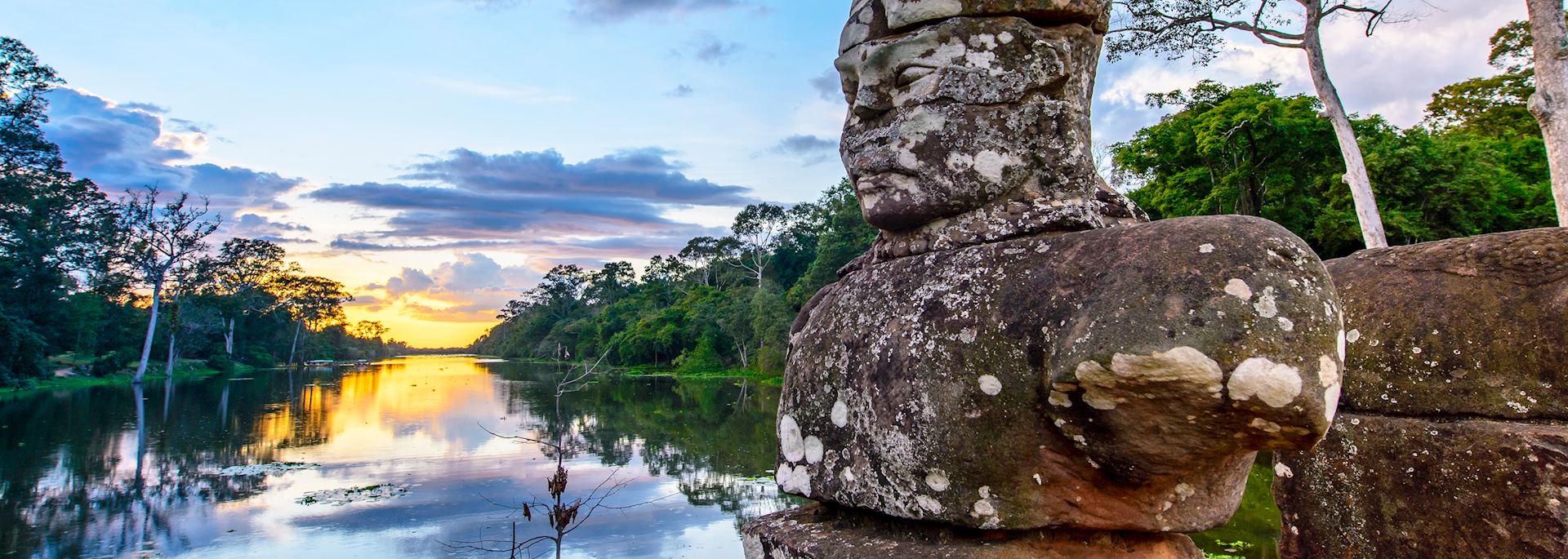
When is the best time to visit Cambodia?
- Temples of Angkor
- Month-by-month
The best time to visit Cambodia is between November and April, when it sees very little rain. During this time you’ll see clear blue skies making it a great time to enjoy a relaxing getaway on the southern coast.
Outside of this period, humidity increases and the rains come, assisting Cambodian farmers in the growing of their crops. However, you shouldn’t be deterred from travelling — the countryside is lush and green, rivers are full and flowing, and the temples are quiet. This is the best time to visit some of the outer-lying temples, which will often be deserted.
At the end of the summer one of Cambodia’s true wonders comes to life — The Tonle Sap, the largest freshwater lake in Southeast Asia and home to Cambodia’s floating villages.
- Make an enquiry
- Request a brochure
Month-by-month guide for travelling in Cambodia
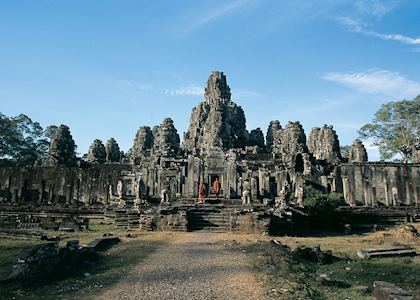
Visiting Cambodia in January
January is the driest month of the year in Cambodia and has a comfortable average temperature of 26°C, making this the perfect time to explore the temples in Siem Reap or relax on the southern coast's beaches.
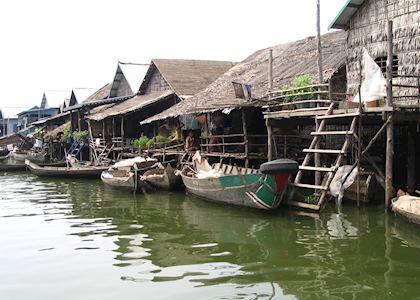
Visiting Cambodia in February
February sees little rain and temperatures are still cool enough to enjoy long walks around the temples. Conditions are still perfect for river travel during this time, and the great Tonle Sap still holds the bulk of its volume.
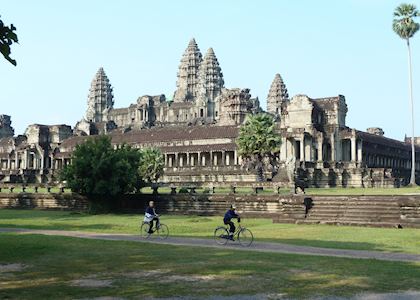
Visiting Cambodia in March
This is the peak time to visit Cambodia, and temperatures are likely to rise to the low 30°Cs. Water levels begin to fall toward the end of the month, meaning that the Tonle Sap is not as impressive. Hotels are often booked up far in advance during this period.
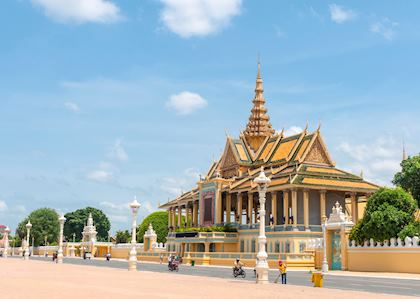
Visiting Cambodia in April
The peak season continues and temperatures reach sizzling heights, often exceeding 33°C. It is therefore best to explore early in the morning and in the late afternoon rather than embarking on full day excursions. The Chaul Chnam (Cambodian New Year) takes place during April, and although the rains should hold off, you should be prepared to get wet if venturing around town during those dates.
Events & Festivals
- Khmer New Year (13th - 16th April): The country's most celebrated holiday, with towns and cities becoming deserted as people head home to be with their families.
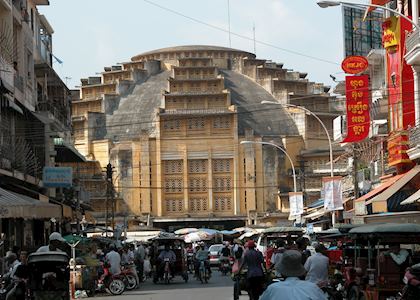
Visiting Cambodia in May
With the wet season fast approaching, May provides a good opportunity to take advantage of promotional shoulder season offers as crowds begin to disperse. You should expect a few showers during this time of year, but nothing that will greatly impact on your trip. In fact, the showers help to break up the humidity, making for more comfortable conditions.
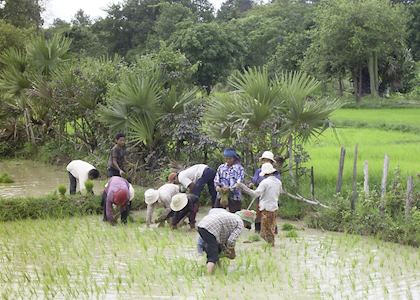
Visiting Cambodia in June
The rains come to Cambodia in June, bringing great relief to the farmers. For the most part, showers are short and sharp and should not impact on your trip, with plenty of sunshine still seen. Temples and other tourist sites are quieter at this time of year, and you can take advantage of many hotel promotions during Cambodia's 'green season'.

Visiting Cambodia in July
The rains continue across the country and the beaches on the southern coast are best avoided. Temperatures start to decrease, averaging 27°C, and some of the outerlying temples are deserted at this time of year, making it a great time to explore some of the lesser-known destinations. Lots of families choose to visit at this time of year as it coincides nicely with European summer holidays.

Visiting Cambodia in August
Temperatures reduce further, making temple exploration all that more comfortable. Rains continue throughout the country and reach their peak; although showers only usually last for a few hours at most and tend to be more prevalent in the north of the country. The Tonle Sap fills up again, and flora and fauna is in full bloom, making this a good time to visit for wildlife enthusiasts.
Visiting Cambodia in September
September is Cambodia's wettest month and you should expect heavy showers daily; although these are normally short-lived and exploration is still possible. The rain does mean that some rural areas are difficult to access by road, so visiting a month either side is more attractive.

Visiting Cambodia in October
The rains begin to die down and temperatures average 27°C, making October a lovely time to visit Cambodia and its lush landscape. Beat the crowds and take advantage of early season promotional offers.
- Pchum Ben (October): An important Buddhist festival marked throughout the country over 15 days, with main celebrations taking place on the final day as locals pay their respects to deceased relatives.
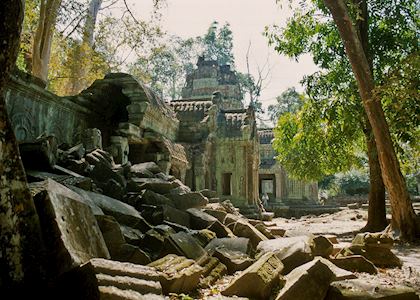
Visiting Cambodia in November
Cambodia's peak season begins again and the crowds flock to the temples, with temperatures averaging a comfortable 25°C. It is the perfect time to venture out onto Tonle Sap lake . The Cambodian Water Festival usually takes place in November, and hotel prices are often higher at this time of year, so it is essential to book far in advance.
- Bon Om Touk/Cambodian Water Festival (November): One of the nation's most popular festivals, celebrated over three days with concerts and boat races in Phnom Penh.
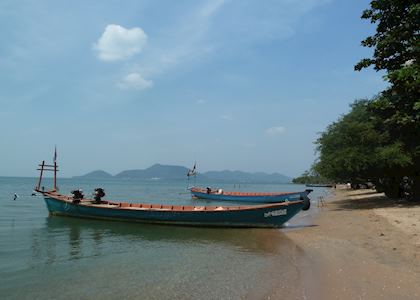
Visiting Cambodia in December
During December, Cambodia sees great weather throughout and can make for a rewarding Christmas destination. Hotels are often booked up far in advance.
Cambodia Climate Guide
Why travel with audley.
- 100% tailor-made tours
- Fully protected travel
- Established for over 25 years
- 98% of our clients would recommend us

Travel advice
Practical tips for travelling to Cambodia, from social protocols to guidance on money matters, with a link to the latest FCDO travel advice.

Request our brochure
Covering all seven continents, The World Your Way shows you how you can see the world with us. It features trip ideas from our specialists alongside hand-picked stays and experiences, and introduces our approach to creating meaningful travel experiences.
Trip ideas and travel guides for exploring Cambodia
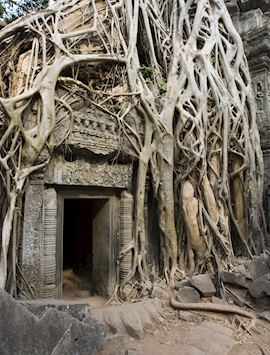
Exploring the Mekong & Angkor Wat
14 days from £4,820pp
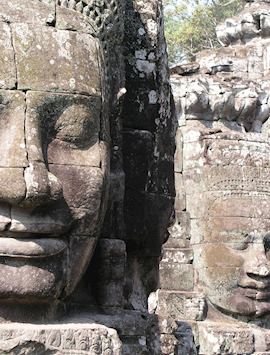
Grand tour of Cambodia
18 days from £5,190pp
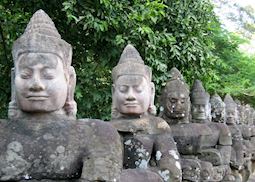
What to do in Cambodia: our highlights guide
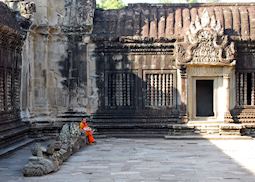
Angkor Wat & the temples of Angkor

Best time to Visit Cambodia
At a glance:.

The Dry Season
The cool season, the hot season, the wet season.

Cambodia Weather
Want to go, cambodia travel guide.
- All Cambodia Trips
- All Cambodia Videos
- All Cambodia Travel Stories
- Brief Introduction to Siem Reap
- Cambodian Cuisine
- What was the Khmer Rouge?
- Cambodia FAQs
- Cambodia Wildlife
Favorite Cambodia All Trips
- Highlights of Cambodia
- Active Cambodia
- Mekong Expedition - Siem Reap to Ho Chi Minh
- South Cambodia Escape
- Cambodia Snapshot
- Vietnam, Cambodia, and the Riches of the Mekong - Cruise Only
Top Cambodia Travel Destinations
- Kampong Chhnang
- Mekong River
- Tonle Sap Lake
Cambodia Trips by Departure Date
- 2024 Cambodia trips (56)
- 2025 Cambodia trips (53)
- 2026 Cambodia trips (8)
- August 2024 (37)
- September 2024 (37)
- October 2024 (42)
- November 2024 (52)
- December 2024 (39)
- January 2025 (41)
- February 2025 (41)
- March 2025 (39)
- November 2025 (38)
Top Experiences in Cambodia
- Cambodia Cruises (48)
- Cambodia River Cruises (44)
- Cambodia Cultural (40)
- Cambodia Luxury (30)
- Cambodia Land Tours (8)
- Cambodia Most Popular (3)
Cambodia Trips by Duration
- 5 day trips (12)
- 8 day trips (19)
- 11 day trips (3)
Cambodia Trips by Activity
- Cambodia village visits (47)
- Cambodia local market visits (46)
- Cambodia small ship cruises (30)
- Cambodia archaeological site visits (23)
- Cambodia biking (14)
- Cambodia urban exploration (13)
- Cambodia cooking classes (11)
- Cambodia wildlife viewing (8)
- Cambodia hiking (5)
- Cambodia land & sea exploration (4)
Why Travel With Adventure Life
Recognized by.

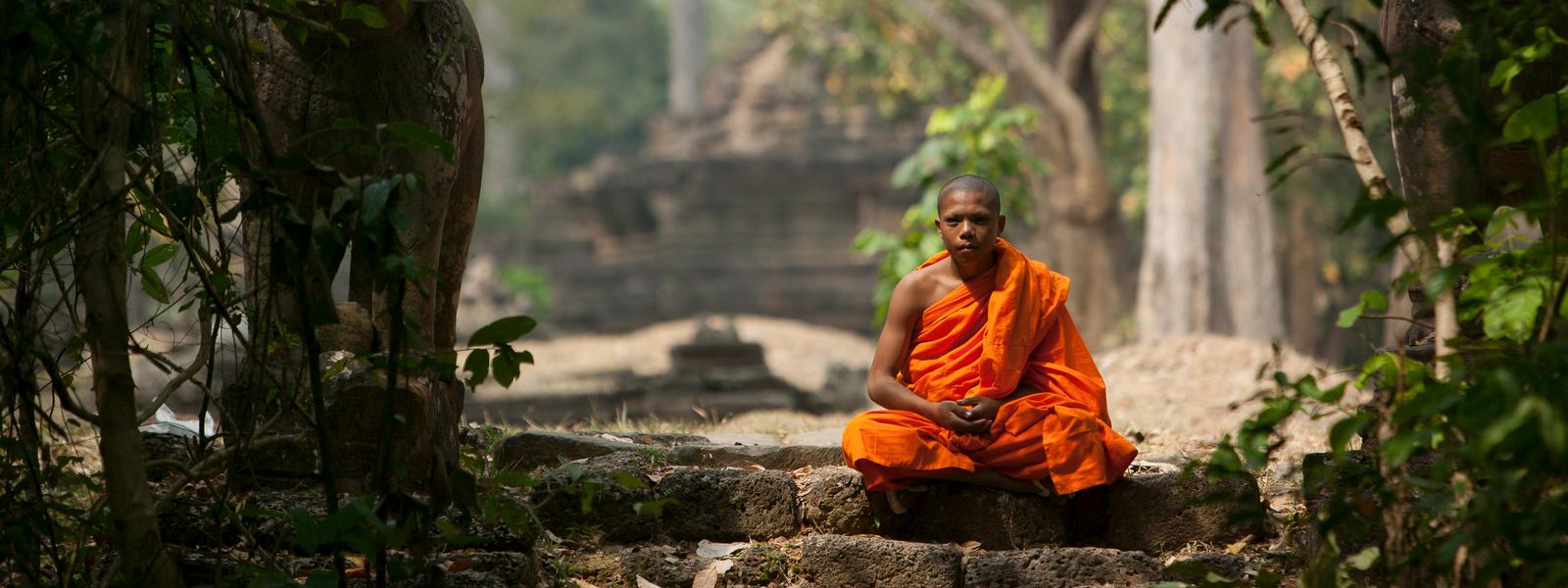
When to go to Cambodia
When is the best time to visit Cambodia?
The best time to visit Cambodia is during dry season, which runs from October to April. The wet season runs from May until September, with the heaviest rainfall generally in August & September. Average temperatures range from 24°C in the cooler months of October, November & December to 35°C at the hottest time of the year from March until June.
Cambodia weather & when to go
Pick a month below.
Weather seasons are becoming less predictable but peak visitor months remain more certain.
Unfollow the herd - avoid the peak months to enjoy fewer crowds, better availability, often lusher countryside and help to spread the economic benefits of tourism.
Weather overview
Cambodia is blessed with one of Asia's simpler weather systems. The country has two distinct weather seasons, but you can travel in Cambodia all year round.
In general, the entire country is subject to the same weather patterns, mainly due to the relatively uniform altitude and latitude throughout Cambodia.
Cambodia weather and seasons
There are two distinct seasons – dry (October to late April) and wet (May to late September). Within each season there are variations in temperature, with the final few dry months leading up to the wet season (March and April) and the early months of the wet season (May and June) usually being the hottest of the year with temperatures in excess of 35°C at times.
Humidity is at its highest during March and April whilst the coolest months of the year tend to be between October and December, however this is cool for Cambodia but far from chilly with average temperatures hovering around 24°C-26°C.
The Dry Season in Cambodia
October - april/early may.
Cambodia's dry season lasts from October to April, when the dry north-east monsoon arrives, characterised by hot wind blowing across the entire country. Whilst November to January are quite cool (high 20°C's), by April the weather is scorching making early morning and late afternoon Angkor Temple tours, with a few hours by the hotel pool at lunchtime, the preference for many.
Thanks to the hot weather this is unsurprisingly the season when Cambodia's tourist numbers peak.
In more remote parts, such as the north east regions of Mondulkiri & Ratanakiri , the roads are at their best and journey times are shorter because of this. Kep and Sihanoukville on the south coast are popular during this season as they bask in the brilliant sunshine and sea conditions are very favourable.
The Wet Season in Cambodia
Early/mid may - october.
Cambodia's wet season comes courtesy of the southwest monsoon and lasts from May to October, bringing with it almost 75% of Cambodia's annual rainfall. Across Cambodia, throughout much of the rainy season, daytime temperatures average between 25°C and 27°C. The early months of the wet season (May – July) remain very hot with infrequent rainfall usually in the form of short downpours. In the latter months (late July – September) the rain tends to becomes more constant and is heavy at times, especially in coastal and rural regions.
Travel in the more remote corners of the country, such as Mondulkiri & Ratanakiri, is almost impossible due to the state of the roads and journeys into the north east are inadvisable during the peak wet season because of this. There is also very limited access to Bamboo Island (near Kep) due to high seas.
Why travel to Cambodia during green season?
On the upside, travelling in monsoonal Cambodia does have its advantages. The dust is gone and the lush greenery of the countryside returns. Angkor Wat in particular is stunning in the wet season, with moats brimming with water and a severe drop in visitor numbers. High rainfall make it the perfect time of year to visit the flooded forests and floating villages of Tonle Sap Lake by boat, as it swells to more than 5 times its size during wet season.
You may like this journey…
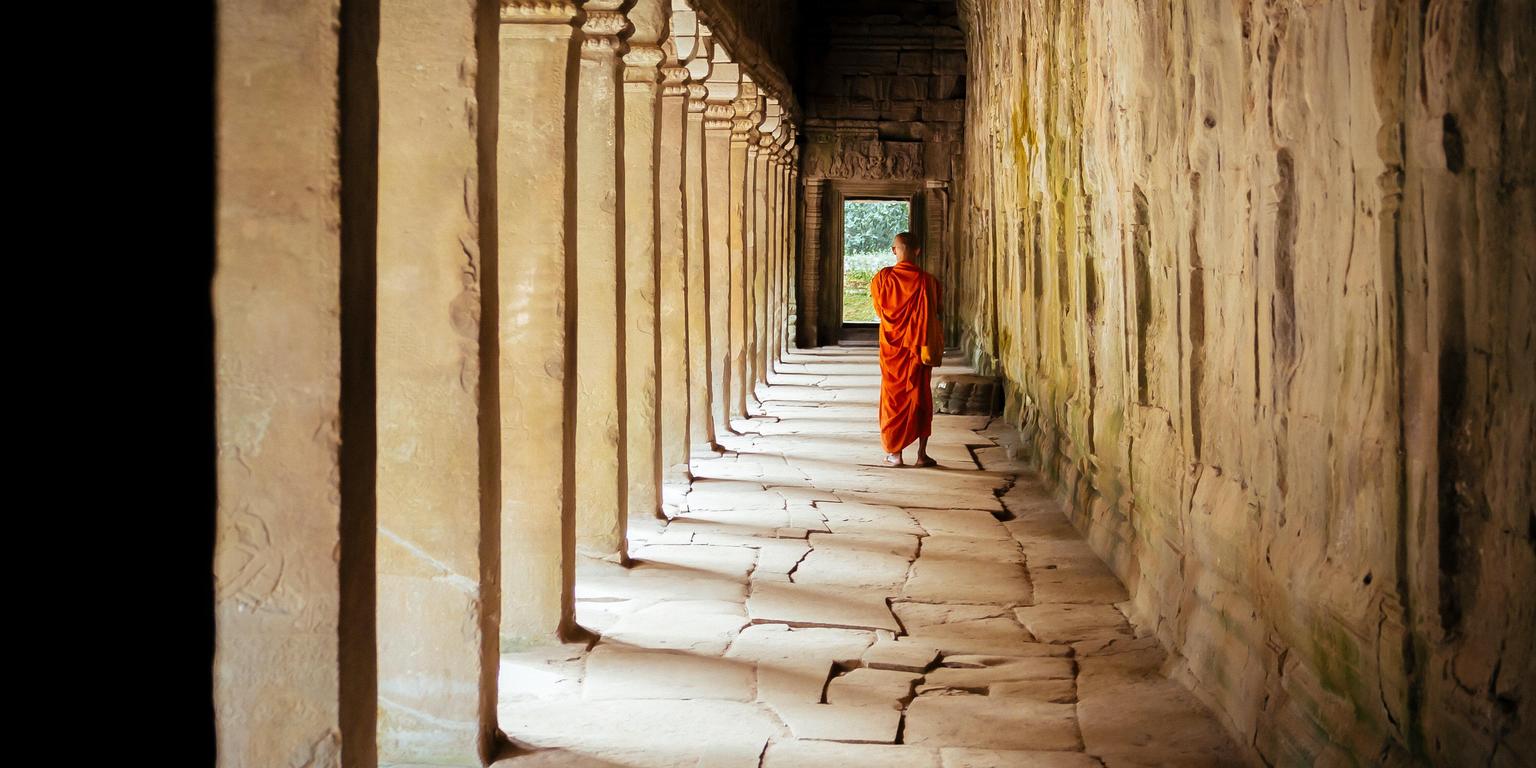
Cambodia Encompassed
Discover the true breadth of Cambodian culture by exploring the Angkor Temples, bustling Phnom Penh before heading to the Cardamon Mountains and rounding up with a few days on Cambodia’s islands.
Looking for inspiration?
The Best Time to Visit Cambodia for Weather, Safety, & Tourism
The best times to visit Cambodia for ideal weather are
November 19th to July 29th
based on average temperature and humidity from NOAA (the National Oceanic and Atmospheric Administration). Read below for more weather and travel details.
Cambodia Travel Guide
Temperature.
- Perceived Temperature
- Rain and snow
- Humidity and wind
- The busiest and least popular months
- Overall travel experience by time of year
Other Cambodia Travel Info
Weather in cambodia.
Average temperatures in Cambodia vary very little. Considering humidity, temperatures feel hot all year with a very low chance of rain throughout the year. The area is less temperate than some — in the 28th percentile for pleasant weather — compared to tourist destinations worldwide. Weeks with ideal weather are listed above . If you’re looking for the very warmest time to visit Cambodia, the hottest months are April, May, and then March. See average monthly temperatures below. The warmest time of year is generally mid April where highs are regularly around 96.2°F (35.7°C) with temperatures rarely dropping below 79.3°F (26.3°C) at night.
Cambodia Temperatures (Fahrenheit)
Cambodia temperatures (celsius), “feels-like” temperatures.
The way we experience weather isn’t all about temperature. Higher temperatures affect us much more at higher humidity, and colder temperatures feel piercing with high winds. Our perceived temperatures factor in humidity and wind chill to better represent how hot or cold the day feels to a person.
Cambodia Perceived Temperature (F)
Cambodia perceived temperature (c), average cambodia temperatures by month.
Daily highs (averaged for the month) usually give the best indication of the weather. A significantly lower mean and low generally just means it gets colder at night.
Show Fahrenheit
Show celsius, precipitation (rain or snow).
If dry weather is what you’re after, the months with the lowest chance of significant precipitation in Cambodia are February, January, and then March. Note that we define “significant precipitation” as .1 inches or more in this section. The lowest chance of rain or snow occurs around early to mid January. For example, on the week of January 8th there are no days of precipitation on average. By contrast, it’s most likely to rain or snow in early September with an average of 2 days of significant precipitation the week of September 3rd.
Chance of Precipitation
The graph below shows the % chance of rainy and snowy days in Cambodia.
Snow on the Ground
The graph below shows the average snow on the ground in Cambodia (in).
Average Rain and Snow by Month
Show inches, show centimeters, humidity and wind.
Cambodia has some very humid months, with other comfortably humid months. The least humid month is March (51.2% relative humidity), and the most humid month is September (71.4%).
Wind in Cambodia is usually calm . The windiest month is July, followed by June and August. July’s average wind speed of around 6 knots (6.9 MPH or 11.1 KPH) is considered “a light breeze.” Maximum sustained winds (the highest speed for the day lasting more than a few moments) are at their highest in early to mid June where average top sustained speeds reach 14.8 knots, which is considered a moderate breeze.
Relative Humidity (%)
The graph below shows the average % humidity by month in Cambodia.
The graph below shows wind speed (max and average) in knots.
Average Wind Speeds
Show wind speeds.
All wind speeds are in knots. 1 knot = 1.15 MPH or 1.85 KPH.
Show Relative Humidity by Month
Is it safe to travel to cambodia.
Our best data indicates this area is somewhat safe, but with extra warnings in a few regions. As of Dec 04, 2023 there are travel warnings and regional advisories for Cambodia; exercise a high degree of caution and avoid some areas. Check this page for any recent changes or regions to avoid: Travel Advice and Advisories . This advisory was last updated on Nov 27, 2023.
The Busiest and Least Crowded Months
The busiest month for tourism in Cambodia is January, followed by July and May. Prices for hotels and flights will be most expensive during these months, though you can save if you purchase well in advance. Tourists are unlikely to visit Cambodia in August. Those willing to visit at these times will likely find it the least expensive month.
Estimated Tourism by Month
Most popular months to visit, overall cambodia travel experience by season, spring (march through may).
Humidity and temperatures combine to make this season feel very warm. Highs range from 96.2°F (35.7°C) and 92.9°F (33.8°C) with similar temperatures in the later months. Rain is extremely rare with 0 to 1 days of significant precipitation per month. Spring is the second busiest for tourism, which makes it a good time for those looking for things to do.
Summer (June through August)
The middle-year months have very comfortable weather with high temperatures that are quite warm. These months see moderate precipitation with 2 to 5 days of precipitation per month. June – August is fairly slow season for tourism in Cambodia, so lodging and other accommodations may cost slightly less.
Fall (September through November)
Fall daily highs range from 89.8°F (32.1°C) and 87.9°F (31.1°C), which will feel very nice given the humidity and wind. It rains or snows a significant amount: 2 to 7 days per month. Tourism is the slowest during these months due to the weather, so hotels may be affordably priced.
Winter (December through February)
Weather is perfect this time of year in Cambodia to be enjoyable for warm weather travelers. The average high during this season is between 92.9°F (33.8°C) and 86.1°F (30.1°C). On average, it rains or snows a insignificant amount: consistently 0 times per month. These times of year are the busiest with tourists.
Best Times to Travel › Cambodia
Similar Destinations
- Phnom Penh City Centre, Cambodia
- Phnum Pénh, Cambodia
- Phnom Penh, Cambodia
- Ta Khmao, Cambodia
- Kampong Seila, Cambodia
- Bronze Lake, Cambodia
- Kampong Thom, Cambodia
- Elephant Mountains, Cambodia
- Mekong Lowlands, Cambodia
- Kampong Cham, Cambodia
Popular Destinations
- Udon Thani, Thailand
- Washington, DC, US
- Bandung, Indonesia
- Deutschland
Best Time To Visit Cambodia
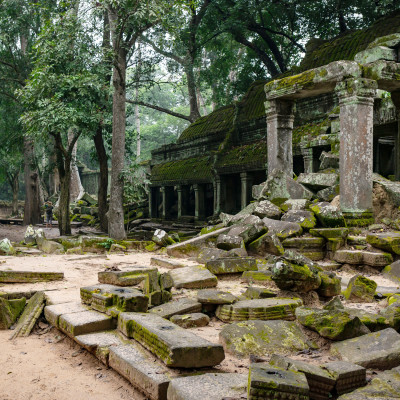
Bask in sunshine all year round in Cambodia
Cambodia has a warm or hot tropical weather which is relatively consistent throughout the year. The average temperature is around 80ºF. There are two seasons, the humid and rainy monsoon season which spans from June to October, and the dry season which is from November to May. The coolest months for our Cambodia tours, Mekong river cruises and Angkor Wat tours, considered some of the best things to do in Cambodia , tend to be from December to January.
Best Time To Visit
We recommend.
- Visit the island paradise of Koh Rong, known for its pristine white sand beaches
- Give in to the charms of the riverside town of Kampot
- Explore the magnificent Angkor Wat temple complex
- Live the slow life in Kep
- Go trekking in the lush Cardamom mountains
- Unwind beachside in Sihanoukville
- Disconnect from the outside world at Koh Rong Samloem island
- Welcome the Cambodian New Year or Chaul Chnam with wild waterworks
- Join the Chat Preah Nengkal or Royal Ploughing Ceremony celebrations in Phnom Penh
- For some French charm and unforgettable sunsets, head to Kratie
- Treat yourself to a traditional Cambodian massage
- Unravel hidden secrets at the Sambor Prei Kuk Temple at Kampong Thom
- Learn the nuances of Cambodian cuisine in a master chef-led culinary session
- A history lesson awaits at the War Museum in Tuol Sleng
- Witness a traditional Apsara dance performance in Siem Reap
- Explore Cambodia’s culinary specialties – tarantulas, crickets, grasshoppers and more!
- Float down the Tonle Sap river and visit its floating villages
- Drive down the Cambodian countryside – lush and green after the rains
- Hike to the waterfalls of Ratanakiri
- Discover the charms of Battambang
- Witness boat races and get soaking wet at the Bon Om Touk or Water Festival at Phnom Penh
- Marvel at the architecture of the Preah Vihear Temple, a UNESCO World Heritage site
- Swim with elephants at the Elephant Valley Project in Mondulkiri
- Visit the Angkor Night Market
What to Pack for Cambodia
Since the weather is consistently warm throughout the country, it is advisable to bring comfortable, lightweight and loose-fitting cotton clothing as well as long-sleeved items for protection from mosquitoes and the sun. During the rainy season, an umbrella and open-toe sandals are recommended. A jacket may be needed in hotels and restaurants using excessive air-conditioning. A hat and high-factor sun block is advisable for protection against the hot sun when sightseeing.
November – March: You could experience short and intermittent downpours so be sure to carry a reliable rain jacket and rain shoes. Temperatures are warm to hot, so light cotton clothes are advisable
April – June: The weather can be hot during peak season, so be sure to carry a good sunscreen (SPF 30+), sunglasses and lightweight clothes. You might want to carry swimwear to relax in your hotel pool during the hottest part of the day.
July – October: It’s the rainy season so carry an umbrella and light rain gear such as a waterproof jacket and footwear that will dry out easily.
While observing modesty in dress, please keep in mind that modest behavior is also appreciated. Public displays of affection, even between spouses, are considered unseemly.
Explore our Cambodia vacation packages for more inspiration and get in touch with us to plan your own completely customized, private Cambodia tours.
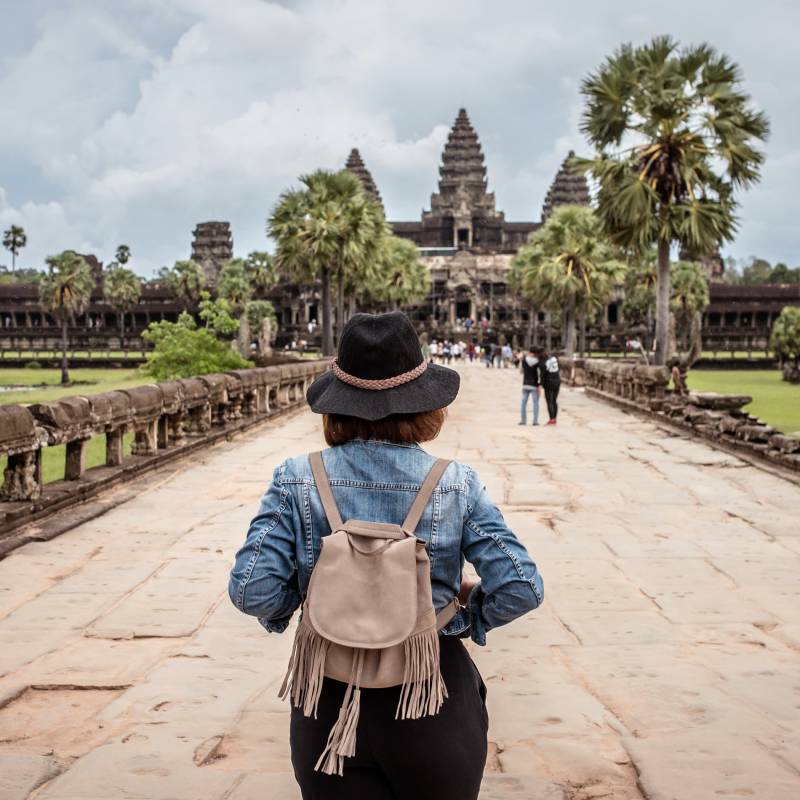
Popular Trips to Cambodia
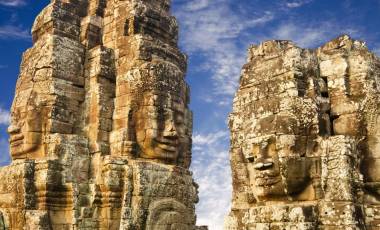
Highlights of Vietnam & Cambodia
Experience the rich cultures of Vietnam and Cambodia on this immersive 17 day tour. In Vietnam, learn more about Hanoi’s past, cruise along the Halong Bay, discover quaint historical villages and take in the impressive architecture of Hoi An. Go across the border to Cambodia, where ancient temples and distinct cultural experiences await you. From…
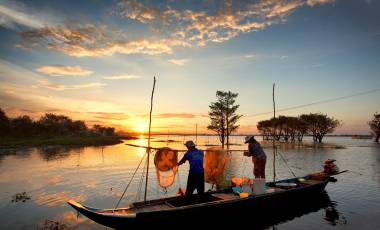
Vietnam & Cambodia: Cruising the Mekong River
Discover Southeast Asia as you cruise from Vietnam to Cambodia and experience life along the Mekong. Start your journey from vibrant Ho Chi Minh City and discover its fascinating culture and heritage on an invigorating walking tour. Later, head to My Tho, the starting point of your cruise. Every day aboard the cruise is an…

Temples and Beaches of Cambodia
Discover the top attractions in Cambodia on this private tour. Begin your tour in Siem Reap with a personalized excursion to the magnificent Angkor Wat temples. Next, take a custom bike trip in Battambang to explore its markets and architecture, and meet local families in the idyllic countryside. Visit the historic Wat Banan Temple with…

Best Places To Visit
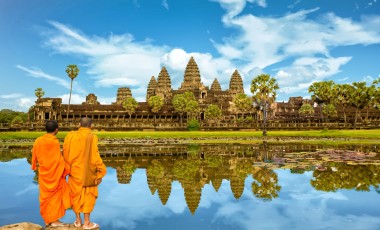
Siem Reap is a most marvellous window to the world famous UNESCO World Heritage Site Angkor Temple complex, with its fascinating Khmer architecture in varying states of preservation.
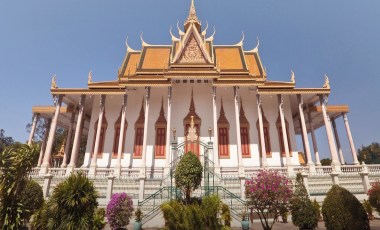
Phnom Penh offers a heady mix of bustling city life and a sincere cultural experience. It’s a harmonious blend of the past and present, tempered with delicious Khmer and French cuisine.
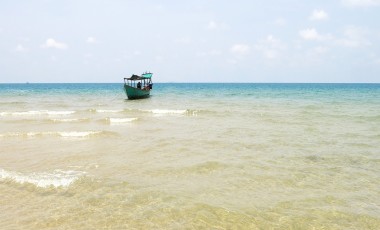
As a new Cambodian city, Sihanoukville doesn’t have a long history.
Sihanoukville
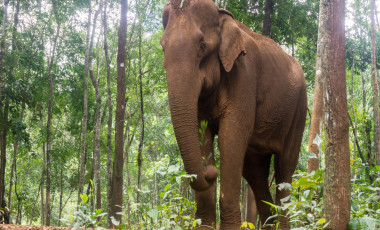
Mondulkiri, otherwise known as a the ‘Meeting of the Hills’, is located within the eastern highlands of Cambodia, and it is not only the country’s largest provinces, it is also the most sparsely populated and boasts a uniquely cool climate – in fact it can get chilly at night.
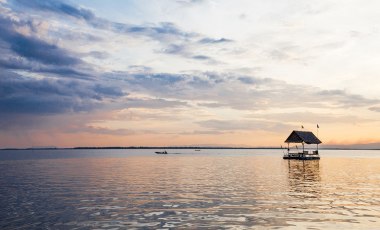
Battambang is a province in the ‘heart of the Cambodian rice bowl’.

Kep is a quiet beach town in Southern Cambodia, located on a rugged but scenic coast with a small stretch of sand enveloped by mangrove forests.
Things To Do
There’s more to Cambodia than Angkor Wat. On your tour, experience the best of the fascinating culture, heritage, and blissful beaches. Our destination experts share an overview on the most popular highlights, attractions and activities.
Travel Guide
With a culture and traditions steeped in history, you can expect a fusion of local traditions with religious customs. From language to currency, health, safety and communications, read more about what to expect while traveling in Cambodia.
From the Blog
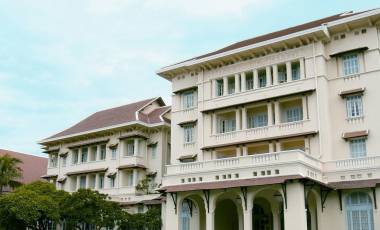
Discover Cambodia’s French Colonial Architecture
Famed and most visited for Siem Reap and UNESCO World Heritage Site Angkor Wat which many call a feat of planning and construction, Cambodia’s cities possess a wealth of stunning colonial buildings.

Undiscovered Cambodia and Vietnam Destinations
Go off the beaten track on your vacation in Southeast Asia and discover unique hidden gems, tucked away amid misty mountains, rolling valleys, rice terraces and emerald bays.
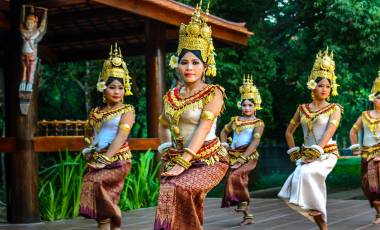
Being a Culture Vulture on your Cambodia Trip
From unique architecture and cultural flair to culinary delights and an inspiring NGO, unearth the charms of authentic Cambodia. Cambodia Trip: The Angkor Village Resort & Spa in Siem Reap The Angkor Wat Temple Complex in Siem Reap is every history enthusiast’s dream.
What Our Guests Say

The Enchanting Difference
Authentic & unique.
Our award-winning, licensed local guides provide incredible insights and exclusive experiences for you.
Personalized & Private
Our experts completely customize your private tour to match your interests and preferences.
High-Quality Experiences
All our accommodations and services are personally tested by our team.
Fully Supported Travel
You’ll have a personal and dedicated trip coordinator, backed by 24/7 support in case of emergencies while you’re traveling.
Financial Protection & Flexibility
Your booking is flexible and completely secure with us.
Safe & Secure
Your safety and well-being are our top priorities.
Do you have a vacation in mind? Personalize your itinerary with our Trip Builder.
- € EUR
When Is the Best Time to Visit Cambodia?

Published on: January 31st, 2024
Last modified: January 31st, 2024
The best time to visit Cambodia is during the dry season from November to March, which promises clear skies and coolest temperatures of 30°C (86°F). To avoid the peak season crowds opt for the shoulder season months; May or October, or the wet season from June to September if you don’t mind some rain.
Cambodia really is lovely year round, so the best time to go depends on what’s most important to you. We’ve put together this detailed climate guide to explain the hottest, coolest, most humid, least crowded and all-around best times to travel to Cambodia.
Cambodia Month-by-Month Weather Guide
Although it’s relatively warm all year round, Cambodia experiences different weather in each season. Generally speaking, it can be divided into the dry season (November to May) and the wet season (April to October), but every month has specific conditions. To help you know what to expect, we’ve put together a month-by-month climate guide to Cambodia.
Cambodia in January
Best for cool weather.
January is one of the driest and coolest months in Cambodia – although here, ‘cool’ means 26ºC (79ºF) on average. The clear weather attracts lots of visitors to popular sites like Angkor Wat , so be prepared to face some crowds. Visit Phnom Penh in early January to catch local Victory Day parties celebrating the 1979 fall of the Khmer Rouge regime.
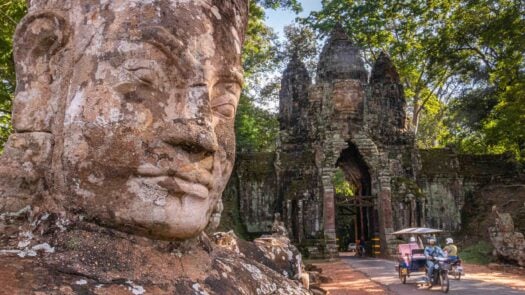
Cambodia in February
Best for clear skies… and giant puppets.
February in Cambodia is a slightly warmer month than January on average, although it tends to stay below 32ºC (90ºF). It’s also a popular time to explore Cambodia’s temples. On the last Saturday of February you can see the Giant Puppet Parade, a whimsical event in which children carry enormous puppets that they’ve created through the streets of Siem Reap .
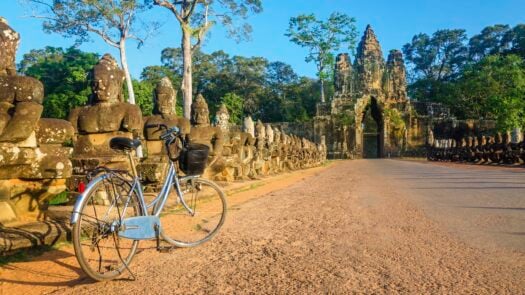
Cambodia in March
Best for sightseeing.
March marks the beginning of Cambodia’s hot season, with temperatures climbing as high as 34ºC (93ºF). It’s a bit warmer and more humid than the preceding months, but still sees little rainfall, making it a popular time for sightseeing. International Women’s Day on 8th March has been declared a public holiday, highlighting the country’s ongoing work towards gender equality.
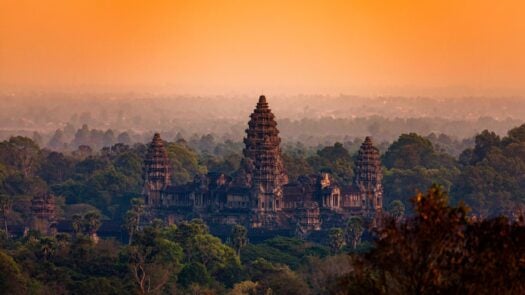
Cambodia in April
Best for small-town celebrations.
April in Cambodia is both the start of the rainy season and the month of the Khmer New Year. The rainfall is not too heavy yet so April is a good month for exploring all the usual destinations; just make sure to prepare for the heat – up to 35ºC (95ºF) – and stay hydrated.
To celebrate New Year in mid-April, lots of locals leave the big cities to spend time with family. This means you might get to experience local celebrations in more remote villages.
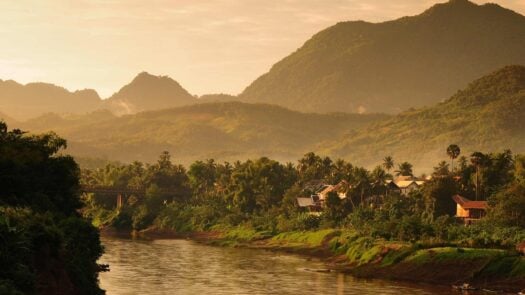
Cambodia in May
Best time to see the royal ploughing ceremony.
May in Cambodia is a month of mixed weather; warm temperatures, with some showers. The rain is sporadic and not too disruptive. May can feel very hot, with temperatures of around 34°C (93.2°F) which results in fewer visitors during the peaceful, shoulder season month of May.
The Royal Ploughing Ceremony in mid-May heralds the start of the rice-growing season. Two oxen predict the next seasons conditions, based on what they eat or drink during the ceremony.
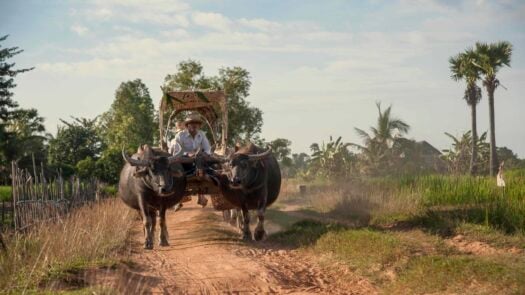
Cambodia in June
Best time to get a temple all to yourself.
June is when heavy rain starts to fall in Cambodia, turning the landscape a brilliant green. Many travellers avoid the wet season, which means that temples and other attractions are often less crowded. If you’re willing to risk getting caught in a downpour, you might even be lucky enough to get a whole site to yourself. Luckily, the rain tends to come in quick bursts with sun in between.
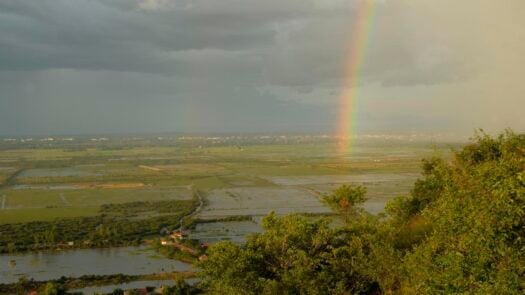
Cambodia in July and August
Best for the low-season lull.
July and August are right in the middle of monsoon season, so expect high humidity and heavy rainfall. The showers can bring down the temperature slightly to around 30ºC (86ºF), so if you prefer rain to heat, you’re in luck. July and August in Cambodia are typically delightfully quiet as crowds disperse to miss the rain.
July and August also boast lush scenery and abundant wildlife, making this one of the best times to go to Cambodia for nature lovers and photographers.
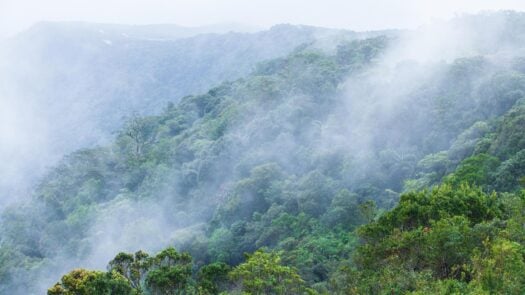
Cambodia in September
Best if you want to brave the rain.
Travelling to Cambodia in September is only for travellers who truly don’t mind rain. September is the wettest month of the year with cooler temperatures of around 31°C (87.8°F) across most of the country; Phnom Penh and Siem Reap for example.
It could be the best time to visit Cambodia for quiet temples, however heavy rain can make it harder to reach more remote destinations, making it tricky to get off the beaten track.
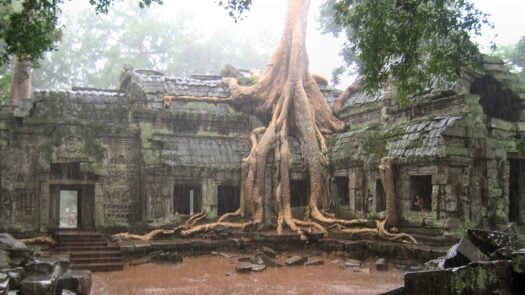
Cambodia in October
Best for experiencing ancestor’s day.
October in Cambodia falls right between the wet season and the dry season, which means it offers a good balance of smaller crowds and relatively nice weather – although it’s still extremely humid. Temperatures stay close to 30ºC (86ºF) and the rain starts to taper off as November approaches.
Another reason to visit Cambodia in October is to experience Ancestor’s Day (sometimes falling in September). During the festival Cambodians honour their deceased family members with elaborate rituals and offerings.
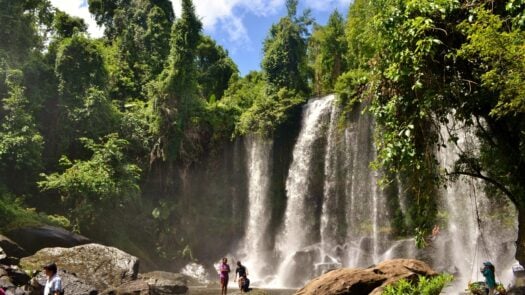
Cambodia in November
Best time to witness the water festival.
By the time November rolls around, the monsoon season is officially over in Cambodia. Conditions are dry and cool, with temperatures not typically exceeding 30ºC (86ºF).
This seasonal change is celebrated with the Water Festival (which sometimes falls in October instead), a celebration marking the annual reversal of the water flow between the Mekong and Tonle Sap rivers.
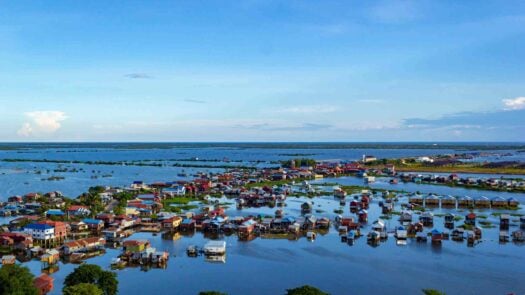
Cambodia in December
Best for a balmy winter holiday.
Cambodia’s weather in December is beautiful; clear, sunny and dry. Temperatures are manageable and not too hot at around 30ºC (86ºF). For this reason, December is one of the busiest months in Cambodia. Our travel designers recommend booking early to find the best exclusive, authentic and luxurious experiences and accommodations.
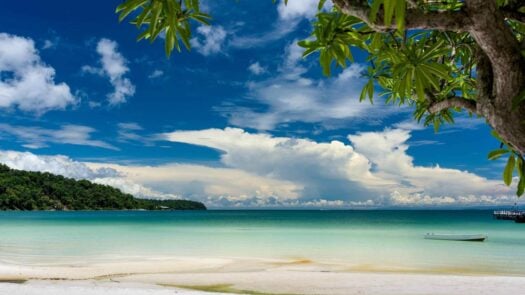
When Is Cambodia’s Monsoon Season?
Cambodia’s monsoon season runs from May to October, bringing intense showers and incredibly high humidity. The wettest months are usually August and September, with heavy rainfall on most days. The rainy season in Cambodia is also known as the green season, thanks to the lush green landscapes that bloom amidst the monsoons.
The Best Things to Do in Cambodia by Season
When it comes to choosing when to travel to Cambodia, it’s important to consider what you’re planning on doing. Certain activities are best enjoyed during specific months or broader seasons, and the weather can play a significant role in planning. With this in mind, we’ve compiled a list of the best things to do in Cambodia according to the time of year.
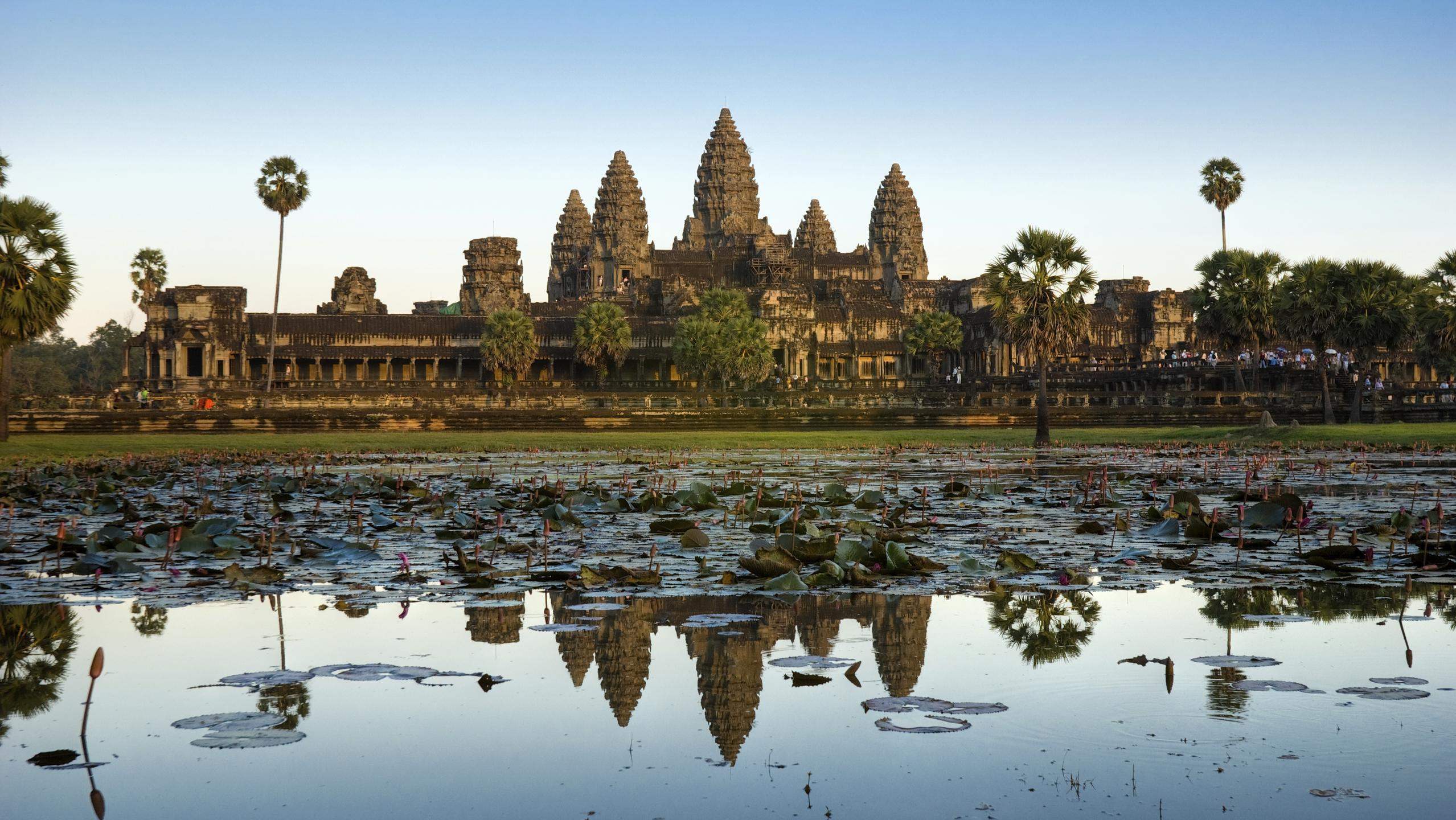
Explore Angkor Wat
October to February is the dry season in Cambodia and is generally considered the best time to see Angkor Wat in all its glory. Of course clearer weather is ideal for outdoor sightseeing – although keep in mind that this is also the most crowded time of year at the iconic temple complex. However, if your main motivation for travelling to Cambodia is to see its legendary temples, this is still the best time to visit Siem Reap and its surroundings.
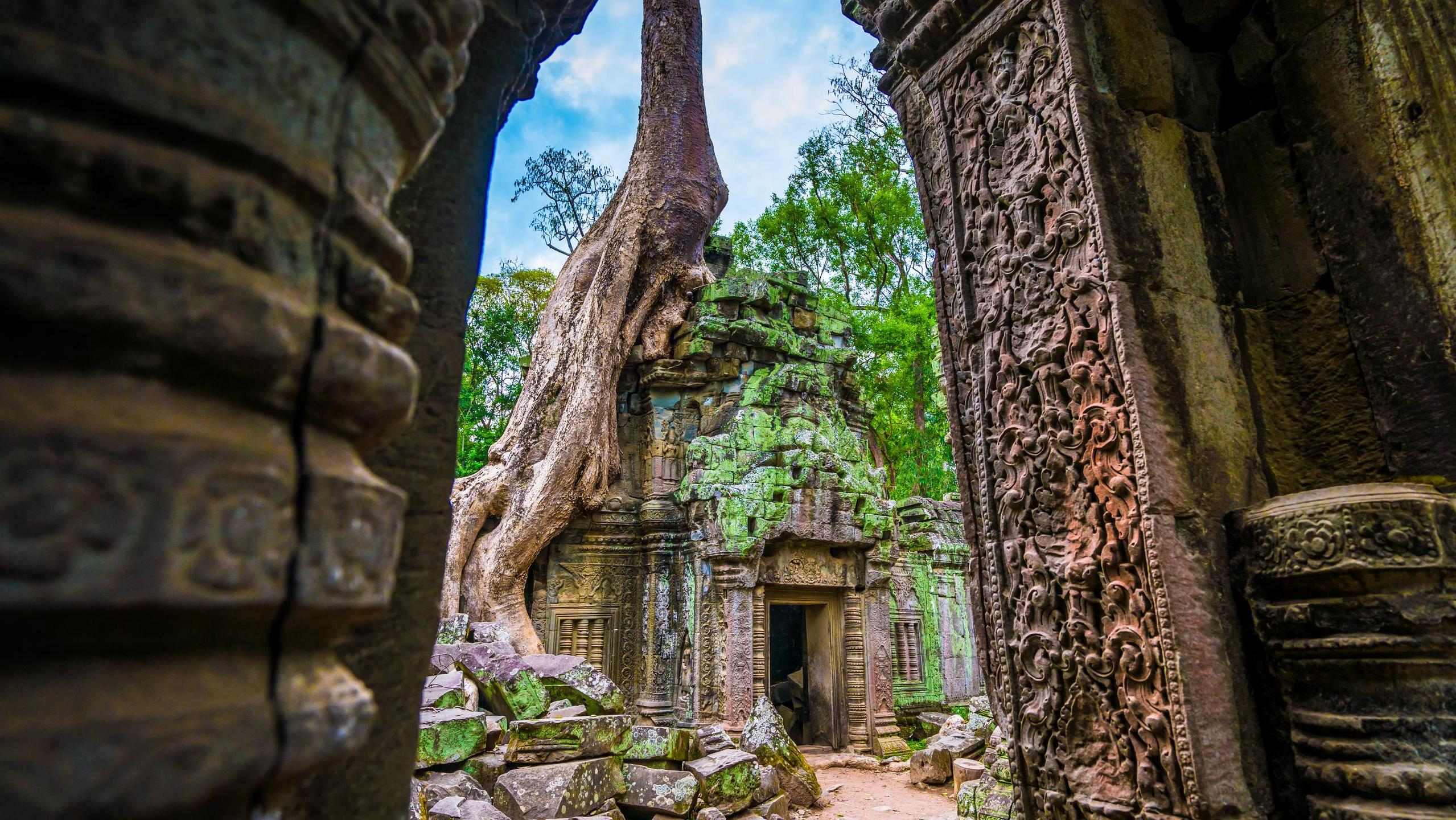
Discover Lesser-Known Temples
June through August are Cambodia's rainy months and are the low season in terms of tourism. These months can be the best time to visit Cambodia’s ancient temples which are now virtually empty. As long as you’re prepared for the possibility of being drenched by a sudden downpour, June through August can be the perfect time to explore sites like Banteay Srei, Ta Prohm and Beng Mealea.
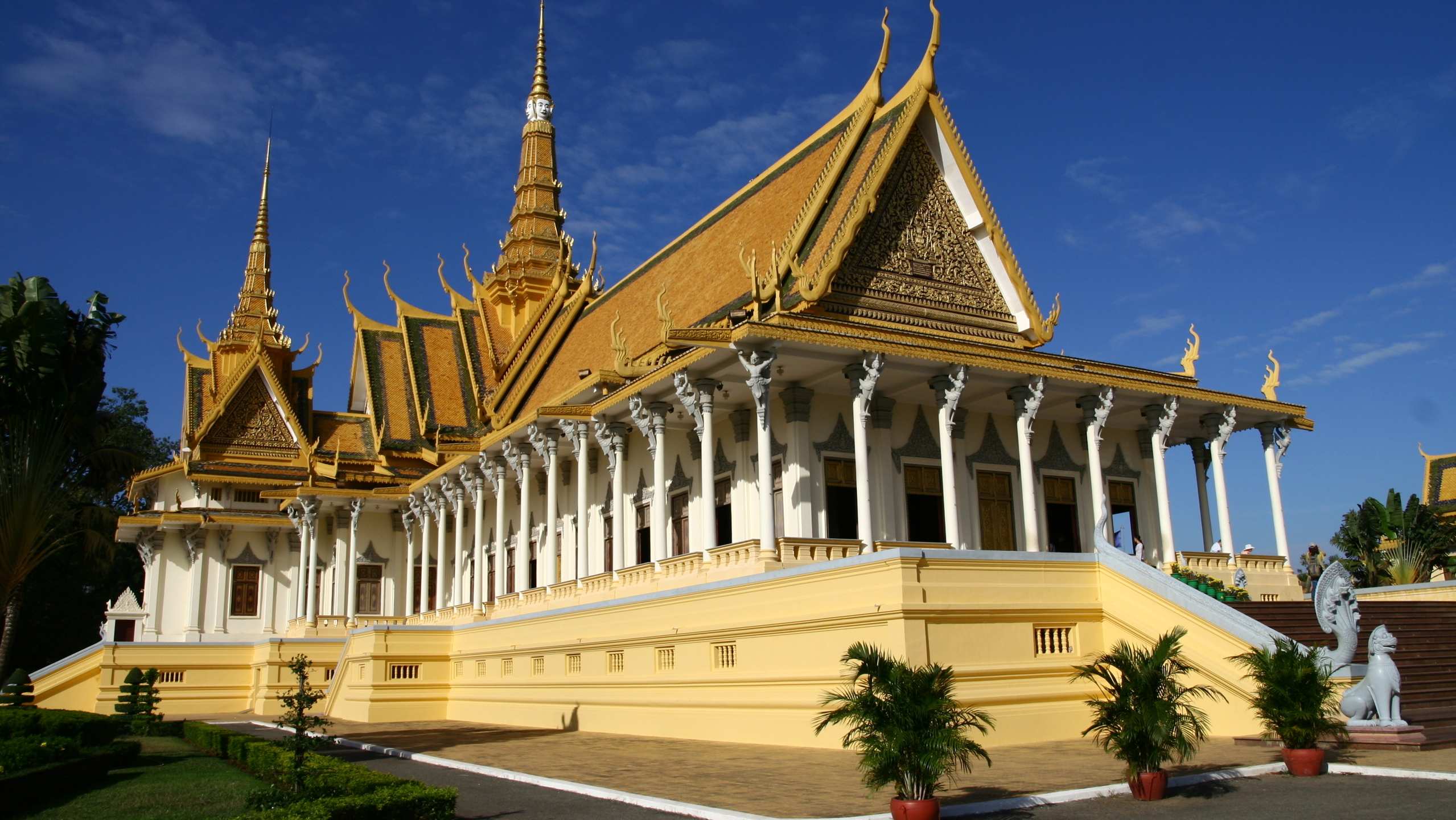
Visit Phnom Penh
Visiting the capital city of Phnom Penh is one of the best things to do in Cambodia beyond Angkor Wat. The dry season (October to April) is the best time to visit Phnom Penh for sightseeing; walking around the city, doing street food tours and wandering through the grand gardens of the Royal Palace.
Even if the weather isn’t cooperating, there’s still plenty to do here; stay inside at one of the city’s fascinating museums, take a cooking class or hole up in one of its many marvellous restaurants. The combination of traditional and fusion cuisine paints a delicious picture of the country’s cultural influences, identity and evolution.
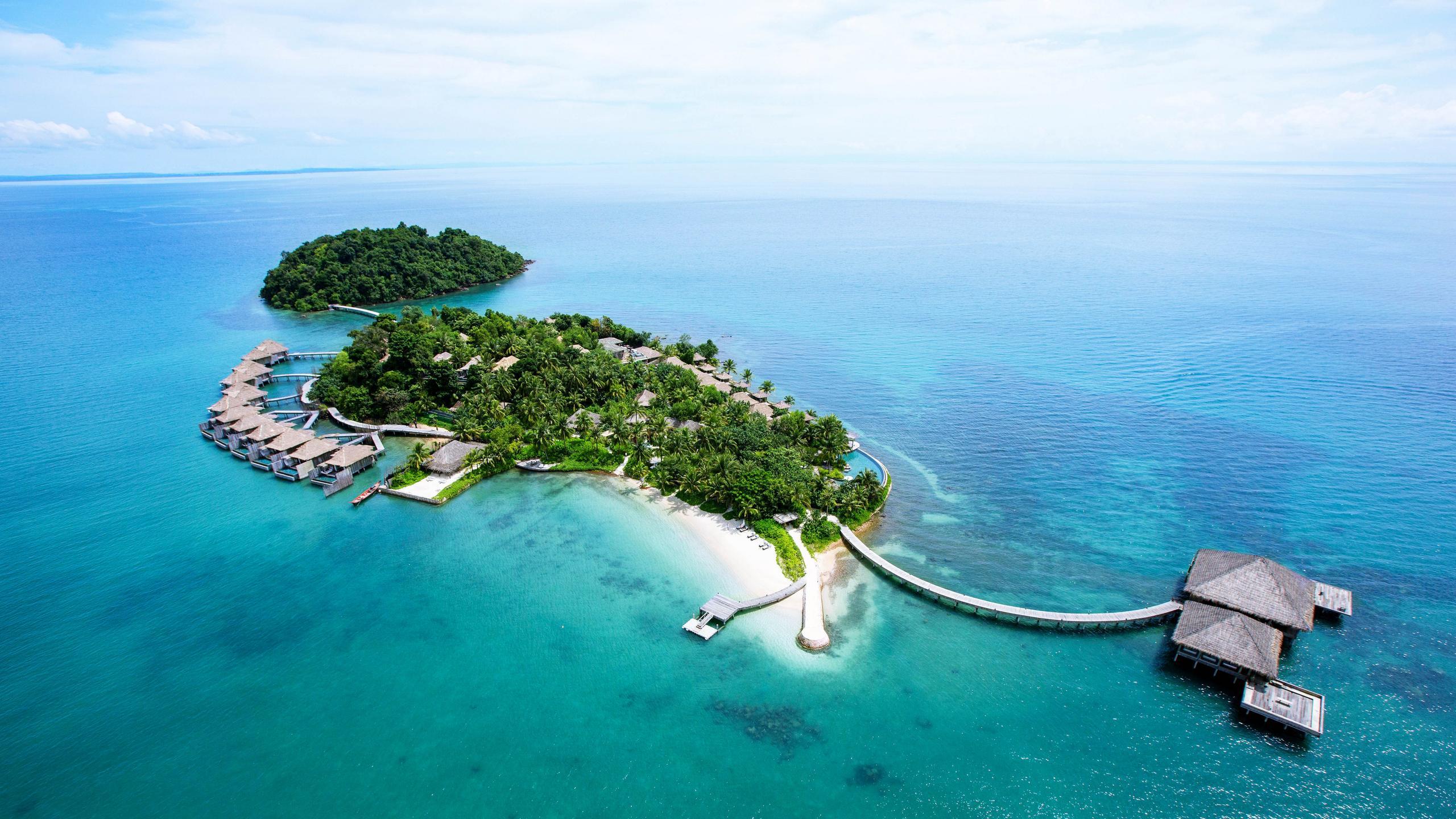
Escape to an Island Paradise
Few places on earth are as idyllic as the islands of Song Saa. As you might imagine, they’re best enjoyed when the weather is nice and clear. So, we suggest that the best time to visit Cambodia for beaches and islands is from November to April when rain is least likely.
We recommend staying at the gorgeous Song Saa Private Island Resort, which works to protect habitats and empower local communities through the Song Saa Foundation.
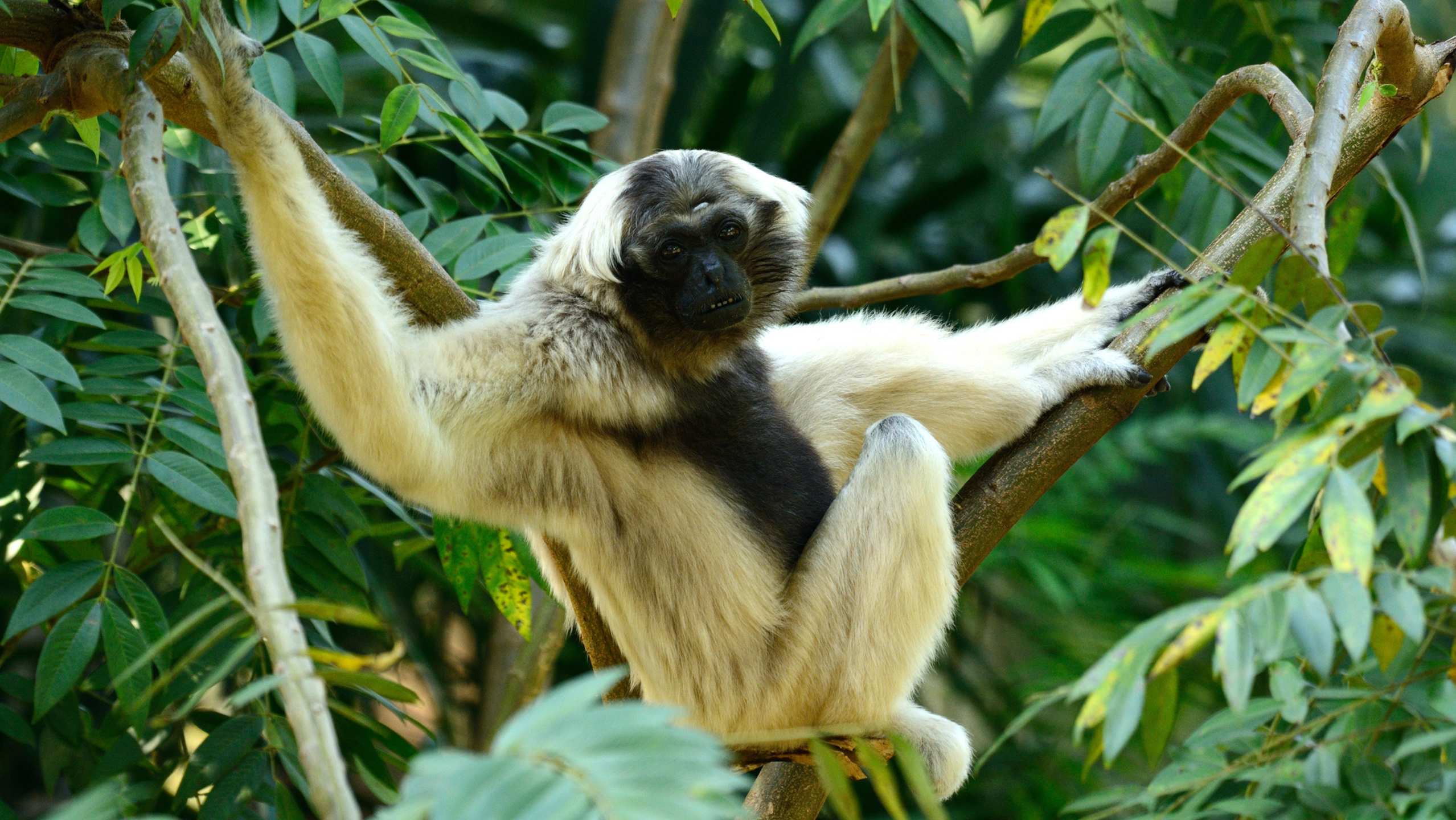
Spot Rare Species in Wild Cambodia
December to March is the best time to visit Cambodia for wildlife spotting. In southwestern Cambodia between Phnom Penh and the coast, you’ll find the pristine expanse of wilderness known as wild Cambodia where you can spot brilliant butterflies, tropical birdlife, elegant orchids and maybe even – if you’re lucky – a rare wild elephant.
Although there are fewer than 600 wild elephants in Cambodia, about half of them live here in the Cardamom Mountains. We suggest staying at Shinta Mani Wild to fully appreciate this extraordinary environment, whether you want to venture out into the wilderness or simply sit back and take it all in.
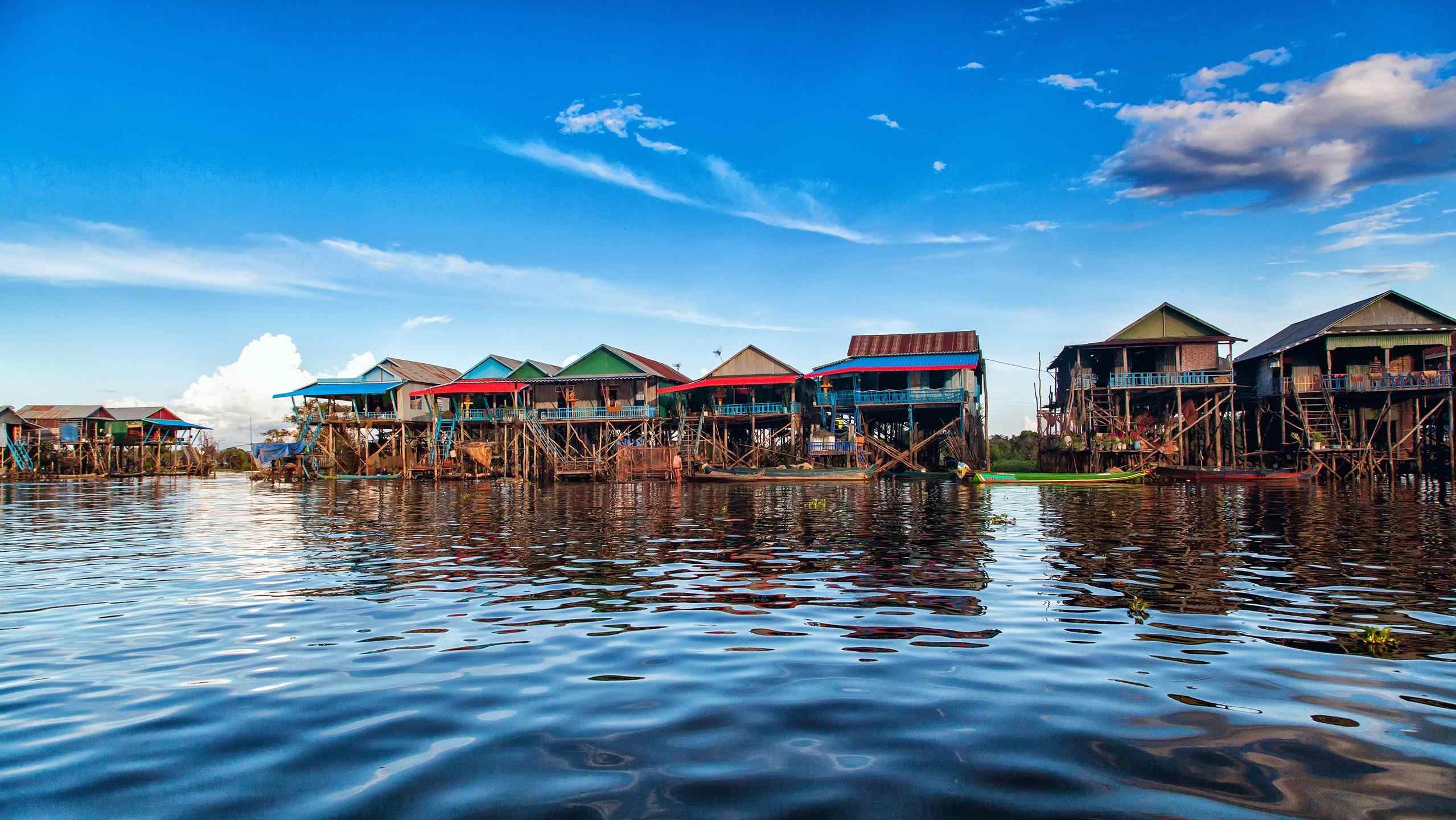
Glide Across Tonle Sap Lake
The best time to visit Tonle Sap Lake is during the monsoon season. From June to September the heavy rainfall causes the water level to rise significantly, making it a much more impressive sight than it is during the dry season.
Kayaking, boating or stand-up paddleboarding around the lake will allow you to observe this thriving freshwater ecosystem without disturbing the wildlife. You’ll also get a close-up view of local life in the lake’s floating villages and fishing communities, whose structures are built on bamboo rafts and stilts.
Trip Inspiration
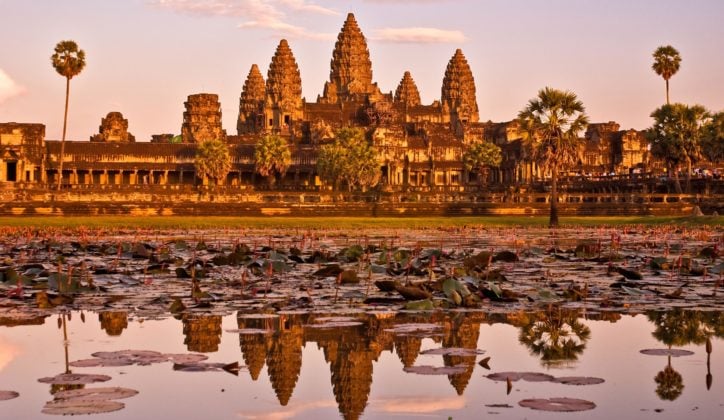
Whatever you want from your trip to Cambodia, our team of expert travel designers are ready to help.

Best Time Of Year To Visit Cambodia: Travel And Weather Tips
Share this post!

Cambodia is a great country to visit, and I highly recommend traveling there. However, the so-called “best” time of year to visit Cambodia is based on weather and crowds.
To determine the best time of year to visit Cambodia, you need to decide if you want the best weather, fewer crowds, or to enjoy one of the many events that occur throughout the year.
Keep reading to learn more about the best time of year to visit Cambodia and what times of year to avoid.
Last updated: April 15, 2024
Published: April 6, 2024
Some links on this page are affiliate links , meaning I may earn a commission if you click the link or make a purchase through the link. This is at no extra cost to you. This compensation may impact how and where links are placed on this site.
✈️ Win a free 5-night stay in Aruba! Click here to enter . The giveaway ends on May 9, 2024 at 12:00AM PDT. Exponential Travels is not administering this giveaway.
Planning a trip to Cambodia? Here are more travel guides you can use to plan the perfect trip:
- Angkor Wat Instagram captions
- Best time to go to Angkor Wat
- Best time to go to Cambodia
- Best time to go to Siem Reap
- Cambodia Instagram captions
- Cooking Class in Siem Reap
- Cambodia Safety Guide
- Should you visit Angkor Wat?
- Should you visit Cambodia?
- Should you visit Siem Reap?
- Tips for traveling to Cambodia
Table of Contents
What Is The Best Time Of Year To Visit Cambodia?

In Cambodia, the weather has a significant impact on travel. It has two main seasons: dry and wet. The dry season goes from November to April, while the wet season lasts from May to October.
The dry season is cooler and less humid, which many tourists like. The best time to visit is during the peak of the dry season, around December and January. It’s not too hot, perfect for visiting temples and exploring the countryside. But as the dry season goes on, it gets hotter, especially in April.
In the wet season, there are sudden heavy rains. However, everything becomes green and peaceful during this time, and fewer tourists are around.
When the wet season starts, the air cools down a bit, but it’s still hot. Expect short but intense rain showers, usually in the afternoon. These showers can give you relief from the heat and make the countryside look lush and beautiful.
If you want the best weather, visit Cambodia early in the dry season; however, you will find fewer tourists and lower prices in the wet season.
Peak vs. Off-Peak Season In Cambodia

Deciding when to go to Cambodia can make a big difference in your trip because of the different tourist seasons. The busy time, from November to March, is when many people visit because the weather is cooler and drier. Places like Angkor Wat are popular, and hotel prices can be high.
On the other hand, the quieter time is from May to early October when it’s wetter. There are fewer tourists, and things can be cheaper. Just be ready for sudden rains. But don’t worry too much: the rain usually doesn’t last long, and it will make everything look beautiful and green.
April and late October can be a good compromise between busy and wet times. There are fewer crowds, and prices might be more reasonable.
No matter where you go, Cambodia is always welcoming, and it has a rich culture and history.
Cultural Events And Festivals
In Cambodia, there are many cultural events and festivals all year round for visitors to enjoy.
One of the biggest is Khmer New Year, usually in mid-April. It’s a time for celebrations, games, visiting temples, and spending time with family.
Another important festival is the Water Festival, celebrated in November with boat races, fireworks, and parades, especially in Phnom Penh and along the river in Siem Reap .
In September or October, there’s ‘Pchum Ben,’ or Ancestors’ Day, when Cambodians honor their deceased relatives by doing rituals and offerings at temples for fifteen days.
These events give you a deeper insight into Cambodian culture and beliefs. But remember that they can also make places busier, so it’s smart to plan ahead and book things early for a smooth trip.
Tips For Visiting Cambodia

Ready to plan your trip to Cambodia? Here are some tips to follow to have a good, stress-free trip.
- Pack light , breathable clothes suitable for the hot climate.
- Bring sturdy walking shoes for exploring temples.
- Remember, wear a raincoat or umbrella if visiting from May to October.
- Always have sun protection like sunscreen , sunglasses , and a hat .
- Book accommodations in advance, especially during peak season from November to February.
- Learn a few Khmer phrases to show respect and connect with locals.
- Visit during the dry season for easier access to rural landscapes and outdoor activities.
- Dry months are also best for spotting wildlife, like birds, especially around Tonle Sap Lake.
By following these tips, you can make the most of your time in Cambodia.
You Choose The Best Time Of Year To Visit Cambodia!
In short, choosing the right time to visit Cambodia involves considering the weather, tourist seasons, and cultural events for the best experience.
Planning for the dry season will have the best weather for sightseeing, and traveling during cultural events will leave you with unforgettable memories, but be ready for higher prices and crowds during these times.
No matter when you visit Cambodia, there are pros and cons. You need to choose what’s important to you to determine the best time of year to visit Cambodia.
Ready to plan your trip? Here are some of the things I use every time I plan a trip:
- Top travel credit cards
- SafetyWing for travel insurance
- Booking.com for a huge variety of hotels, vacation rentals, flights, and more
- HostelWorld for the best hostels around the world
- Vrbo for vacation homes and rentals
- FareDrop and Going for cheap flight alerts
- Skyscanner for the cheapest flights
- Amazon for travel and packing must-haves
- Priority Pass for airport lounge access
- TripAdvisor for the top hotels around the world
Click for the top hotel deals!
Leave a Reply Cancel reply
Your email address will not be published. Required fields are marked *
Save my name, email, and site URL in my browser for next time I post a comment.
Notify me of follow-up comments by email.
Notify me of new posts by email.
Privacy Overview
Privacy Policy - Terms and Conditions

Here is a guide to Cambodia’s weather by month.
Cambodia in january.
January is one of the best times to visit Cambodia as the weather is dry and rain won’t stop you from exploring the country. The average temperature is around 26°C which makes the weather soothing enough for touring. If you are a beach lover, soaking in the sun on the beaches of the southern coast is a wonderful idea this time. You can also go for exploring Siem Reap and get amazed by the temples.
Average Temperature: 26
Cambodia in February
February is still cool and you can expect little drizzle this time. It will make the weather even more romantic. The average temperature sees a little rise as it is now around 27°C. The weather is soothing enough to explore the temples of Cambodia. You can also enjoy travelling through a river and the beautiful Tonle Sap is also bulky in volume to give you an enjoyable ride.
Cambodia in March
You can call March the peak season to visit Cambodia. The average temperature increases up to 30°C, but still, it is not too hot to roam around. The water levels of the lakes, especially Tonle Sap, start to decrease, so water rides may not be as exciting as it was in the previous months. Still, the overall weather condition is great to have some awesome trips around the country. The hotels are almost full this time, so you have to do a booking.
- Singapore Travel Packages
- Maldives Tour Itinerary
- Thailand Tour Packages
- Nepal Trip Itinerary
- Bhutan Travel Packages
- Dubai Holiday Itinerary
- Sri Lanka Tour Packages
- India Travel Itinerary
Cambodia in April
April is also considered the tourist season, though the temperature arises up to 33°C and the weather feels hotter. So, it is always recommended to arrange trips either in the early morning or late afternoon. The full-day excursions can be tiring as the sun shines brightly. April is the time of Khmer New Year and it is celebrated from the 13 th to the 17 th of April. The towns and cities become deserted this time as people visit their homes to spend time. So, it is always better to arrange your trip before or after this week. April may not bring many showers, still, you should carry an umbrella to be on the safe side.
Cambodia in May
May is not considered the peak season as it sees a bit of rainfall. So, if you want to avoid the regular crowd and want to have a peaceful holiday, May can be the best time to visit Cambodia for you. The showers won’t disturb your trip, rather it keeps the temperature below 30°C (29°C) and also lowers the humidity and make your trip comfortable.
Cambodia in June
June is the rainy season in Cambodia and enough rainfall brings smiles to the farmers. Is it a good time for tourists? It can be if you love monsoons and want to explore the temples and ruins without the promotional crowd. Though the temperature remains within 28°C, the humidity during the daytime can go up to 70%. It can make your trip a little uncomfortable.
Cambodia in July
Rainfall increases throughout the country while the temperature sees a decrease and becomes 27°C. Many beaches on the southern coast should be avoided this time and the temples are also deserted. The weather condition is perfect for European families as it gives them the right vibe of a summer holiday in Europe. This time is also suitable to explore many unknown and off-beat destinations in Cambodia.
Cambodia in August
If you are a wildlife enthusiast, August is the best time to visit Cambodia. Rainfall is more intense this time, but instead of an all-day downpour, it continues only for an hour or so. The temperature is soothing as it remains within the range of 26-27°C. Tonle Sap again gains its volume and travelling through waterways is more happening now. The flora and fauna are in full bloom this time and the lush greenery of the country will soothe your eyes.
Cambodia in September
The temperature remains unchanged, but September sees the maximum and heaviest rainfall of the year in Cambodia. If you want to visit the countryside this time, you have to be prepared for the weather condition. This time in the country is almost crowd-free, so you can get cheaper deals at the hotels and flights.
Cambodia in October
October is quite a good time to visit Cambodia as the rain begins to slow down and the country looks vibrant with the greeneries everywhere. The temperature is also soothing as it is 27°C now, perfect for roaming. October is also the time to celebrate Pchum Ben. It is a Buddhist Festival, celebrated throughout the country for 15 days and a final day celebration is a grand event where the locals participate with pomp and vigour. If you visit Cambodia in October, you can be a part of this local festival and tradition.
Cambodia in November
From November, tourists begin to visit Cambodia as a crowd once again. The weather is comfortable as the temperature remains 25°C and this is the perfect time to explore Tonle Sap Lake. As this is the peak season, the hotel tariffs can be higher than usual. So, you need to make a booking for that. November is also the time to celebrate Bon Om Touk or Cambodian Water Festival. This is one of the most gorgeous festivals to be celebrated in the country for three days. Several concerts, boat rides and races on Phnom Penh, etc. are organized. Plan a trip to Cambodia in November and have some great fun.
Cambodia in December
Christmas in Cambodia is something that can give you a unique vibe you may not have experienced before. Hotels are booked quite in advance, so you should not delay in making your plans. December is dry and the temperature is around 26°C. You get bright sunny days to explore the country and join the festive spirit.
So, now it will be easier for you to make your plans to visit Cambodia. Based on the weather condition each month, you can make your plans and have a wonderful vacation over there.
About The Author
Tusk Travel Team
Related posts.

Update: Cambodia Now Reopened for Indians Traveler

Cambodia is now open for fully vaccinated travellers
Leave a comment cancel reply.
Your email address will not be published. Required fields are marked *
Save my name, email, and website in this browser for the next time I comment.
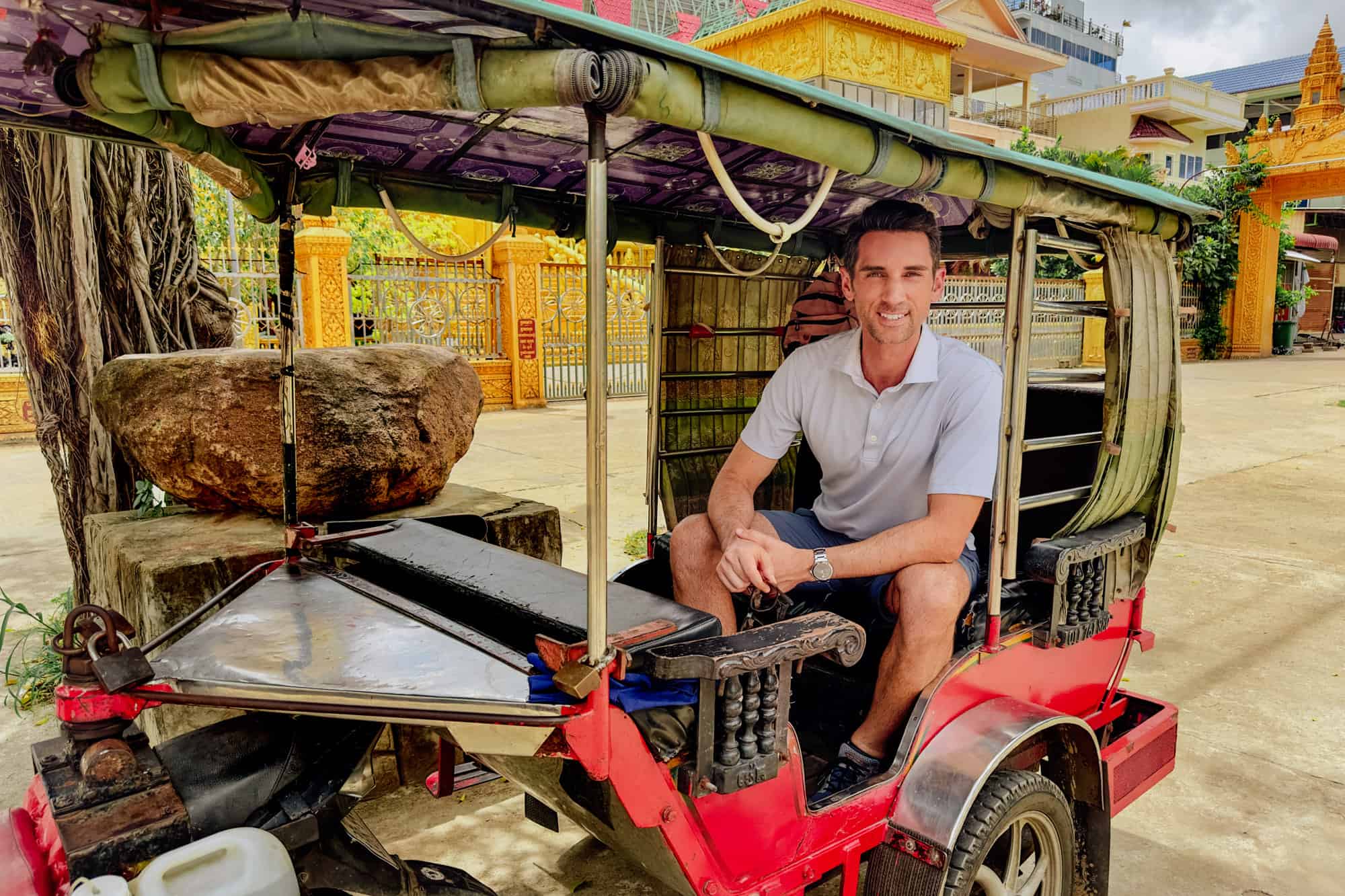
The Best Time to Visit Cambodia: Wet Vs. Dry Seasons

BY JARED DILLINGHAM
Cambodia, located in Southeast Asia, has a tropical climate with distinct wet and dry seasons. The best time to visit Cambodia largely depends on your preferences and what you want to do during your trip.
I’ll go into the weather for each season down below, and do a month-by-month breakdown of the pros and cons.
In general, these are the guidelines:
- ☀️ Best weather : November – February
- 💰 Best prices : June – August
- 👨👩👧👦 Smaller crowds : May – September
There’s a LOT of information down below, so click on the Table of Contents below to skip to the conditions in the month(s) you’re thinking of visiting Cambodia.
The Best Season to Visit Cambodia
Here’s a seasonal breakdown of the weather in Cambodia:
- November to February (Dry Season):
- Winter Weather: This is considered the best time to visit Cambodia as the weather is cool and dry. Daytime temperatures range from 25°C to 30°C (77°F to 86°F).
- Winter Highlights: Ideal for exploring temples like Angkor Wat, and enjoying the beaches in Sihanoukville and nearby islands. The water levels at Tonle Sap Lake are low, making it a good time for boat tours.
2. March to May (Hot Season):
- Spring Weather: Cambodia starts to heat up during these months, with temperatures often exceeding 35°C (95°F) in some areas. It’s still relatively dry in the spring.
- Spring Highlights: Despite the heat, spring is still a popular time to visit. It’s best for early morning temple visits and indoor activities. Consider Cambodia’s coastal areas for a bit of relief from the heat.
3. June to August (Wet Season – Monsoon):
- Summer Weather: These months bring heavy rainfall and high humidity to Cambodia. Expect daily afternoon downpours, especially in July and August.
- Summer Highlights: While it’s the rainy season, you’ll find lower prices at hotels. The landscape is lush and green, and the temples are far less crowded.
4. September to October (Transition Period):
- Fall Weather: Cambodia starts transitioning from the wet season to the dry season during these months. Rainfall decreases gradually.
- Fall Highlights: It can be a good time to visit Cambodia, if you don’t mind occasional rain showers. The Cambodian countryside is at its most vibrant, and the crowds are still small.
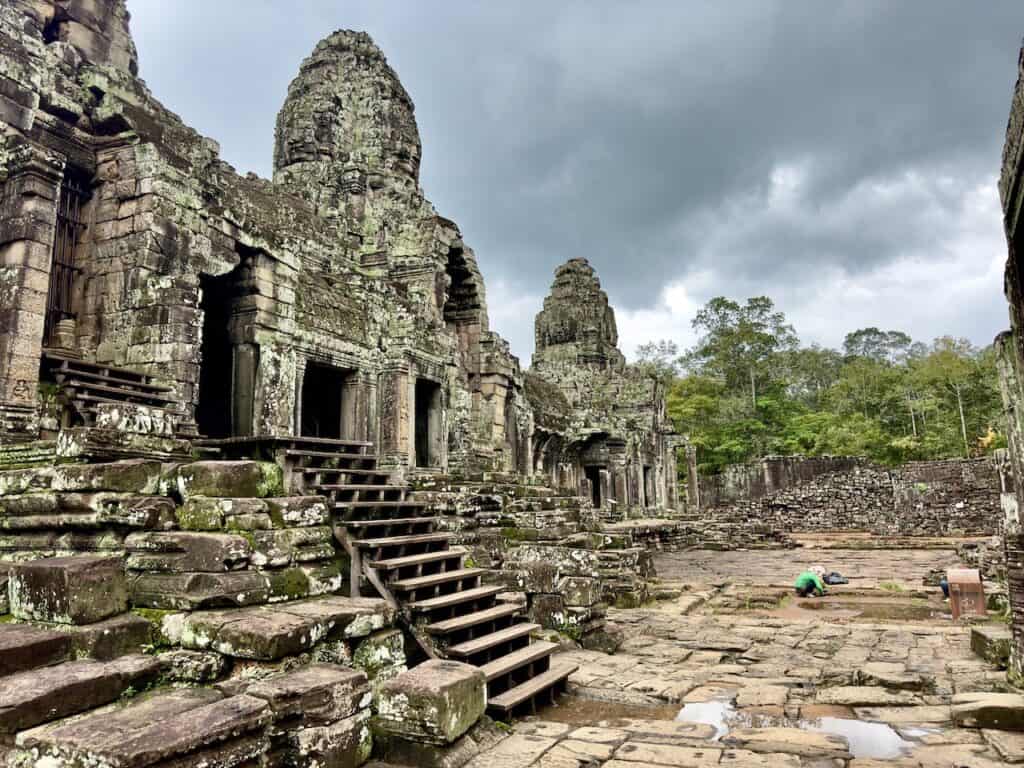
The Best Tours in Cambodia
Regardless of the season, you can enjoy tours of Phnom Penh, the Mekong River, and all of the mysterious and awe-inspiring temples around Siem Reap.
I’d recommend these top tours in Phnom Penh, any time of the year:
🇰🇭 Phnom Penh & Killing Fields Tour
🇰🇭 Click to Book: Silk Island Bike Tour
🇰🇭 Click to Book: Mekong Sunset Cruise
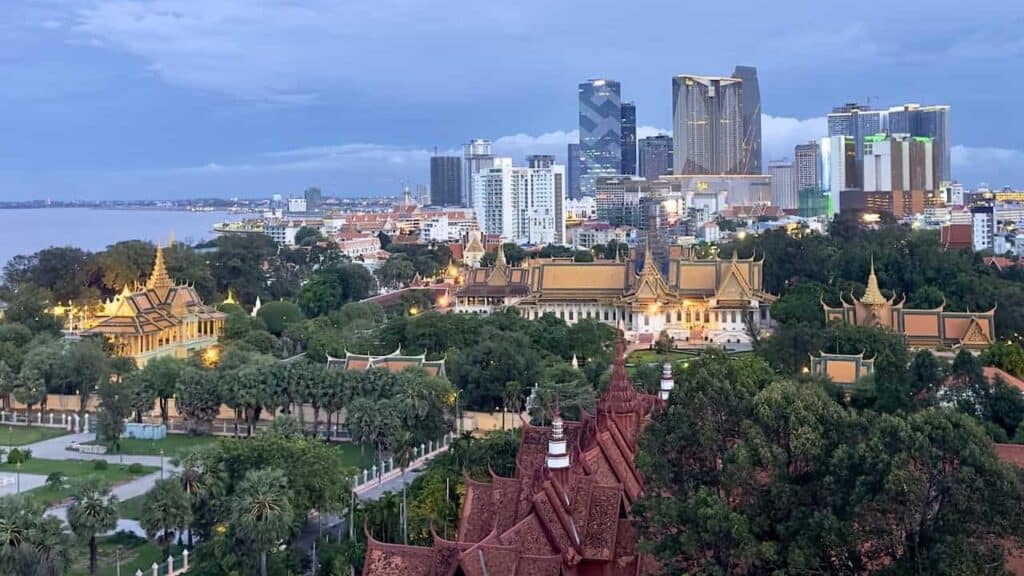
And I’d recommend these tours from Siem Reap:
🇰🇭 Angkor Wat Sunrise
🇰🇭 Angkor Wat & Other Temples
🇰🇭 National Park Waterfalls
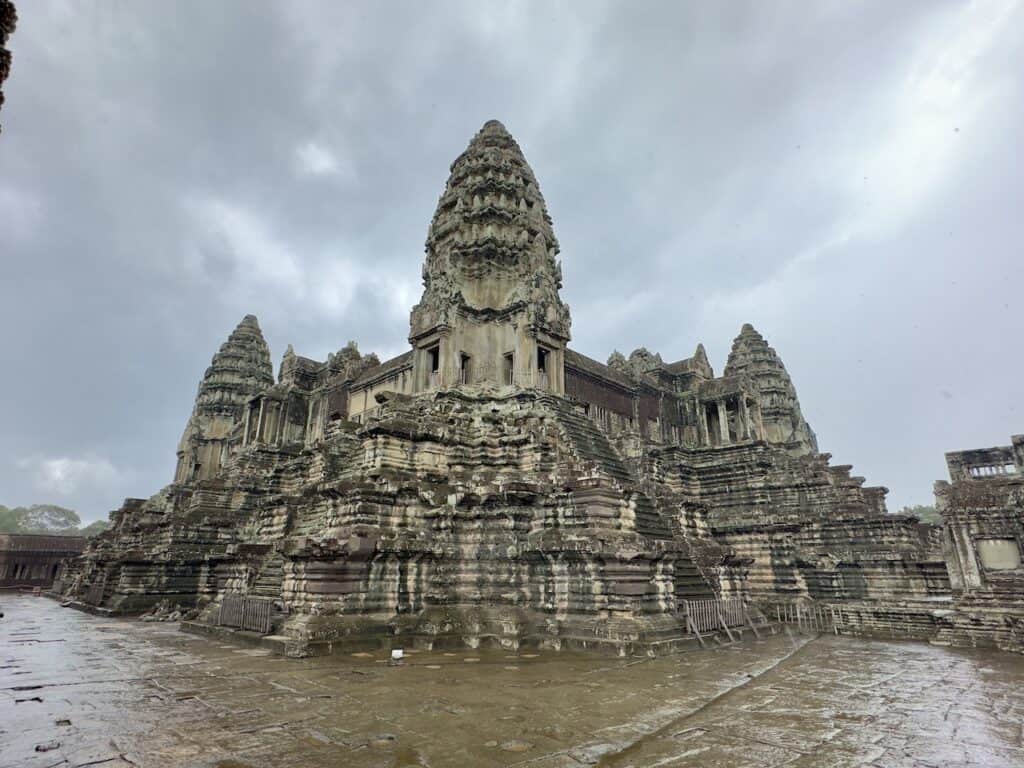
Visit Cambodia in January
January is generally considered to be one of the best times to visit Cambodia, simply due to the nice weather. Just keep in mind that this is the high tourist season, so accommodations and attractions may be busier and more expensive.
Pros of Visiting Cambodia in January:
- Ideal Weather: January is considered one of the best times to visit Cambodia in terms of weather. It falls within the dry season, offering cool and dry conditions with daytime temperatures ranging from 25°C to 30°C (77°F to 86°F).
- Clear Skies: January typically brings clear skies and plenty of sunshine, ensuring great visibility for photography and outdoor experiences.
- Perfect for Temple Exploration: The comfortable weather in January is ideal for exploring the temples of Angkor, including the iconic Angkor Wat. You can spend extended periods exploring these historical sites without the discomfort of extreme heat or rain.
- Festivities: Cambodia celebrates the New Year, and you can expect a festive atmosphere with celebrations, cultural events, and special activities, especially in urban areas like Siem Reap and Phnom Penh.
Cons of Visiting Cambodia in January:
- Peak Tourist Season: January is part of the peak tourist season in Cambodia. Popular destinations like Angkor Wat and coastal areas can get crowded, and accommodations may be more expensive.
- Higher Prices: Due to the high demand from tourists, you may find that prices for accommodations, flights, and tours are relatively higher in January compared to other times of the year.
- Limited Availability: It’s advisable to book your accommodations and tours well in advance, as the most sought-after options can fill up quickly during January.
- Traffic and Crowds: Urban areas like Siem Reap and Phnom Penh can experience heavy traffic and large crowds during the peak tourist season.
- Less Availability of Guides: Due to high demand, there may be limited availability of English-speaking guides for temple tours and other activities.
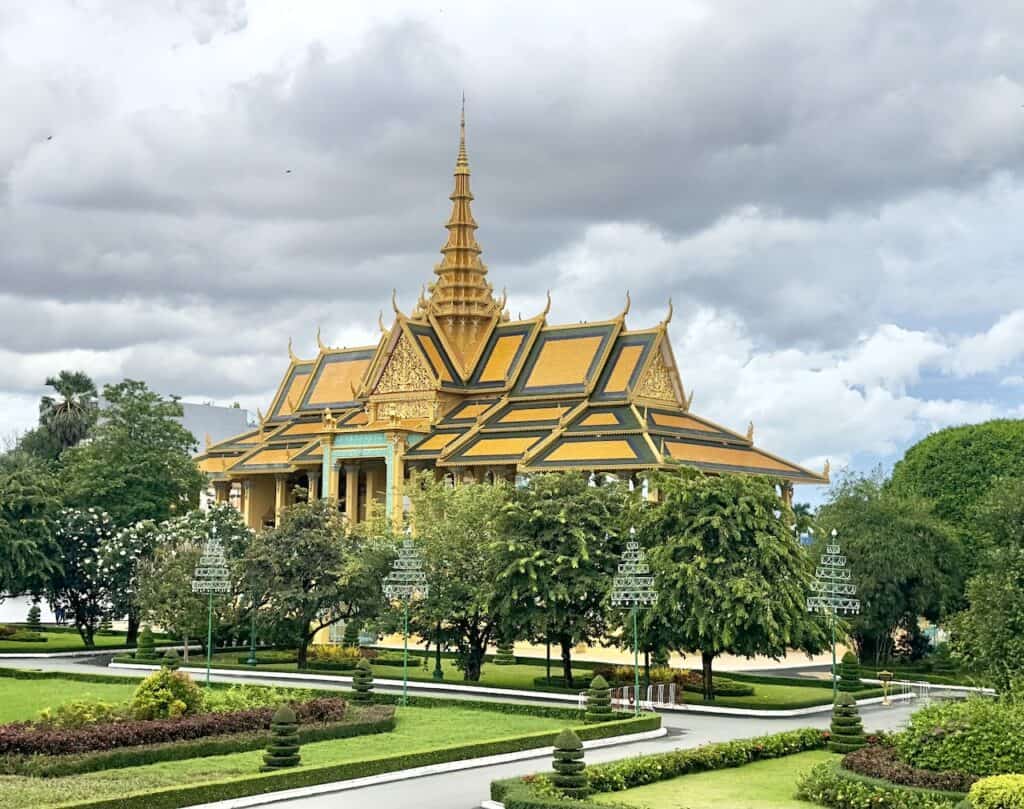
Visit Cambodia in February
Visiting Cambodia in February offers excellent weather and is particularly great for exploring temples, enjoying outdoor activities, and experiencing cultural events. However, keep in mind the potential for higher prices and tourist crowds. If you prefer quieter and more budget-friendly travel, you might consider visiting during the shoulder season, which is right before or after the peak tourist months.
Pros of Visiting Cambodia in February:
- Excellent Weather: February falls within the dry season in Cambodia, with daytime temperatures ranging from 25°C to 30°C (77°F to 86°F). This makes it an ideal time for outdoor activities and sightseeing.
- Ideal for Temple Exploration: The dry and cool weather is perfect for exploring the temples of Angkor, including the iconic Angkor Wat, without the discomfort of extreme heat. You can spend more time exploring the intricate details of these historic sites.
- Less Crowded Than December and January: While February is a popular month for tourists, it tends to be less crowded than December and January, which are peak tourist months.
Cons of Visiting Cambodia in February:
- Peak Tourist Season: While it’s less crowded than December and January, February is still considered part of the peak tourist season. Popular destinations like Siem Reap (home to Angkor Wat) and Phnom Penh can get crowded, and accommodations may be more expensive.
- Higher Prices: Due to the high demand from tourists, you may find that prices for accommodations, flights, and tours are relatively higher in February compared to other times of the year.
- Limited Availability: It’s advisable to book your accommodations and tours well in advance, as the most sought-after options can fill up quickly during February.
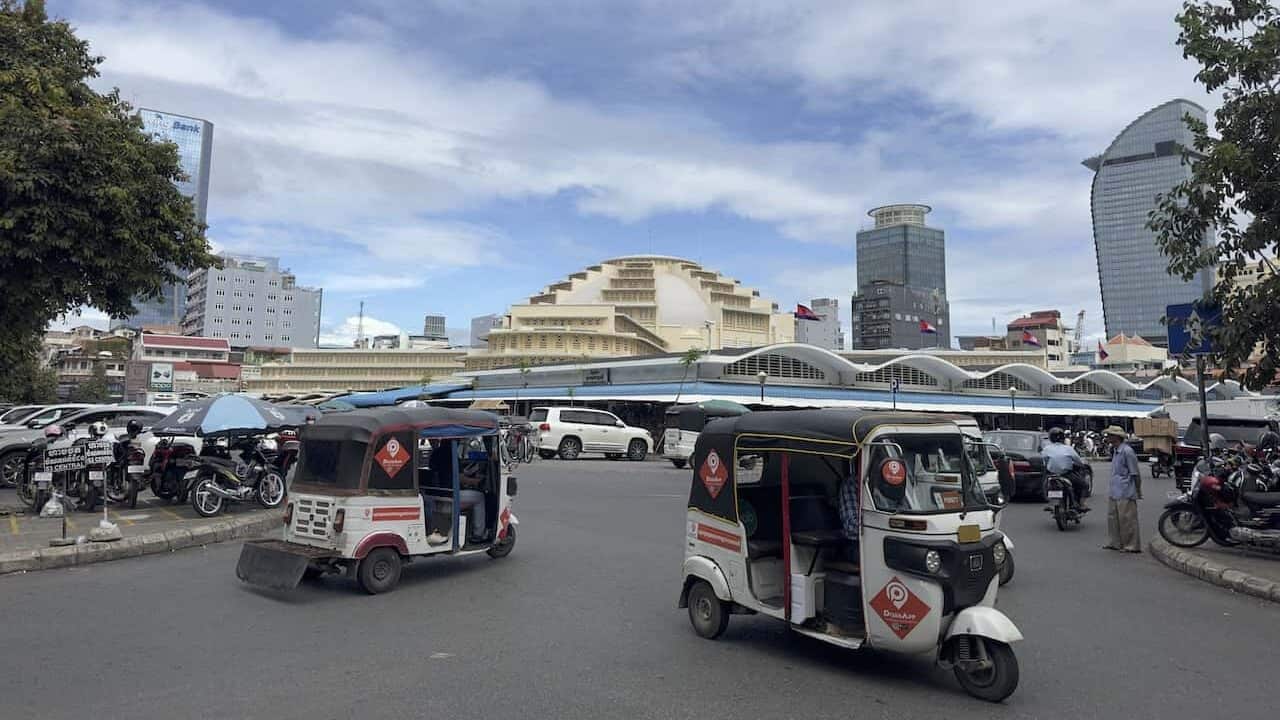
Visit Cambodia in March
Visiting Cambodia in March has its own set of advantages and disadvantages. Here’s a breakdown of the pros and cons:
Pros of Visiting Cambodia in March:
- Warm Weather: March in Cambodia is warm, with daytime temperatures typically ranging from 28°C to 35°C (82°F to 95°F). If you enjoy hot weather and sunny days, this can be a pro for you.
- Dry Conditions: March is still part of the dry season, which means you can expect minimal rainfall and dry conditions.
- Ideal for Beaches: If you plan to visit Cambodia’s coastal areas, such as Sihanoukville or nearby islands like Koh Rong, March offers ideal beach weather with plenty of sunshine and warm waters.
- Temple Exploration: The dry and warm weather is suitable for exploring the temples of Angkor, including Angkor Wat. You can spend extended periods exploring these historical sites without being bothered by rain.
- Cultural Festivals: Depending on the lunar calendar, the Khmer New Year often falls in April, but preparations and celebrations may start in March. This can provide a unique cultural experience.
Cons of Visiting Cambodia in March:
- Hot and Humid: While some travelers enjoy the warm weather, others may find the temperatures in Cambodia during March uncomfortably hot, especially if you’re not accustomed to high heat and humidity.
- Crowds: March is still a relatively busy tourist month, particularly in popular destinations like Siem Reap (Angkor Wat) and Phnom Penh. You may encounter larger crowds at popular tourist sites.
- Higher Prices: Due to the continued tourist demand, you might find that accommodations, flights, and tours are relatively more expensive in March compared to the shoulder or low seasons.
- Limited Availability: It’s a good idea to book your accommodations and tours in advance, as the most sought-after options can fill up quickly during this peak tourist period.
- Unpredictable Fire Season: In some areas of Cambodia, particularly in the countryside, March can be associated with agricultural burning and haze. This can impact air quality and visibility, although the severity varies from year to year.
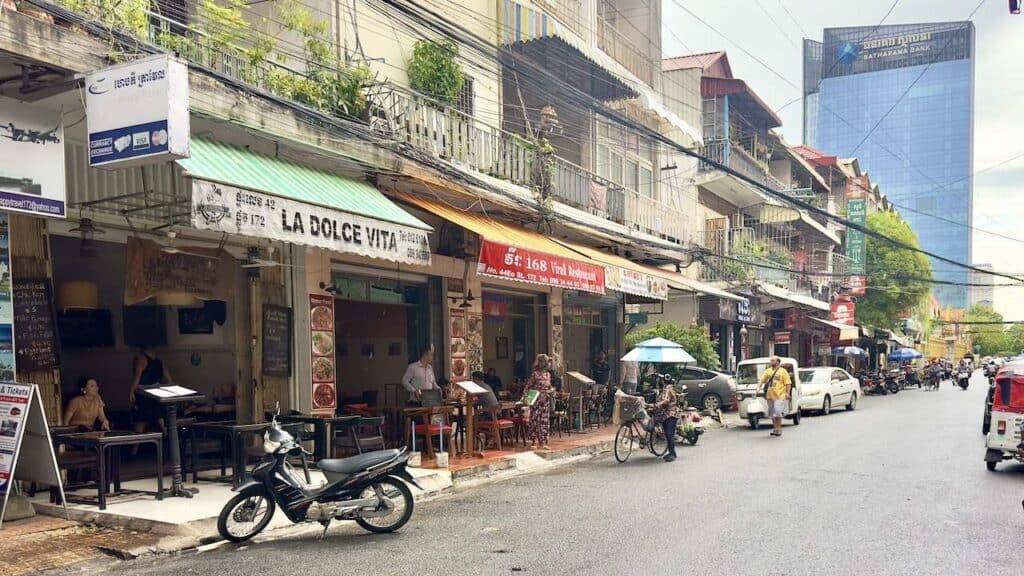
Visit Cambodia in April
Visiting Cambodia in April can be rewarding for those interested in experiencing Khmer New Year festivities, warm weather, and beach vacations. However, the extreme heat can be challenging for some travelers. If you can tolerate the heat and plan your activities accordingly, April can offer a unique cultural experience in Cambodia.
Pros of Visiting Cambodia in April:
- Cultural Festivals: April marks the beginning of the Khmer New Year, which is one of the most important festivals in Cambodia. The celebrations include traditional ceremonies, water splashing, and various cultural activities.
- Warm and Sunny Weather: April is characterized by warm and sunny weather, with daytime temperatures often ranging from 30°C to 35°C (86°F to 95°F). If you enjoy hot and tropical weather, this can be a pro.
- Ideal for Beaches: If you plan to visit Cambodia’s coastal areas, such as Sihanoukville, April offers excellent beach weather with plenty of sunshine and warm waters.
- Longer Daylight Hours: April has longer daylight hours, allowing you to make the most of your outdoor activities and sightseeing.
Cons of Visiting Cambodia in April:
- Extreme Heat: April is the hottest month in Cambodia, and temperatures can soar above 35°C (95°F) in many parts of the country. The high heat and humidity can be challenging for some travelers and may limit outdoor activities during the middle of the day.
- Dry Conditions: While April is part of the dry season, it’s also the end of the dry season. As a result, the landscape may become parched, and dust can be an issue, particularly in rural areas.
- Crowds: Due to the Khmer New Year celebrations and school holidays, Cambodia can be crowded with local tourists during this period. Popular tourist destinations, like Siem Reap (Angkor Wat), may have larger crowds.
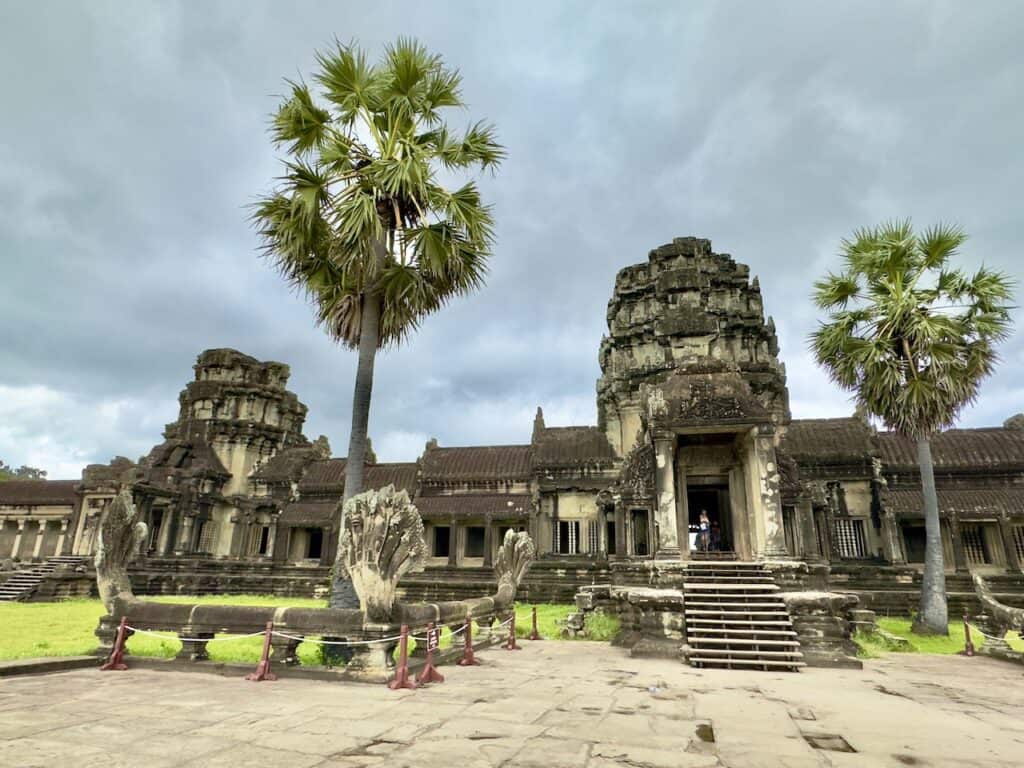
Visit Cambodia in May
Visiting Cambodia in May can be a budget-friendly option with fewer tourists, lush landscapes, and unique experiences. However, the rainy season can be a significant drawback, leading to disruptions in outdoor activities and humidity. If you don’t mind occasional rain and are looking for a quieter and more affordable travel experience, May might be a suitable time to visit.
Pros of Visiting Cambodia in May:
- Low Tourist Crowds: May is the beginning of the rainy season, and it’s considered the start of the shoulder or low tourist season. This means fewer crowds at popular tourist destinations like Angkor Wat, and lower prices for accommodations and tours.
- Lush Green Landscapes: The arrival of the rainy season means the Cambodian countryside is lush and green.
- Discounted Prices: Due to the lower tourist demand, you can often find discounted prices on accommodations and tour packages in May. This can make your trip more budget-friendly.
Cons of Visiting Cambodia in May:
- Rainy Season Begins: May marks the beginning of the wet season in Cambodia, and rainfall becomes more frequent. Expect daily afternoon downpours, which can sometimes be heavy and last for a few hours. This can disrupt outdoor activities and sightseeing.
- High Humidity: The rainy season brings higher humidity levels, making it feel muggy and uncomfortable, especially when it’s not raining.
- Mosquitoes and Insects: The wet season can bring an increase in mosquitoes and other insects, so it’s important to take precautions against insect bites.
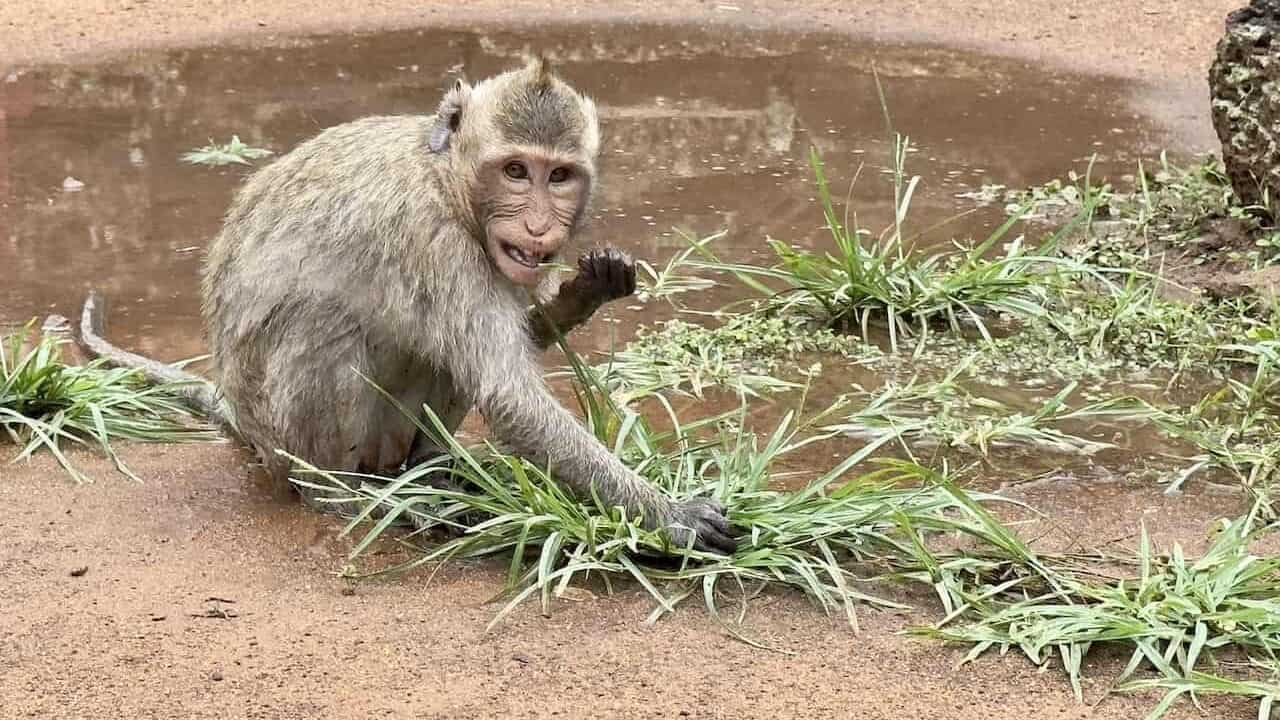
Visit Cambodia in June
Visiting Cambodia in June can offer budget-friendly travel with fewer tourists and lush landscapes. However, the rainy season can be a significant drawback, leading to disruptions in outdoor activities, transportation delays, and discomfort due to humidity. If you’re willing to embrace the rainy season experience and don’t mind occasional rain, June can provide a unique and quieter perspective of Cambodia.
Pros of Visiting Cambodia in June:
- Low Tourist Crowds: June is part of the rainy season, which is considered the low tourist season in Cambodia. This means fewer tourists at popular attractions like Angkor Wat and reduced prices for accommodations and tours.
- Lush Landscapes: The rainy season transforms Cambodia into a lush and vibrant green landscape. If you appreciate lush, tropical scenery, this can be a beautiful time to visit.
- Budget-Friendly Travel: Due to reduced demand, you can often find lower prices for accommodations and tour packages in June, making it a more budget-friendly time to visit.
Cons of Visiting Cambodia in June:
- Rainy Season: June falls within the rainy season in Cambodia, and you can expect daily afternoon downpours, which can be heavy and last for a few hours. This can disrupt outdoor activities, sightseeing, and transportation.
- High Humidity: The rainy season is associated with higher humidity levels, which can make the weather feel muggy and uncomfortable, especially when it’s not raining.
- Mosquitoes and Insects: The wet season often brings an increase in mosquitoes and other insects, so you should take precautions against insect bites.
- Limited Beach Time: Coastal areas like Sihanoukville may not be ideal for beach activities due to the unpredictable weather during the rainy season.
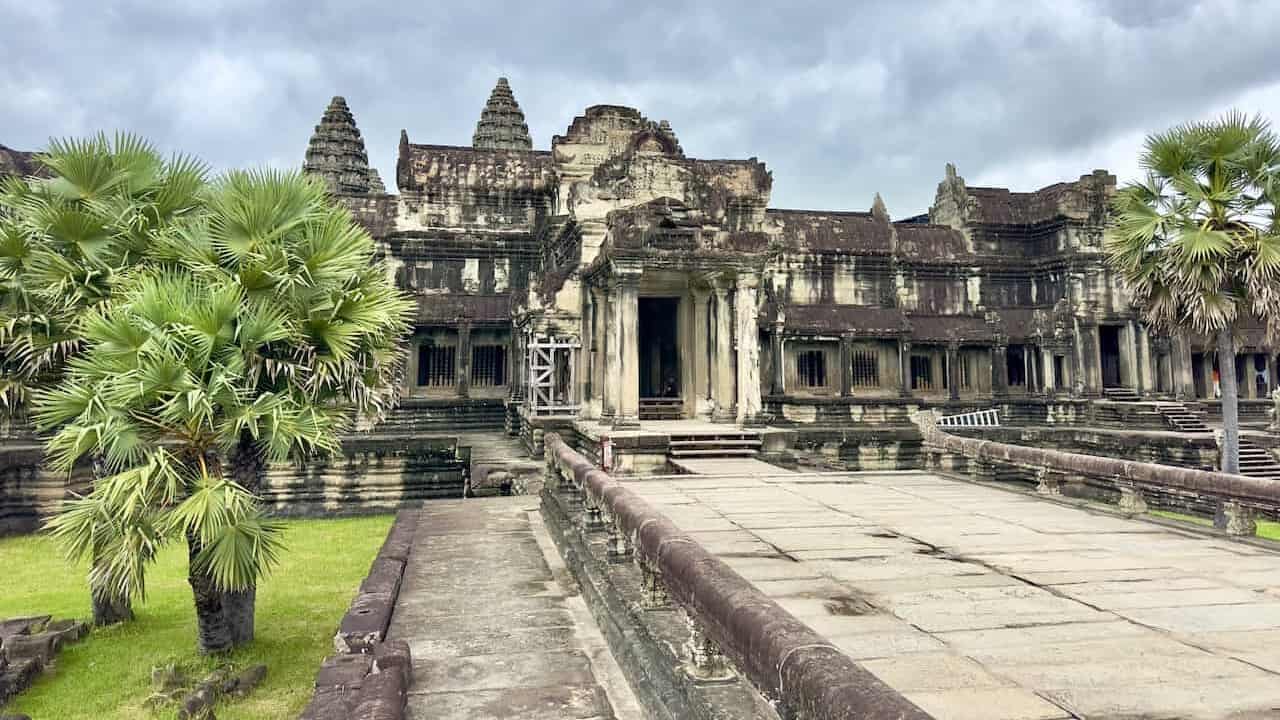
Visit Cambodia in July
Visiting Cambodia in July can offer budget-friendly travel with fewer tourists and lush landscapes. However, the rainy season can be a significant drawback, leading to disruptions in outdoor activities, transportation delays, and discomfort due to humidity.
Pros of Visiting Cambodia in July:
- Small Crowds: July is part of the rainy season, which is considered the low tourist season in Cambodia. This means fewer tourists at popular attractions like Angkor Wat, allowing for a quieter and more peaceful experience.
- Budget-Friendly Travel: Due to reduced demand, you can often find lower prices for accommodations and tour packages in July, making it a more budget-friendly time to visit.
Cons of Visiting Cambodia in July:
- Rainy Season: July falls within the rainy season in Cambodia, and you can expect daily afternoon downpours, which can be heavy and last for a few hours. This can disrupt outdoor activities, sightseeing, and transportation.
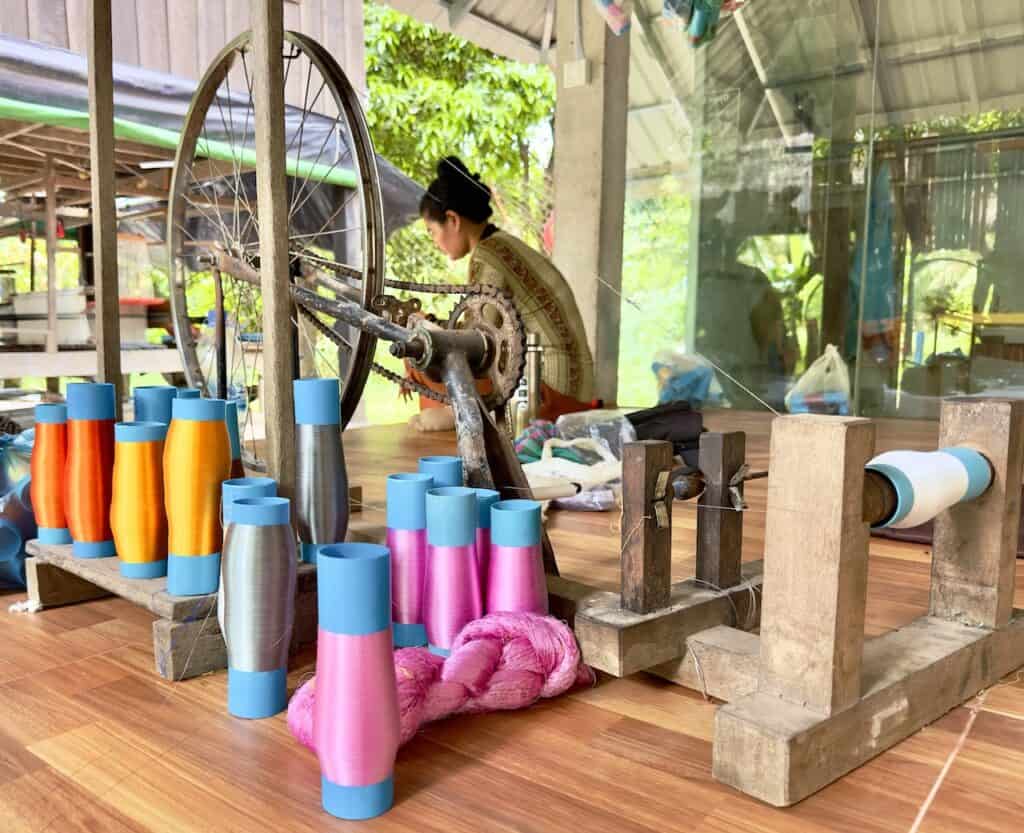
Visit Cambodia in August
Visiting Cambodia in August can offer budget-friendly travel with fewer tourists and lush landscapes. If you’re willing to embrace the rainy season experience and don’t mind the humidity, August can provide a unique and quieter perspective of Cambodia.
Pros of Visiting Cambodia in August:
- Low Tourist Crowds: August is part of the rainy season, which is considered the low tourist season in Cambodia. This means fewer tourists at popular attractions like Angkor Wat, allowing for a quieter and more peaceful experience.
- Budget-Friendly Travel: Due to reduced demand, you can often find lower prices for accommodations and tour packages in August, making it a more budget-friendly time to visit.
Cons of Visiting Cambodia in August:
- Rainy Season: August falls within the rainy season in Cambodia, and you can expect daily afternoon downpours, which can be heavy and last for a few hours. This can disrupt outdoor activities, sightseeing, and transportation.
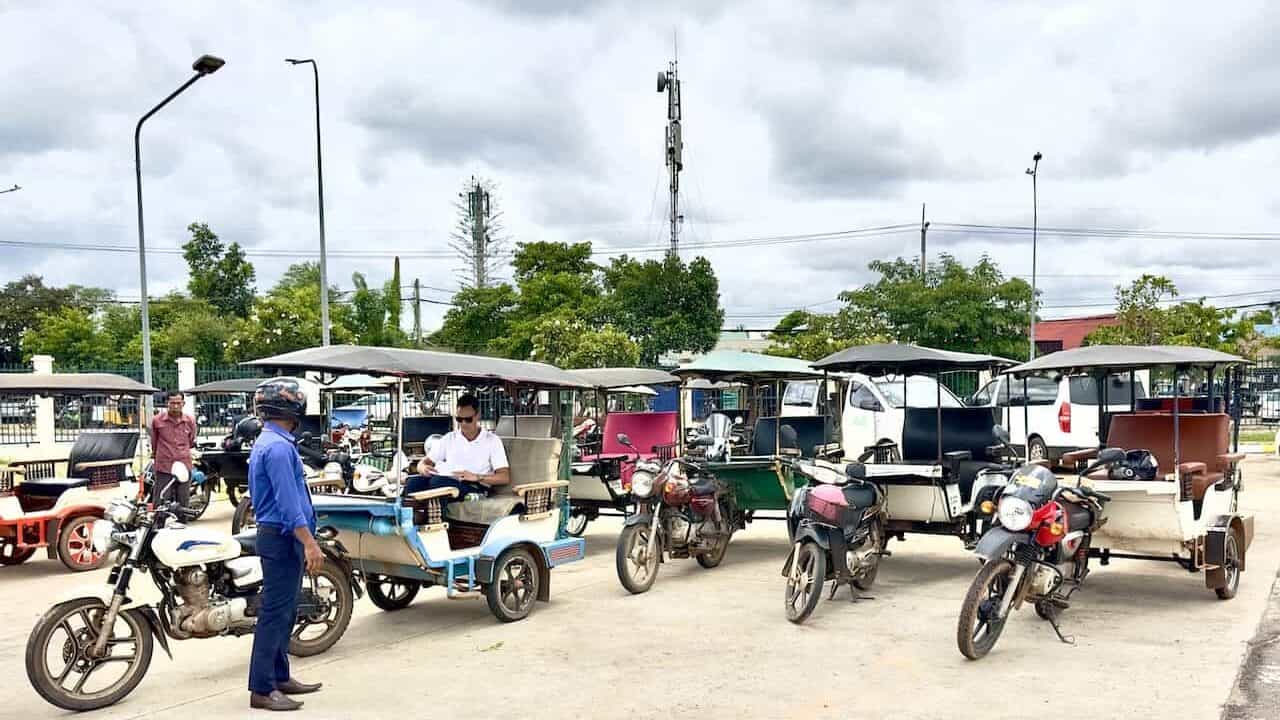
Visit Cambodia in September
Visiting Cambodia in September can offer budget-friendly travel with fewer tourists and lush landscapes. However, afternoon showers persist and the humidity lingers in September.
Pros of Visiting Cambodia in September:
- Few Tourists: September is part of the rainy season in Cambodia, which means lower tourist crowds compared to the peak season. This can provide a quieter and more peaceful travel experience.
- Lush Green Landscapes: The rainy season transforms Cambodia into a lush and vibrant green landscape. If you appreciate lush, tropical scenery, this can be a beautiful time to visit.
- Budget-Friendly Travel: Due to reduced demand, you can often find lower prices for accommodations and tour packages in September, making it a more budget-friendly time to visit.
Cons of Visiting Cambodia in September:
- Rainy Season: September falls within the rainy season in Cambodia, and you can expect daily afternoon downpours, which can be heavy and last for a few hours. This can disrupt outdoor activities, sightseeing, and transportation.
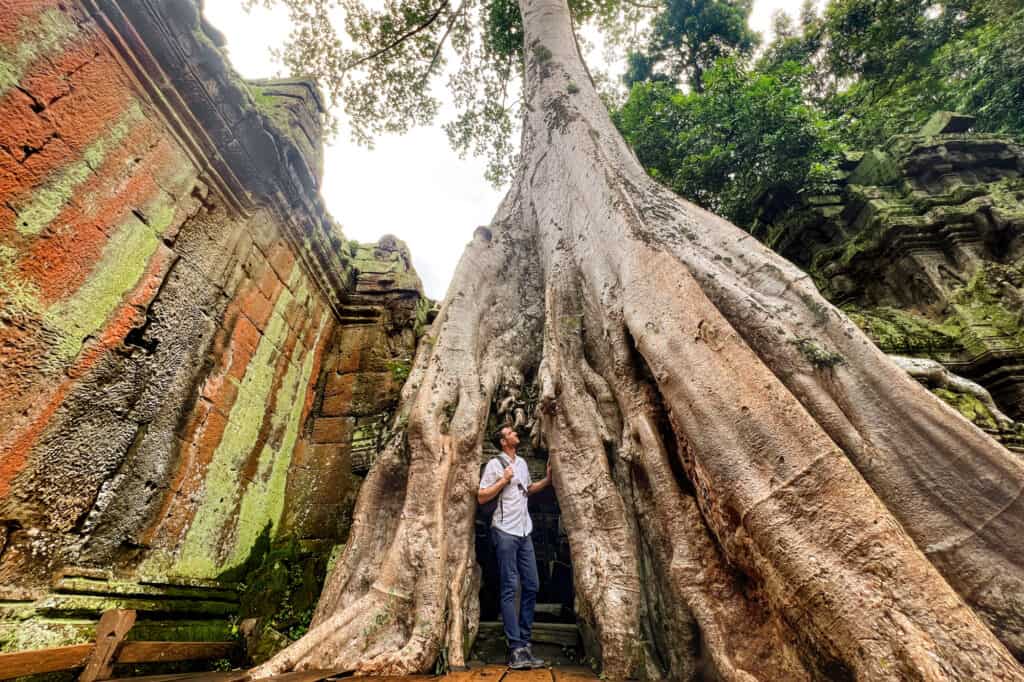
Visit Cambodia in October
October is a good option for a visit to Cambodia, but you should be prepared for occasional rain and some lingering humidity, especially early in the month. If you prefer fewer crowds and are willing to adapt to the unpredictable showers, October has its benefits.
Pros of Visiting Cambodia in October:
- Smaller Crowds: October is considered the shoulder season, falling between the rainy season and the dry season. Tourist crowds tend to be smaller compared to the peak season months, providing a more peaceful travel experience.
- Lush Landscapes: The end of the rainy season means Cambodia’s countryside is at its most vibrant and lush. If you appreciate lush, tropical scenery, October can be a beautiful time to visit.
- Budget-Friendly Travel: Due to reduced demand, you can often find lower prices for accommodations and tour packages in October compared to the peak tourist months.
- Comfortable Weather: October marks the transition from the rainy season to the dry season. While there may still be occasional rain, the weather becomes more comfortable, with decreasing humidity and cooler temperatures.
Cons of Visiting Cambodia in October:
- Rainfall: While October is transitioning to the dry season, there can still be occasional rain, especially early in the month. This can disrupt outdoor activities and sightseeing.
- Humidity: While humidity levels are decreasing, it can still feel somewhat humid in October, especially in the early part of the month.
- Unpredictable Weather: The weather can be somewhat unpredictable in October, with a mix of sunny days and occasional rain. This isn’t really a “con,” but something to keep in mind since it might impact outdoor activities. You can usually just expect some afternoon showers.
- Beach Conditions: Coastal areas like Sihanoukville may not be ideal for beach activities, as the water can still be affected by the earlier rainy season.
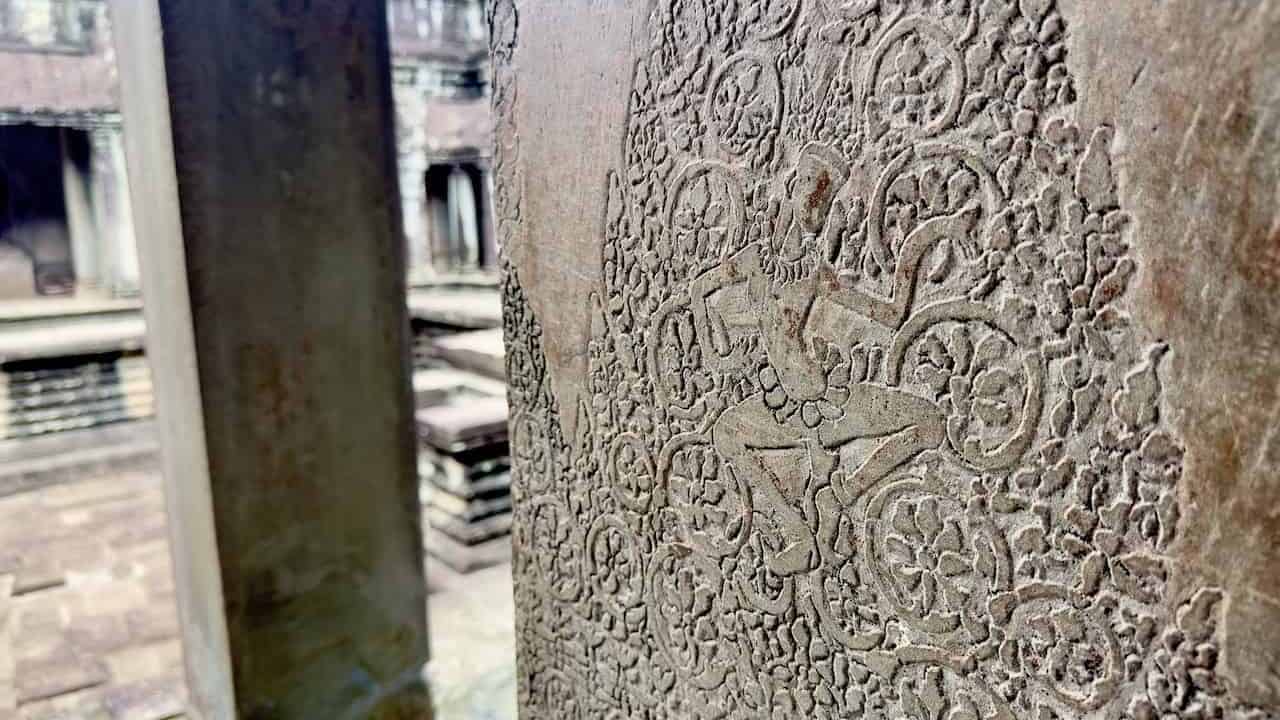
Visit Cambodia in November
Cambodia in November offers excellent weather, making it one of the best times to explore the country comfortably. It’s a great time for outdoor activities, cultural events, and experiencing the beauty of Cambodia’s historic sites. Just be prepared for higher prices and larger tourist crowds.
Pros of Visiting Cambodia in November:
- Ideal Weather: November marks the beginning of the dry season in Cambodia, and the weather is typically excellent. You can expect pleasant temperatures with daytime highs ranging from 77°F to 86°F, lower humidity, and plenty of sunshine.
- Great for Outdoor Activities: The comfortable weather in November is perfect for exploring outdoor attractions, such as the temples of Angkor, without the discomfort of extreme heat or heavy rain.
- Clear Skies: November typically brings clear skies and good visibility, making it an ideal time for photography and outdoor experiences.
- Lower Rainfall: While November is still transitioning from the rainy season, the amount of rainfall decreases significantly compared to the previous months.
- Festivals and Cultural Events: Depending on the lunar calendar, the Water Festival (Bon Om Touk) often takes place in November. This annual festival features boat races, illuminated processions, and various cultural activities.
- Moderate Tourist Crowds: While November is a popular time to visit Cambodia, especially Angkor Wat, tourist crowds are generally lower compared to the peak months of December and January.
Cons of Visiting Cambodia in November:
- Higher Prices: November falls within the peak tourist season, so prices for accommodations, flights, and tours may be relatively higher compared to the shoulder or low seasons.
- Popular Destinations Can Get Crowded: While it’s less crowded than December and January, November can still see moderate crowds, particularly at popular tourist destinations like Siem Reap (Angkor Wat).
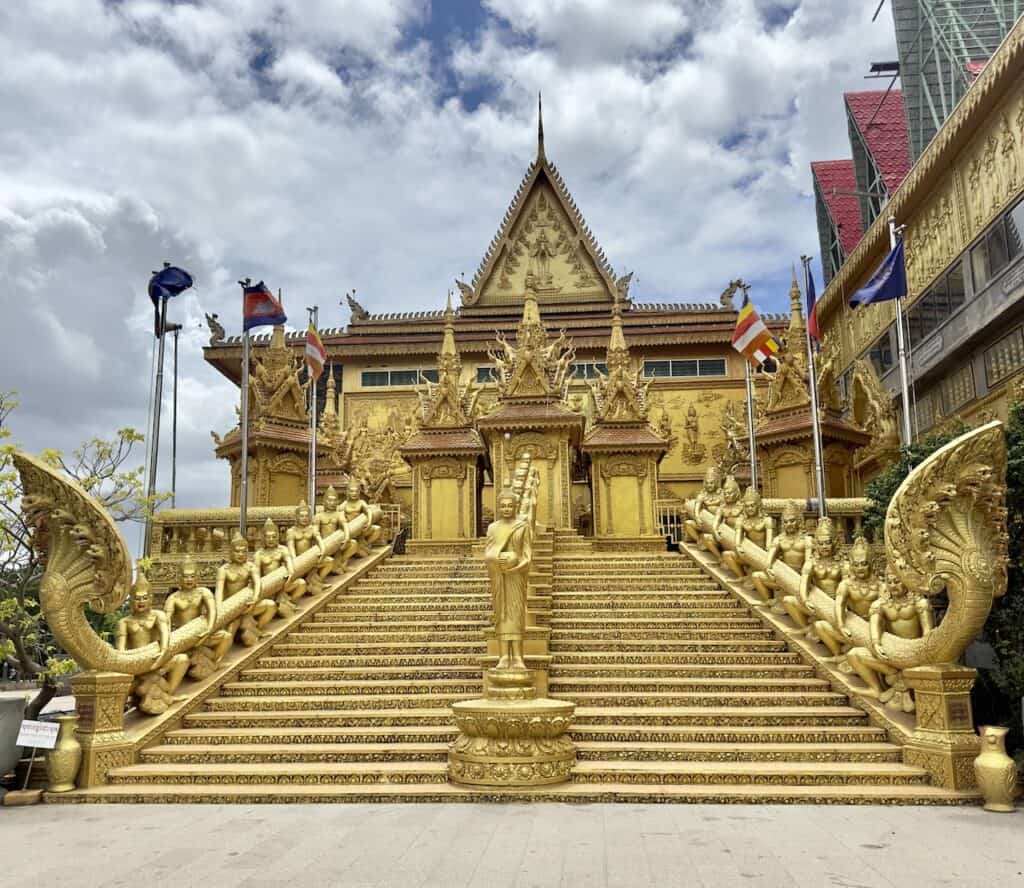
Visit Cambodia in December
December’s weather is usually great, making it a comfortable time for outdoor adventures and temple exploration. Just be prepared for larger crowds and higher prices, especially around Christmas and New Year’s.
Pros of Visiting Cambodia in December:
- Ideal Weather: December is considered one of the best times to visit Cambodia in terms of weather. It offers cool and dry conditions, with daytime temperatures ranging from 77°F to 86°F, making it comfortable for outdoor activities and sightseeing.
- Festive Atmosphere: Cambodia celebrates the Christmas and New Year holidays, and you can expect a festive atmosphere with decorations, special events, and cultural celebrations, especially in urban areas like Phnom Penh and Siem Reap.
- Great for Temple Exploration: The comfortable weather in December is perfect for exploring the temples of Angkor, including Angkor Wat. You can spend extended periods exploring these historical sites without the discomfort of extreme heat or rain.
- Low Humidity: Unlike the hot and humid months of the wet season, December offers lower humidity levels, ensuring a more comfortable and enjoyable travel experience.
Cons of Visiting Cambodia in December:
- Peak Tourist Season: December is part of the peak tourist season in Cambodia, especially around Christmas and New Year’s. Popular destinations like Angkor Wat and coastal areas can get crowded, and accommodations may be more expensive.
- Higher Prices: Due to the high demand from tourists, you may find that prices for accommodations, flights, and tours are relatively higher in December compared to other times of the year.
- Limited Availability: It’s advisable to book your accommodations and tours well in advance, as the most sought-after options can fill up quickly during December.
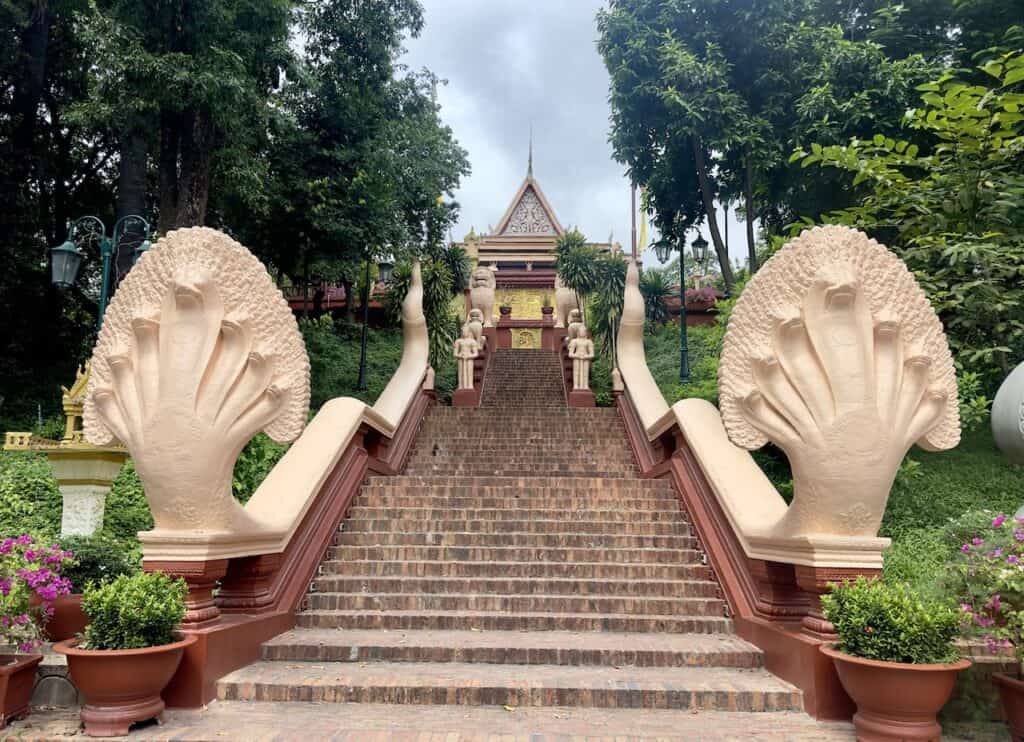
FAQs on a Trip to Cambodia
Let’s answer a few final frequently asked questions about traveling to Cambodia.
What currency is accepted in Cambodia?
The US Dollar is widely accepted and appreciated in Cambodia, whether you’re tipping, paying a tuk-tuk driver, or hiring a tour guide.
Bring small denominations (lots of $1s, $5s, and $10s).
Are tuk-tuks a good way to get around Cambodia?
Yes, tuk-tuks are a safe and efficient way to get around the cities of Cambodia. From the moment you walk out of the airport, you’ll see tuk-tuk drivers offering to give you a lift.
Negotiate your price ahead of time. A typical ride from the airport to the palace area hotels will be $10 USD.
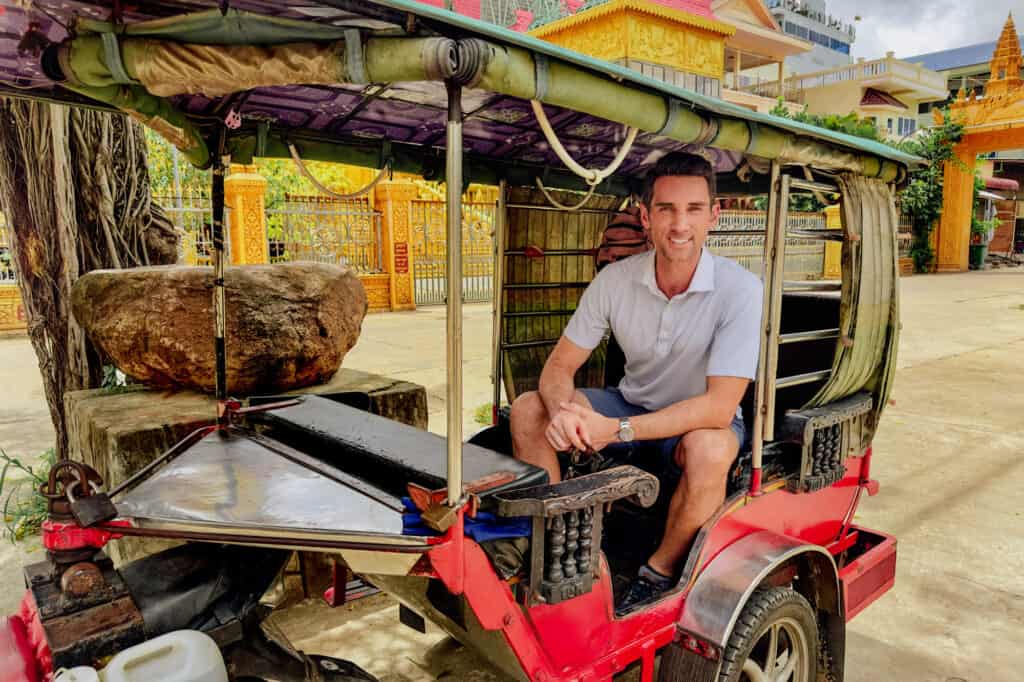
How many days do you need in Phnom Penh?
You can see most of the main sites in Phnom Penh in a single day. From the Royal Palace to the Central Market to the Wat Phnom Temple, you can pack a lot into 24 hours in the city before moving on.
How many days do you need at Siem Reap?
I’d say you need a few days in Siem Reap to truly see all of the temples and other sites around the city.
Is a Mekong River cruise from Cambodia worth it?
A Mekong River cruise is an unforgettable trip through Cambodia and Vietnam. While Siem Reap isn’t on the Mekong, Heritage Line and other companies allow their guests to fly there, spend a few days, and then join the riverboat a few hours away. Other stops include Phnom Penh and a variety of local villages on the Mekong as you make your way down to Ho Chi Minh City, Vietnam.
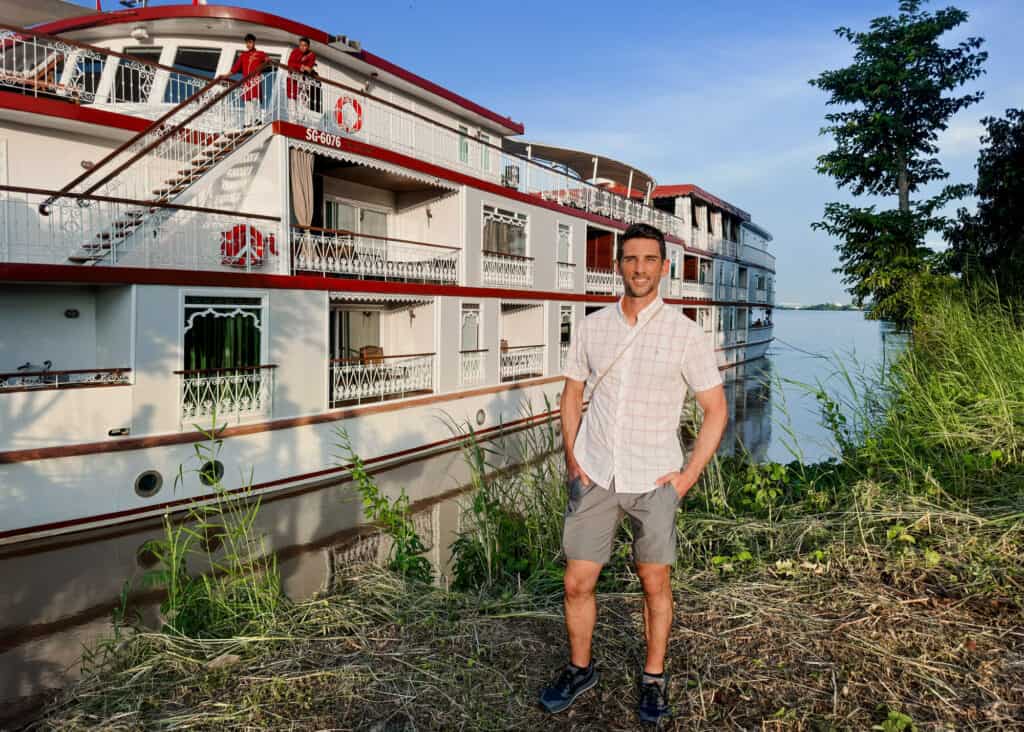
Wrap: The Best Time to Visit Cambodia
In summary, the best time to visit Cambodia for most travelers is during the dry season, from November to February, when the weather is pleasant and ideal for exploring temples and outdoor activities. However, if you prefer fewer crowds and don’t mind occasional rain, the transition period (September to October) can also be a good choice. Be prepared for the heat if you visit during the hot season (March to May), and consider the wet season (June to August) if you want to experience Cambodia in a different light with lush landscapes and lower prices.
Check out our other posts on Cambodia and Southeast Asia!
The Best Time to Visit Vietnam
Mekong river cruises, tan chau, vietnam, au lac charner hotel: saigon, 24 hours in ho chi minh city, the lotus lounge at sgn, phnom penh to siem reap, cambodia, siem reap airport, one day in phnom penh, cambodia.
Winter is here! Check out the winter wonderlands at these 5 amazing winter destinations in Montana
- Travel Destinations
The Best Time To Travel To Cambodia
Published: November 18, 2023
Modified: December 28, 2023
by Almeda Obryan
- Plan Your Trip
- Travel Tips
Introduction
Located in Southeast Asia, Cambodia is a captivating destination known for its rich history, stunning landscapes, and warm hospitality. From the ancient temples of Angkor Wat to the bustling markets of Phnom Penh, this country offers a wealth of experiences for travelers seeking adventure, cultural immersion, and relaxation.
When planning a trip to Cambodia, one of the key factors to consider is the timing of your visit. Understanding the climate and seasonal dynamics can greatly enhance your travel experience. In this article, we’ll explore the best time to travel to Cambodia, taking into account factors such as weather, peak and off-peak seasons, festivals, and costs.
Cambodia experiences a tropical monsoon climate, characterized by two distinct seasons: the dry season and the wet season. The dry season, which runs from November to April, is generally considered the best time to visit. During this period, temperatures are pleasant, rainfall is minimal, and there’s an abundance of sunshine, making it ideal for outdoor activities and sightseeing.
The wet season, which lasts from May to October, is characterized by heavy rainfall, particularly in the afternoons and evenings. While the wet season may deter some travelers, it also has its advantages. The lush green landscapes, reduced tourist crowds, and lower accommodation rates make it an appealing choice for budget-conscious or adventurous travelers.
When it comes to the peak season in Cambodia, the months of November to February are the most popular. This is because the weather is dry and mild, with temperatures averaging around 25-30 degrees Celsius (77-86 degrees Fahrenheit). Many travelers flock to Cambodia during this time, so be prepared for larger crowds at popular tourist sites such as Angkor Wat and Sihanoukville.
The off-peak season, on the other hand, spans from May to September. While the wet season may deter some visitors, it can be a great time to explore Cambodia with fewer tourists. The landscapes are lush and vibrant, and you’ll have more flexibility in terms of accommodation options and negotiating better rates.
Climate in Cambodia
Cambodia experiences a tropical monsoon climate, characterized by two distinct seasons: the dry season and the wet season. Understanding the climate patterns can help you choose the best time to visit based on your preferences and desired activities.
The dry season in Cambodia typically starts in November and lasts until April. During this time, the weather is generally dry, with low humidity and plenty of sunshine. The temperatures are also more moderate, ranging from 25 to 30 degrees Celsius (77 to 86 degrees Fahrenheit). This makes it the ideal time for outdoor activities and exploring Cambodia’s famous landmarks, such as the majestic temples of Angkor Wat.
On the other hand, the wet season in Cambodia runs from May to October. It is characterized by high humidity and frequent rainfall, with the heaviest showers occurring between June and September. The temperatures during this season can still be relatively high, ranging from 25 to 35 degrees Celsius (77 to 95 degrees Fahrenheit). While the wet season may not be ideal for certain outdoor activities, it offers its own unique charm. The countryside becomes lush and vibrant, and the waterfalls and rivers are at their fullest.
It’s worth noting that the weather patterns can vary across different regions of Cambodia. Coastal areas, such as Sihanoukville and Koh Rong, tend to receive more rainfall throughout the year. In contrast, the northeastern regions, such as Mondulkiri and Ratanakiri, experience cooler temperatures due to their higher elevations.
It’s important to pack appropriate clothing for the climate when visiting Cambodia. In the dry season, lightweight and breathable clothing, along with a hat and sunscreen, are essential to protect yourself from the sun. In the wet season, it’s advisable to carry a lightweight raincoat or umbrella, as well as quick-drying clothing that can handle the occasional downpour.
Regardless of the season, it’s always a good idea to check the weather forecast before your trip. This will help you plan your activities accordingly and make the most of your time in Cambodia.
Peak Season
The peak season in Cambodia is from November to February, during the dry season. This is when the weather is typically at its best, with mild temperatures and little rainfall. It’s no surprise that this period attracts the most tourists, so be prepared for larger crowds at popular tourist sites.
One of the main draws of visiting Cambodia during the peak season is the favorable weather conditions. With temperatures averaging around 25-30 degrees Celsius (77-86 degrees Fahrenheit), it’s comfortable to explore the country’s iconic landmarks, such as the awe-inspiring temples of Angkor Wat. The dry and mild weather also allows for enjoyable outdoor activities, such as boat trips on the Tonle Sap Lake or relaxing on the stunning beaches of Sihanoukville.
Another advantage of traveling during the peak season is that most businesses, including restaurants, accommodation, and tour operators, are fully operational. This means that you’ll have a wide range of options to choose from and can easily make bookings in advance. However, it’s still advisable to make reservations for popular attractions and accommodations, especially if you have specific dates or preferences.
Keep in mind that the peak season also comes with higher prices. As demand increases, accommodation rates tend to rise, and popular tourist sites may have entrance fees. It’s important to budget accordingly and book in advance to secure the best deals.
If you’re planning to visit Cambodia during the peak season, it’s recommended to plan your itinerary carefully and consider visiting popular attractions early in the day or during off-peak hours to avoid large crowds. You can also explore lesser-known sites or off-the-beaten-path destinations to have a more intimate experience.
Overall, the peak season in Cambodia offers the best weather conditions for sightseeing and outdoor activities. It’s a vibrant time to explore the country’s rich culture, history, and natural beauty. Just be prepared for larger crowds and higher prices, and plan ahead to make the most of your visit.
Off-Peak Season
The off-peak season in Cambodia spans from May to September, during the wet season. While some travelers may be deterred by the prospect of rain, this time of year offers its own unique advantages and can be a great opportunity to experience Cambodia in a different light.
One of the main benefits of visiting Cambodia during the off-peak season is the reduced number of tourists. With fewer visitors compared to the peak season, you’ll have a chance to explore popular attractions, such as Angkor Wat or the Royal Palace, with more space and tranquility. This allows for a more intimate and immersive experience, as you can take your time to appreciate the intricate details and soak in the atmosphere.
Additionally, the off-peak season brings lush green landscapes and vibrant flora. Cambodia’s countryside comes alive during the wet season, with rice paddies turning a vibrant shade of green and waterfalls flowing at their fullest. The stunning natural beauty makes it an ideal time for nature lovers and photographers to capture Cambodia’s landscapes in all their glory.
Another advantage of traveling during the off-peak season is the potential for savings. As demand decreases, accommodations often offer lower rates, making it a more budget-friendly time to visit. You may also find better deals on flights and transportation, allowing you to make the most of your travel budget.
It’s important to note that while the off-peak season may have more rainfall, it doesn’t mean that it’s raining all the time. Rainfall typically occurs in short bursts, usually in the afternoon or evening, and leaves the rest of the day relatively dry. By planning your activities accordingly and taking advantage of the drier spells, you can still enjoy outdoor adventures and sightseeing.
When visiting Cambodia during the off-peak season, it’s advisable to pack lightweight rain gear, such as a raincoat or umbrella, as well as quick-drying clothing. These items will enable you to navigate the occasional downpours and continue exploring without much disruption.
Overall, the off-peak season in Cambodia offers a different perspective and unique experiences compared to the peak season. With fewer tourists, lush landscapes, and potential cost savings, it’s a great time to explore the country’s treasures at your own pace and immerse yourself in its natural beauty.
Festivals and Events
Cambodia is known for its vibrant and culturally significant festivals and events, which provide a glimpse into the country’s rich traditions and religious customs. Attending one of these celebrations can be a highlight of your trip to Cambodia, offering a deeper understanding of its culture and allowing you to witness the locals’ joyous and spirited celebrations.
One of the most important festivals in Cambodia is Khmer New Year, which falls in mid-April and marks the end of the harvest season. During this three-day celebration, locals partake in various activities, including bathing statues of Buddha, visiting pagodas, and engaging in traditional games and dance performances. The streets come alive with vibrant parades, music, and traditional costumes, providing a festive and lively atmosphere.
Another significant festival is the Water Festival, also known as Bon Om Touk, which takes place in November. This festival commemorates the end of the rainy season and the reversal of the flow of the Tonle Sap River. It features boat races, fireworks, and various cultural performances, attracting both locals and tourists from around the world.
For those interested in Buddhism, Vesak Bochea is a major religious event in Cambodia. Celebrated in May, this festival marks the birth, enlightenment, and passing of Buddha. Devotees gather at pagodas to offer prayers and participate in candlelit processions, creating a serene and spiritual atmosphere.
Other notable festivals in Cambodia include Pchum Ben, a two-week-long religious festival dedicated to honoring ancestors; the Royal Plowing Ceremony, which marks the beginning of the planting season; and the Cambodia International Film Festival, showcasing local and international films.
It’s worth checking the dates of these festivals and events before your trip to Cambodia, as they can greatly enrich your cultural experience. However, keep in mind that these celebrations may also attract larger crowds, so plan your accommodations and transportation accordingly.
Attending a festival or event in Cambodia allows you to immerse yourself in the country’s vibrant culture and witness traditional rituals and celebrations firsthand. It’s an opportunity to experience the warmth and hospitality of the Cambodian people and create lasting memories of your journey.
Accommodation and Costs
When it comes to accommodation in Cambodia, there are options available to suit every budget and preference. From budget guesthouses and mid-range hotels to luxurious resorts and boutique accommodations, you’ll find plenty of choices throughout the country.
In popular tourist destinations such as Siem Reap and Phnom Penh, there are numerous accommodation options catering to all price ranges. The peak season, from November to February, tends to attract higher prices, so it’s advisable to book in advance to secure better rates. During the off-peak season, from May to September, you may find more affordable deals and greater availability.
In terms of costs, Cambodia offers fantastic value for money compared to many other travel destinations. Budget travelers can find clean and comfortable guesthouses or hostels for as little as $10 to $20 per night. Mid-range hotels usually range from $30 to $80 per night, while the more luxurious resorts can range from $100 upwards.
When it comes to food and dining, Cambodia offers a wide range of culinary experiences at varying price points. Street food stalls and local markets are the perfect places to sample delicious Khmer dishes at incredibly affordable prices. These range from $1 to $5 per meal. In restaurants, you can expect to pay around $5 to $10 for a meal at a mid-range establishment, and upwards of $15 in more high-end establishments.
Transportation costs in Cambodia are generally reasonable. Tuk-tuks and motorbike taxis are popular modes of transportation for short distances within cities and towns, with fares ranging from $1 to $5 depending on the distance. Longer journeys can be undertaken by buses or shared taxis, with prices varying depending on the distance and comfort level.
Entrance fees to popular attractions in Cambodia can also affect your overall budget. The most well-known site, Angkor Wat, has an entrance fee of $37 for a single-day pass, $62 for a three-day pass, and $72 for a seven-day pass. Other attractions, such as the Royal Palace in Phnom Penh or the Bamboo Train in Battambang, have smaller entrance fees.
It’s important to note that prices and costs can vary depending on the location, season, and your bargaining skills. It’s always a good idea to have some local currency (Cambodian Riel) on hand, as many establishments prefer cash transactions.
Overall, Cambodia offers a range of accommodation options to suit different budgets, and the cost of living is generally affordable for travelers. By planning ahead, comparing prices, and being mindful of your spending, you can make the most of your budget and have a memorable experience in the Kingdom of Wonder.
Tips for Traveling to Cambodia
Traveling to Cambodia can be an exciting and memorable experience. To ensure a smooth and enjoyable trip, here are some essential tips to keep in mind:
- Obtain a valid visa: Most visitors to Cambodia need a visa to enter the country. You can obtain a visa on arrival at the airport or pre-arrange an e-visa to save time. Make sure to check the latest visa requirements before you travel.
- Dress respectfully: Cambodia is a predominantly Buddhist country, and it’s important to dress modestly, especially when visiting religious sites. Ensure your shoulders and knees are covered, and remove your shoes when entering temples or pagodas.
- Stay hydrated and use sunscreen: Cambodia’s climate can be hot and humid, so it’s essential to drink plenty of water and protect your skin from the sun. Carry a reusable water bottle and apply sunscreen regularly, especially if you’re spending time outdoors.
- Take precautions for your health: Make sure to consult with a healthcare professional about recommended vaccinations before traveling to Cambodia. It’s also advisable to carry insect repellent to protect against mosquito-borne diseases.
- Respect local customs and traditions: Cambodian people are known for their warmth and hospitality. Show respect for the local customs and traditions by greeting people with a polite “sok sabay” (hello) and by asking for permission before taking photographs of people.
- Be mindful of your belongings: Like any travel destination, it’s important to take precautions to protect your belongings. Keep your valuables secure, be aware of your surroundings, and use a money belt or a secure bag to prevent theft.
- Try the local cuisine: Cambodian cuisine is diverse and flavorful, with dishes such as amok curry and nom banh chok (Khmer noodles) being must-tries. Explore local markets and street food stalls to sample the delicious flavors of Khmer food.
- Learn a few basic Khmer phrases: While English is widely spoken in tourist areas, learning a few basic Khmer phrases can go a long way in connecting with the locals and showing respect for their culture. Simple greetings and phrases like “arkun” (thank you) are always appreciated.
- Practice responsible tourism: Be mindful of the environmental and social impact of your travels. Respect the local communities, culture, and traditions. Choose responsible tour operators and support eco-friendly initiatives to minimize your footprint and contribute positively to Cambodia.
By following these tips, you can ensure a memorable and rewarding experience during your trip to Cambodia. Embrace the rich culture, explore the historical sites, and embrace the warmth and hospitality of the Khmer people.
Cambodia is a captivating destination that offers a wealth of experiences for travelers. Whether you’re exploring the ancient temples of Angkor Wat, immersing yourself in the vibrant culture of Phnom Penh, or relaxing on the pristine beaches of Sihanoukville, Cambodia has something for everyone.
Understanding the best time to travel to Cambodia is crucial for a successful trip. The dry season, from November to April, offers pleasant weather and is ideal for outdoor activities. It’s considered the peak season, with increased tourist crowds and higher prices. On the other hand, the wet season, from May to October, brings lush landscapes, fewer tourists, and budget-friendly options.
Regardless of the season, Cambodia’s festivals and events add an extra layer of cultural richness to your journey. From the Khmer New Year celebrations to the Boat Racing Festival, these events offer a glimpse into the traditions and customs of the Cambodian people.
Accommodation options in Cambodia cater to various budgets, and the cost of living is generally affordable. From budget guesthouses to luxury resorts, you’ll find a range of choices to suit your preferences. It’s important to plan ahead, especially during the peak season, to secure the best rates.
When traveling to Cambodia, remember to be respectful of the local culture and traditions. Dress modestly when visiting religious sites, greet people with a friendly attitude, and take precautions for your health and safety.
In conclusion, Cambodia is a vibrant and charming destination that offers a blend of history, natural beauty, and warm hospitality. By understanding the climate dynamics, making informed choices about when to visit, and being mindful of the local customs, you can truly make the most of your journey through the Kingdom of Wonder.

- Privacy Overview
- Strictly Necessary Cookies
This website uses cookies so that we can provide you with the best user experience possible. Cookie information is stored in your browser and performs functions such as recognising you when you return to our website and helping our team to understand which sections of the website you find most interesting and useful.
Strictly Necessary Cookie should be enabled at all times so that we can save your preferences for cookie settings.
If you disable this cookie, we will not be able to save your preferences. This means that every time you visit this website you will need to enable or disable cookies again.

How to visit Cambodia
A ncient temples, toasty temperatures, delicious food and low hotel prices — these are some of the best parts of traveling to Cambodia.
Some Americans might view traveling to Asia as a daunting experience, but Cambodia is a great place to start. The exchange rates for the U.S. dollar is high, so your dollar carries you fairly far. And although the national currency is the Cambodian riel, the main currency that is exchanged is the U.S. dollar.
Siem Reap is a vibrant city where tourists are ubiquitous, so it’s easy to get around, and many people speak English. Tourism is a key part of the country’s economy, so the people are kind, open and welcoming to tourists. It also hosts Angkor Wat — “the world’s largest religious monument and a UNESCO World Heritage site,” per National Geographic .
Here are some of my best tips for visiting Cambodia.
1. Book hotels, flights well in advance to Cambodia
If you’re flying from the U.S., the plane ticket will likely be your most expensive item, so it helps to book early. The best time to visit to avoid the rainy season is between November and May. I went in March, and it was mostly sunny — with just a couple hours of rain my first day there.
Luxury hotels are shockingly affordable in Siem Reap — just do a little research on what you would like — and some even offer tours included in your stay. Depending on how much research and planning you want to do, it could be worth it.
Also, be sure to bring cash with you. There are automated teller machines in the airport and the city, if you need. Most transactions in shops and restaurants are done through cash, not card, and you will also need cash to tip service workers if you take a taxi or eat out.
2. Go early to visit Angkor Wat and the other Buddhist temples
One of the most iconic stops in Cambodia is the ancient temple of Angkor Wat.
According to National Geographic, the no longer active temple “attracts nearly 2.5 million foreign visitors annually.
Angkor Wat translates to “temple city” in the Khmer language and was built by Emperor Suryavarman II in the first half of the 12th century to be the state temple. It was “originally dedicated to the Hindu god Vishnu,” but by the end of the 12th century, it had been converted to a Buddhist temple.
If you can get to Angkor Wat early in the morning, that is ideal to avoid the crowds and somewhat beat the heat. To visit the temples, plan to wear pants and clothing that covers your shoulders — the religious beliefs of the region doesn’t allow female visitors to enter the temples if those body parts are not covered.
You can book a guided tour beforehand, but there are usually tour guides waiting outside the site who are willing to walk you through the entire site and explain the history. Our guide that we met in front of the temple was extremely knowledgeable about Cambodian history, had impeccable English, and he only charged $15 for all three of us. I highly recommend only going with a tour guide — it brings a much deeper meaning and richer understanding to the whole experience. And again, it’s helpful to have cash to also tip any tour guides you come across.
We met a taxi driver at the airport who offered to drive us to our hotel and to pick us up the next day to take us to the most iconic ancient sites, as well as to The Floating Villages. And he offered to take me and my two friends I was traveling with to those locations the following day in his taxi — all for just $45.
While you’re in Siem Reap, Angkor Wat isn’t the only mind-blowing historical site to see. Another key stop is Bayon — a temple consisting of 54 towers, with the main tower showcasing four faces that “are generally believed to be the four faces of King Jayavarman VII demonstrating the omnipresence of the king,” according to Visit Angkor .
There are also more than 11,000 carved figures on the outer gallery of the Buddhist Bayon temple that are a majestic window into the past.
3. Plan to stop at The Floating Villages on Tonle Lake
Most boat tours you can purchase will take you to the main temples, as well as one of the most fascinating places in Siem Reap — The Floating Villages on Tonle Lake.
It’s composed of four main villages where communities have created their homes, restaurants, businesses and schools on floating houses on the lake. The Insider’s Guide To Siem Reap recommends booking through Tara River Boat or Sam Veasna Conservation Tours to visit the unique and fascinating floating villages.
4. Try the street food in Cambodia AND reserve a fine dining experience
The street food in Cambodia is an experience that is really special and unique to Southeast Asia. And a lot of the food is truly delicious. I highly recommend getting a fruit shake ... or two!
Another thing I would recommend is seeking out a fine dining experience while you’re there — there are some truly talented chefs in Cambodia, and it’s an opportunity to experience fine dining at a more affordable price.
One that The New York Times recommends is Cuisine Wat Damnak, which offers “dishes from the longtime resident French chef Joannès Rivière’s kitchen (that) are firmly rooted in Cambodian flavors.” The tasting menus come down to just $28 for five or six courses.
Cambodia is a great place to relax with many spas and opportunities to get pedicures, manicures and massages at a more affordable price than what you would find in the U.S. Just make sure to tip well and show appreciation for the kind service workers offering the incredible services.


IMAGES
VIDEO
COMMENTS
The dry season runs from November to May, and the "cool season" months of November to February are the most popular time to visit Cambodia due to milder temperatures. The countryside appears somewhat parched from February to May when daytime temperatures can soar above 40°C (104°F ). The wet season usually runs from June to October ...
Galyna Andrushko/Shutterstock. The best time to visit Cambodia is during the dry season, which runs from November to April. During this time, the country sees average temperatures in November, fluctuating between 85°F and 72°F. November is the coldest month of the year, if we can ever refer to such temperatures as cold at all.
Month-by-Month Weather Breakdown. January: Average temperature ranges from 21°C to 31°C (70°F to 88°F). January marks the dry season in Cambodia, with pleasant and warm weather. Visitors can explore the ancient temples of Angkor without the crowds and enjoy outdoor activities like boat trips on the Tonle Sap Lake.
Most tourists visit Cambodia between November and March. Usually the hottest month is April and the coolest is November. October has the highest average precipitation, while January is driest. The average temperature fluctuates between 20 and 30 ℃ (68 and 80 ℉). Record lows and highs rarely exceed 20 or 30 ℃ (68 or 80 ℉), respectively.
January. The fact that November to January is classed as Cambodia's high season suggests January is traditionally one of the best months to visit the country. Temperatures are cool and the dry season is in full swing, meaning the weather is at its peak. However, this comes coupled with crowds as January is one of the busiest months, so ...
Cruises. Best time to visit. The best time to visit Cambodia is between November and April, when there is very little rain. During this time you'll see clear blue skies, making it a great time to enjoy a relaxing getaway on the southern coast. Temperatures stay at a warm 68°F year-round. Between May and October, humidity increases and the ...
Planning Your Trip. Best Time to Visit: Schedule your visit to Cambodia during the dry season from late November to early April. The cooler weather and lack of mud make a visit to the Angkor temples perfectly pleasurable, and avoids the monsoon season's floods. Language: Over 90 percent of the local population speak the Khmer language.
The best time to visit Cambodia is between November and May, when the country experiences low rainfall and still enjoys warm temperatures. However, the climate in Cambodia is generally hot and humid all throughout the year. Generally, any time of the year is a good time to travel in Cambodia, with each season having its advantages. The climate ...
Bridge at the entrance of Angkor Thom. The best time to visit Cambodia is between November and April, when it sees very little rain. During this time you'll see clear blue skies making it a great time to enjoy a relaxing getaway on the southern coast. Outside of this period, humidity increases and the rains come, assisting Cambodian farmers ...
The cool season between November and February has the best weather in Cambodia, with especially ideal weather between December and January. This is the best time to go to Cambodia weather-wise, but the drawback comes from the huge mobs of tourists. At this time the averages are between 70-86℉ (21-30℃).
The best time to visit Cambodia is during dry season, which runs from October to April. The wet season runs from May until September, with the heaviest rainfall generally in August & September. Average temperatures range from 24°C in the cooler months of October, November & December to 35°C at the hottest time of the year from March until June.
Winter (December through February) Weather is perfect this time of year in Cambodia to be enjoyable for warm weather travelers. The average high during this season is between 92.9°F (33.8°C) and 86.1°F (30.1°C). On average, it rains or snows a insignificant amount: consistently 0 times per month.
The average temperature is around 80ºF. There are two seasons, the humid and rainy monsoon season which spans from June to October, and the dry season which is from November to May. The coolest months for our Cambodia tours, Mekong river cruises and Angkor Wat tours, considered some of the best things to do in Cambodia, tend to be from ...
The best time to visit Cambodia is from October to April. This overlaps with the high season and when Cambodia's climate is at its most pleasant, with cool days. Despite this, the country is eminently visitable year-round and each month presents exciting opportunities to get involved in a range of activities, from island hopping to wildlife ...
The best time to visit Cambodia is during the dry season from November to March, which promises clear skies and coolest temperatures of 30°C (86°F). To avoid the peak season crowds opt for the shoulder season months; May or October, or the wet season from June to September if you don't mind some rain. Cambodia really is lovely year round ...
In Cambodia, the weather has a significant impact on travel. It has two main seasons: dry and wet. The dry season goes from November to April, while the wet season lasts from May to October. The dry season is cooler and less humid, which many tourists like. The best time to visit is during the peak of the dry season, around December and January.
Cambodia in August. If you are a wildlife enthusiast, August is the best time to visit Cambodia. Rainfall is more intense this time, but instead of an all-day downpour, it continues only for an hour or so. The temperature is soothing as it remains within the range of 26-27°C.
November to February (Dry Season): Winter Weather: This is considered the best time to visit Cambodia as the weather is cool and dry. Daytime temperatures range from 25°C to 30°C (77°F to 86°F). Winter Highlights: Ideal for exploring temples like Angkor Wat, and enjoying the beaches in Sihanoukville and nearby islands.
Cambodia experiences a tropical monsoon climate, characterized by two distinct seasons: the dry season and the wet season. Understanding the climate patterns can help you choose the best time to visit based on your preferences and desired activities. The dry season in Cambodia typically starts in November and lasts until April.
Streets of Phnom Penh. Dry Season (November - April): Clear skies, warm temperatures (averaging 25-30°C / 77-86°F), and low humidity provide ideal conditions for sightseeing. If you want picture-perfect weather, this is the prime time to visit. Wet Season (May - October): This brings monsoon rains, particularly heavy in August and September.
The best time to visit to avoid the rainy season is between November and May. I went in March, and it was mostly sunny — with just a couple hours of rain my first day there.